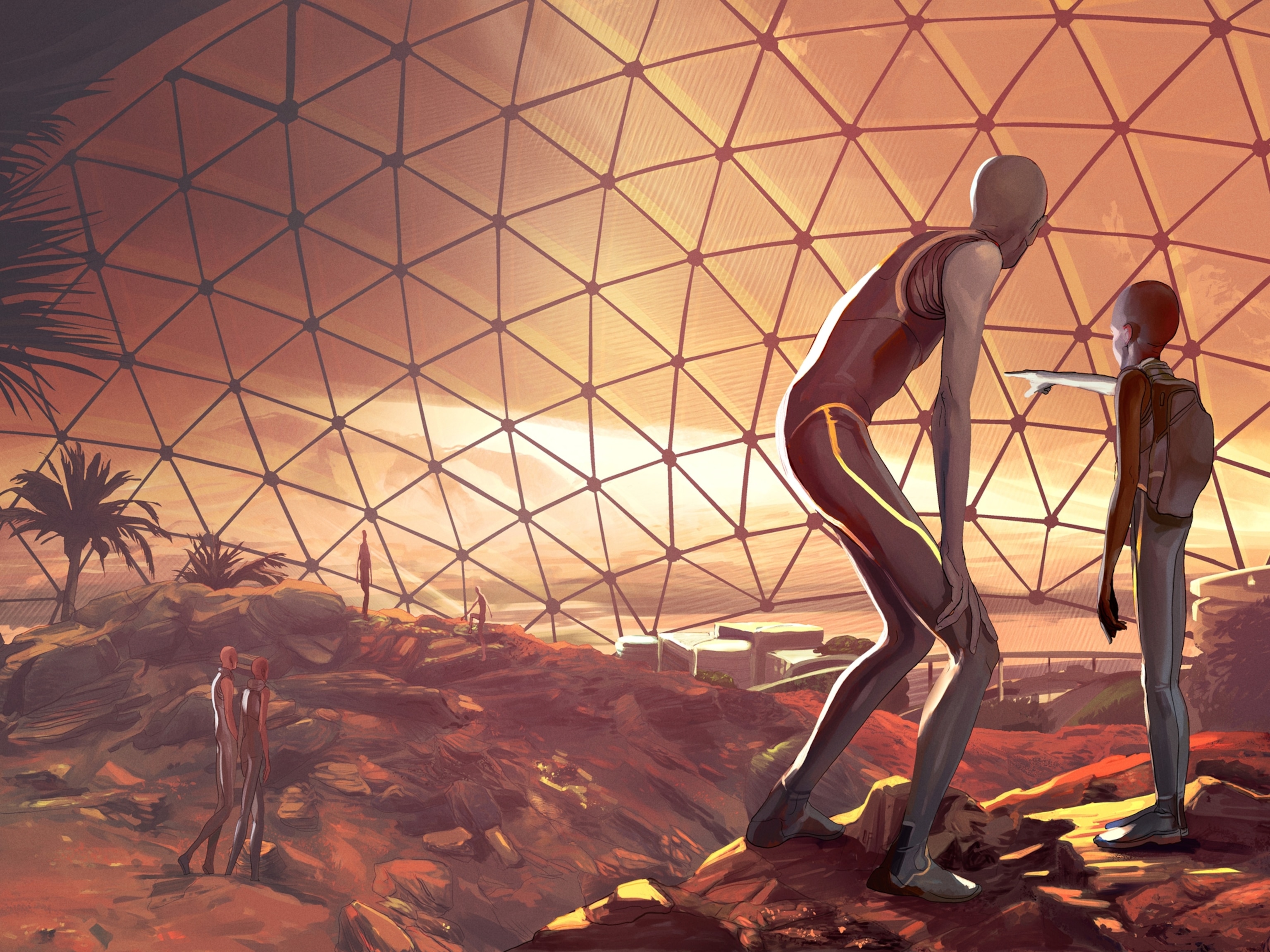

The future of spaceflight—from orbital vacations to humans on Mars
NASA aims to travel to the moon again—and beyond. Here’s a look at the 21st-century race to send humans into space.
Welcome to the 21st-century space race, one that could potentially lead to 10-minute space vacations, orbiting space hotels , and humans on Mars. Now, instead of warring superpowers battling for dominance in orbit, private companies are competing to make space travel easier and more affordable. This year, SpaceX achieved a major milestone— launching humans to the International Space Station (ISS) from the United States —but additional goalposts are on the star-studded horizon.
Private spaceflight
Private spaceflight is not a new concept . In the United States, commercial companies played a role in the aerospace industry right from the start: Since the 1960s, NASA has relied on private contractors to build spacecraft for every major human spaceflight program, starting with Project Mercury and continuing until the present.
Today, NASA’s Commercial Crew Program is expanding on the agency’s relationship with private companies. Through it, NASA is relying on SpaceX and Boeing to build spacecraft capable of carrying humans into orbit. Once those vehicles are built, both companies retain ownership and control of the craft, and NASA can send astronauts into space for a fraction of the cost of a seat on Russia’s Soyuz spacecraft.
SpaceX, which established a new paradigm by developing reusable rockets , has been running regular cargo resupply missions to the International Space Station since 2012. And in May 2020, the company’s Crew Dragon spacecraft carried NASA astronauts Doug Hurley and Bob Behnken to the ISS , becoming the first crewed mission to launch from the United States in nearly a decade. The mission, called Demo-2, is scheduled to return to Earth in August. Boeing is currently developing its Starliner spacecraft and hopes to begin carrying astronauts to the ISS in 2021.
Other companies, such as Blue Origin and Virgin Galactic , are specializing in sub-orbital space tourism. Test launch video from inside the cabin of Blue Origin’s New Shepard shows off breathtaking views of our planet and a relatively calm journey for its first passenger, a test dummy cleverly dubbed “Mannequin Skywalker.” Virgin Galactic is running test flights on its sub-orbital spaceplane , which will offer paying customers roughly six minutes of weightlessness during its journey through Earth’s atmosphere.
With these and other spacecraft in the pipeline, countless dreams of zero-gravity somersaults could soon become a reality—at least for passengers able to pay the hefty sums for the experience.
Early U.S. Spaceflight
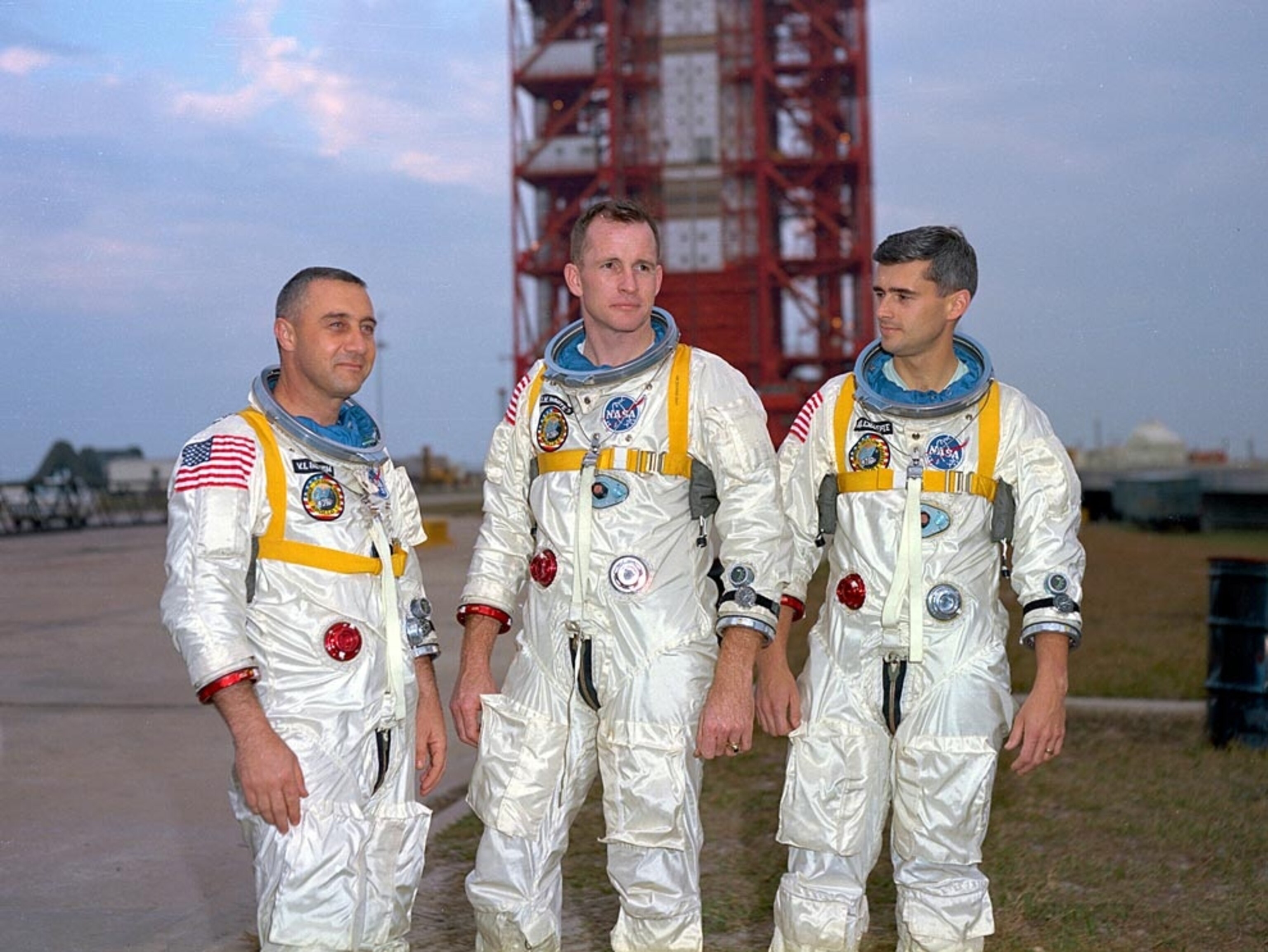
Looking to the moon
Moon missions are essential to the exploration of more distant worlds. After a long hiatus from the lunar neighborhood, NASA is again setting its sights on Earth’s nearest celestial neighbor with an ambitious plan to place a space station in lunar orbit sometime in the next decade. Sooner, though, the agency’s Artemis program , a sister to the Apollo missions of the 1960s and 1970s, is aiming to put the first woman (and the next man) on the lunar surface by 2024.
FREE BONUS ISSUE
Extended lunar stays build the experience and expertise needed for the long-term space missions required to visit other planets. As well, the moon may also be used as a forward base of operations from which humans learn how to replenish essential supplies, such as rocket fuel and oxygen, by creating them from local material.
You May Also Like

In a first, NASA Mars lander feels shockwaves from meteor impacts

SpaceX takes 4 passengers to orbit—a glimpse at private spaceflight’s future

Why go back to the moon? NASA’s Artemis program has even bigger ambitions
Such skills are crucial for the future expansion of human presence into deeper space, which demands more independence from Earth-based resources. And although humans have visited the moon before, the cratered sphere still harbors its own scientific mysteries to be explored—including the presence and extent of water ice near the moon's south pole, which is one of the top target destinations for space exploration .
NASA is also enlisting the private sector to help it reach the moon. It has awarded three contracts to private companies working on developing human-rated lunar landers—including both Blue Origin and SpaceX. But the backbone of the Artemis program relies on a brand new, state-of-the-art spacecraft called Orion .
Archival Photos of Spaceflight
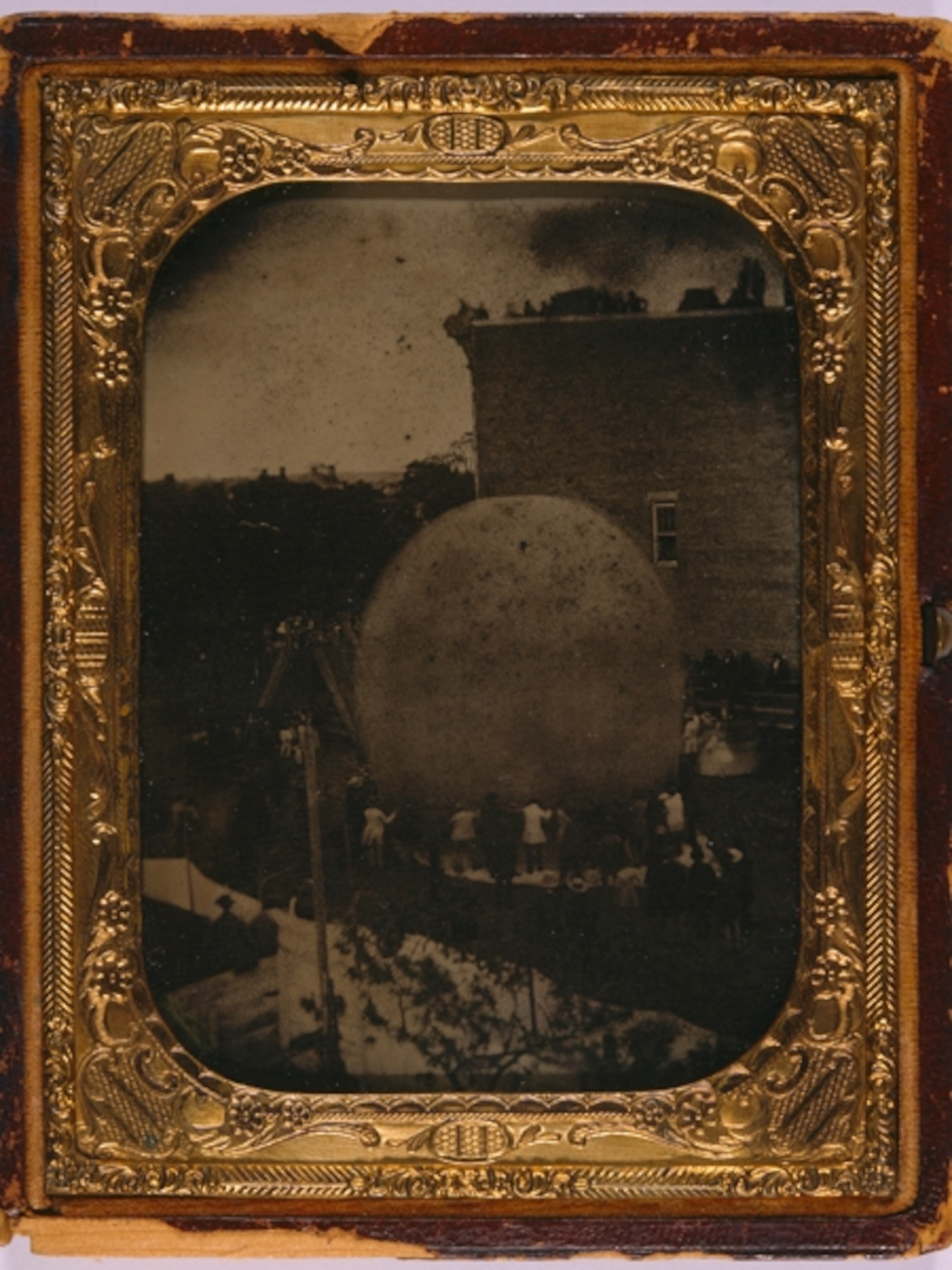
Currently being built and tested, Orion—like Crew Dragon and Starliner—is a space capsule similar to the spacecraft of the Mercury, Gemini, and Apollo programs, as well as Russia’s Soyuz spacecraft. But the Orion capsule is larger and can accommodate a four-person crew. And even though it has a somewhat retro design, the capsule concept is considered to be safer and more reliable than NASA’s space shuttle—a revolutionary vehicle for its time, but one that couldn’t fly beyond Earth’s orbit and suffered catastrophic failures.
Capsules, on the other hand, offer launch-abort capabilities that can protect astronauts in case of a rocket malfunction. And, their weight and design mean they can also travel beyond Earth’s immediate neighborhood, potentially ferrying humans to the moon, Mars, and beyond.
A new era in spaceflight
By moving into orbit with its Commercial Crew Program and partnering with private companies to reach the lunar surface, NASA hopes to change the economics of spaceflight by increasing competition and driving down costs. If space travel truly does become cheaper and more accessible, it’s possible that private citizens will routinely visit space and gaze upon our blue, watery home world—either from space capsules, space stations, or even space hotels like the inflatable habitats Bigelow Aerospace intends to build .
The United States isn’t the only country with its eyes on the sky. Russia regularly launches humans to the International Space Station aboard its Soyuz spacecraft. China is planning a large, multi-module space station capable of housing three taikonauts, and has already launched two orbiting test vehicles—Tiangong-1 and Tiangong-2, both of which safely burned up in the Earth’s atmosphere after several years in space.
Now, more than a dozen countries have the ability to launch rockets into Earth orbit. A half-dozen space agencies have designed spacecraft that shed the shackles of Earth’s gravity and traveled to the moon or Mars. And if all goes well, the United Arab Emirates will join that list in the summer of 2020 when its Hope spacecraft heads to the red planet . While there are no plans yet to send humans to Mars, these missions—and the discoveries that will come out of them—may help pave the way.
Related Topics
- SPACE EXPLORATION
- SCIENCE AND TECHNOLOGY

Second SpaceX megarocket launch ends with another explosion. What happens next?

Why did India land near the moon’s south pole?

U.S. returns to the moon as NASA's Odysseus successfully touches down

In the Arizona desert, NASA prepares for walking on the moon

The moon’s darkest corners are a mystery. This image offers a stunning new glimpse.
- Environment
- Perpetual Planet
History & Culture
- History & Culture
- History Magazine
- Mind, Body, Wonder
- Paid Content
- Terms of Use
- Privacy Policy
- Your US State Privacy Rights
- Children's Online Privacy Policy
- Interest-Based Ads
- About Nielsen Measurement
- Do Not Sell or Share My Personal Information
- Nat Geo Home
- Attend a Live Event
- Book a Trip
- Inspire Your Kids
- Shop Nat Geo
- Visit the D.C. Museum
- Learn About Our Impact
- Support Our Mission
- Advertise With Us
- Customer Service
- Renew Subscription
- Manage Your Subscription
- Work at Nat Geo
- Sign Up for Our Newsletters
- Contribute to Protect the Planet
Copyright © 1996-2015 National Geographic Society Copyright © 2015-2024 National Geographic Partners, LLC. All rights reserved
- International edition
- Australia edition
- Europe edition
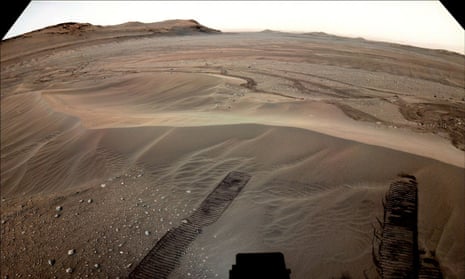
Nasa to test nuclear rockets that could fly astronauts to Mars in record time
Project, in concert with US government agency Darpa, aims to develop pioneering propulsion system for space travel
Nasa has unveiled plans to test nuclear-powered rockets that would fly astronauts to Mars in ultra-fast time.
The agency has partnered with the US government’s Defense Advanced Research Projects Agency (Darpa) to demonstrate a nuclear thermal rocket engine in space as soon as 2027, it announced on Tuesday.
The project is intended to develop a pioneering propulsion system for space travel far different from the chemical systems prevalent since the modern era of rocketry dawned almost a century ago .
“Using a nuclear thermal rocket allows for faster transit time, reducing risk for astronauts,” Nasa said in a press release .
“Reducing transit time is a key component for human missions to Mars , as longer trips require more supplies and more robust systems.”
An additional benefit would be increased science payload capacity, and higher power for instrumentation and communication, according to the agency.
Nasa, which successfully tested its new-era Artemis spacecraft last year as a springboard back to the moon and on to Mars, has hopes of landing humans on the red planet some time in the 2030s as part of its Moon to Mars program.
Using current technology, Nasa says, the 300m-mile journey to Mars would take about seven months . Engineers do not yet know how much time could be shaved off using nuclear technology, but Bill Nelson, the Nasa administrator, said it would allow spacecraft, and humans, to travel in deep space at record speed.
“With the help of this new technology, astronauts could journey to and from deep space faster than ever - a major capability to prepare for crewed missions to Mars,” Nelson said.
Nuclear electric propulsion systems use propellants much more efficiently than chemical rockets but provide a low amount of thrust, the agency says .
A reactor generates electricity that positively charges gas propellants like xenon or krypton, pushing the ions out through a thruster, which drives the spacecraft forward.
Using low thrust efficiently, nuclear electric propulsion systems accelerate spacecraft for extended periods and can propel a Mars mission for a fraction of the propellant of high-thrust systems.
In a statement, Darpa’s director, Dr Stefanie Tompkins, said the agreement was an extension of existing collaboration between the agencies.
“Darpa and Nasa have a long history of fruitful collaboration in advancing technologies for our respective goals, from the Saturn V rocket that took humans to the moon for the first time to robotic servicing and refueling of satellites,” she said.
“The space domain is critical to modern commerce, scientific discovery and national security. The ability to accomplish leap-ahead advances in space technology… will be essential for more efficiently and quickly transporting material to the moon and, eventually, people to Mars.”
Nasa’s Artemis 2 mission, which will send humans around the moon for the first time in more than half a century, is scheduled for 2024. The subsequent Artemis 3 mission, which could come the following year, will land astronauts, including the first woman, on the moon’s surface for the first time since 1972.
- US military
Most viewed
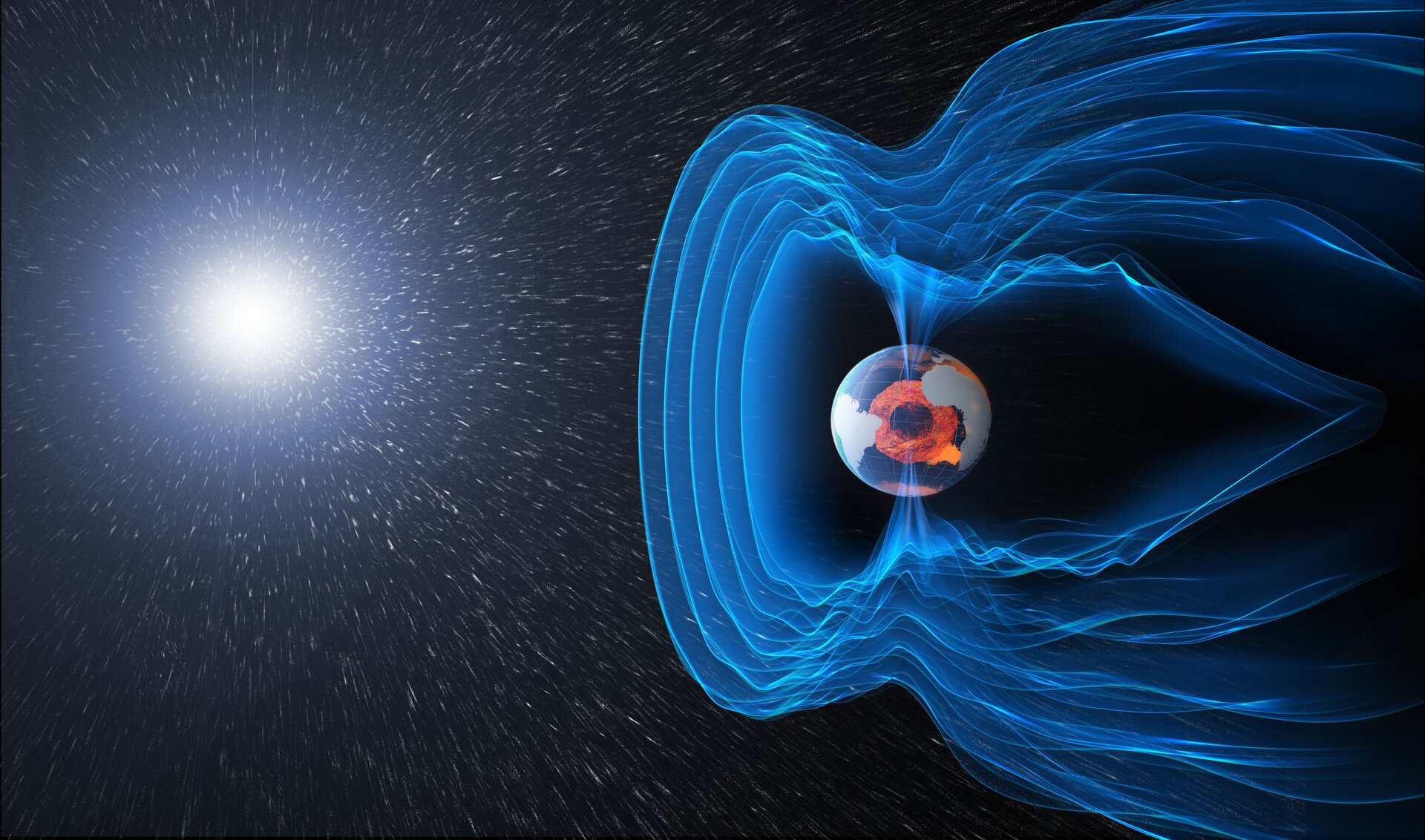
The radiation showstopper for Mars exploration
An astronaut on a mission to Mars could receive radiation doses up to 700 times higher than on our planet – a major showstopper for the safe exploration of our Solar System. A team of European experts is working with ESA to protect the health of future crews on their way to the Moon and beyond.
Earth’s magnetic field and atmosphere protect us from the constant bombardment of galactic cosmic rays – energetic particles that travel at close to the speed of light and penetrate the human body.
Cosmic radiation could increase cancer risks during long duration missions. Damage to the human body extends to the brain, heart and the central nervous system and sets the stage for degenerative diseases. A higher percentage of early-onset cataracts have been reported in astronauts.
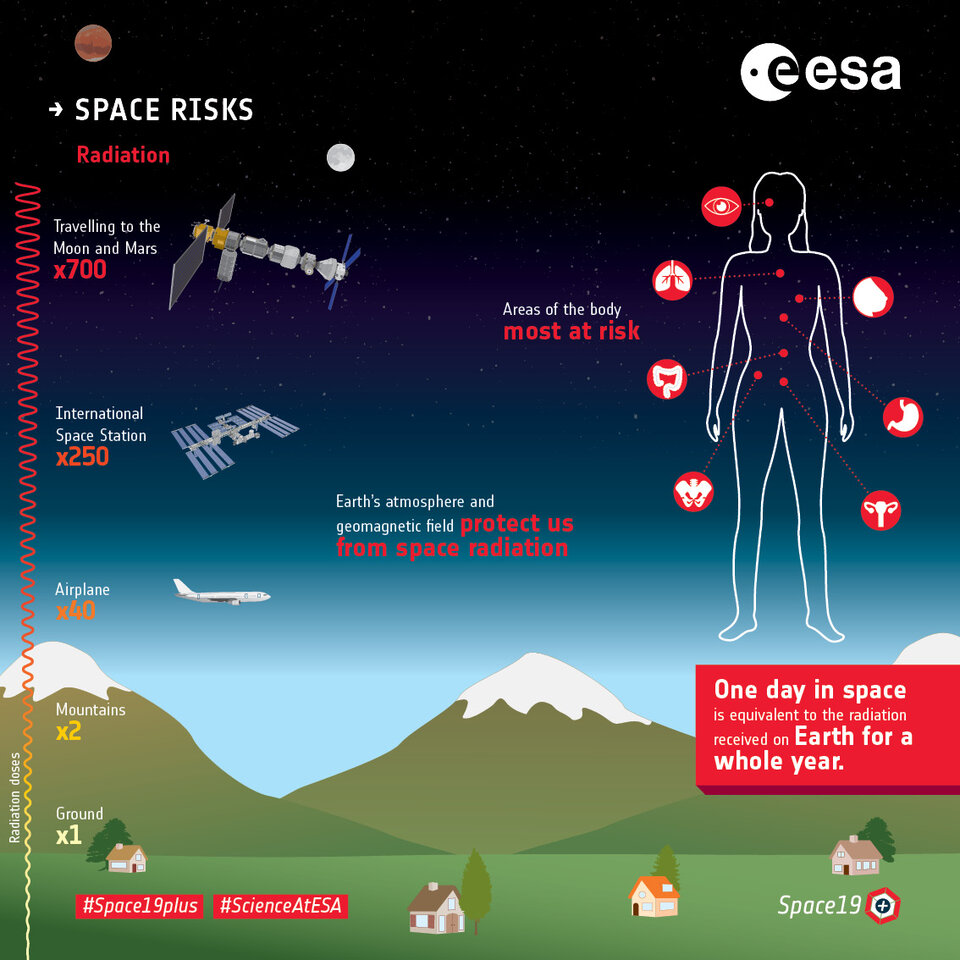
“One day in space is equivalent to the radiation received on Earth for a whole year,” explains physicist Marco Durante, who studies cosmic radiation on Earth.
Marco points out that most of the changes in the astronauts’ gene expression are believed to be a result of radiation exposure, according to the recent NASA’s Twins study . This research showed DNA damage in astronaut Scott Kelly compared to his identical twin and fellow astronaut Mark Kelly, who remained on Earth.
A second source of space radiation comes from unpredictable solar particle events that deliver high doses of radiation in a short period of time, leading to ‘radiation sickness’ unless protective measures are taken.
Europe’s radiation fight club
“The real problem is the large uncertainty surrounding the risks. We don’t understand space radiation very well and the long-lasting effects are unknown,” explains Marco who is also part of an ESA team formed to investigate radiation.
Since 2015, this forum of experts provides advice from areas such as space science, biology, epidemiology, medicine and physics to improve protection from space radiation.
“Space radiation research is an area that crosses the entire life and physical sciences area with important applications on Earth. Research in this area will remain of high priority for ESA,” says Jennifer Ngo-Anh, ESA’s team leader human research, biology and physical sciences.

While astronauts are not considered radiation workers in all countries, they are exposed to 200 times more radiation on the International Space Station than an airline pilot or a radiology nurse.
Radiation is in the Space Station’s spotlight every day. A console at NASA’s mission control in Houston, Texas, is constantly showing space weather information.
If a burst of space radiation is detected, teams on Earth can abort a spacewalk, instruct astronauts to move to more shielded areas and even change the altitude of the Station to minimise impact.
One of the main recommendations of the topical team is to develop a risk model with the radiation dose limits for crews travelling beyond the International Space Station.
ESA’s flight surgeon and radiologist Ulrich Straube believes that the model should “provide information on the risks that could cause cancer and non-cancer health issues for astronauts going to the Moon and Mars in agreement with all space agencies.”
Recent data from ExoMars Trace Gas Orbiter showed that on a six-month journey to the Red Planet an astronaut could be exposed to at least 60% of the total radiation dose limit recommended for their entire career.
“As it stands today, we can’t go to Mars due to radiation. It would be impossible to meet acceptable dose limits,” reminds Marco.
Measure to protect

ESA has teamed up with five particle accelerators in Europe that can recreate cosmic radiation by ‘shooting’ atomic particles to speeds approaching the speed of light. Researchers have been bombarding biological cells and materials with radiation to understand how to best protect astronauts.
“The research is paying off. Lithium is standing out as a promising material for shielding in planetary missions,” says Marco.
ESA has been measuring the radiation dose on the International Space Station for seven years with passive radiation detectors in the DOSIS 3D experiment . ESA astronauts Andreas Mogensen and Thomas Pesquet wore a new mobile dosimeter during their missions that gave them a real-time snapshot of their exposure.
The same European team behind this research will provide radiation detectors to monitor the skin and organ doses of the two phantoms traveling to the Moon onboard NASA’s Orion spacecraft.
ESA has demonstrated expertise in studying Mars from orbit, now we are looking to secure a safe landing, to rove across the surface and to drill underground to search for evidence of life. Our orbiters are already in place to provide data relay services for surface missions. The next logical step is to bring samples back to Earth, to provide access to Mars for scientists globally, and to better prepare for future human exploration of the Red Planet. This week we’re highlighting ESA’s contribution to Mars exploration as we ramp up to the launch of our second ExoMars mission, and look beyond to completing a Mars Sample Return mission. Join the conversation online with the hashtag #ExploreFarther
Thank you for liking
You have already liked this page, you can only like it once!
Related Articles
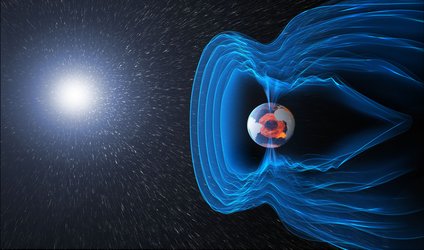
New radiation research programme for human spaceflight
Cosmic opportunity for radiation research at esa.

Active tracking of astronaut rad-exposures targeted
Related links.

Research Announcements
Experiment archive.

CIMAP – Centre de Recherche sur les Ions, les Matériaux et …
CIMAP – Centre de Recherche sur les Ions, les Matériaux et la Photonique
AGOR – Accélérateur Groningen-ORsay
GANIL – Grand Accélérateur National d’Ions Lourds
HIT – Heidelberg Ion-Beam Therapy Center
PTC – Protonen Therapie Dresden
TIFPA - Trento Institute for Fundamental Physics and Applic…
http://www.tifpa.infn.it/
Thank you for visiting nature.com. You are using a browser version with limited support for CSS. To obtain the best experience, we recommend you use a more up to date browser (or turn off compatibility mode in Internet Explorer). In the meantime, to ensure continued support, we are displaying the site without styles and JavaScript.
- View all journals
- My Account Login
- Explore content
- About the journal
- Publish with us
- Sign up for alerts
- Review Article
- Open access
- Published: 05 November 2020
Red risks for a journey to the red planet: The highest priority human health risks for a mission to Mars
- Zarana S. Patel ORCID: orcid.org/0000-0003-0996-6381 1 , 2 ,
- Tyson J. Brunstetter 3 ,
- William J. Tarver 2 ,
- Alexandra M. Whitmire 2 ,
- Sara R. Zwart 2 , 4 ,
- Scott M. Smith 2 &
- Janice L. Huff ORCID: orcid.org/0000-0003-4236-7698 5
npj Microgravity volume 6 , Article number: 33 ( 2020 ) Cite this article
93k Accesses
147 Citations
213 Altmetric
Metrics details
- Cardiovascular diseases
- Eye diseases
- Neurological disorders
- Psychiatric disorders
NASA’s plans for space exploration include a return to the Moon to stay—boots back on the lunar surface with an orbital outpost. This station will be a launch point for voyages to destinations further away in our solar system, including journeys to the red planet Mars. To ensure success of these missions, health and performance risks associated with the unique hazards of spaceflight must be adequately controlled. These hazards—space radiation, altered gravity fields, isolation and confinement, closed environments, and distance from Earth—are linked with over 30 human health risks as documented by NASA’s Human Research Program. The programmatic goal is to develop the tools and technologies to adequately mitigate, control, or accept these risks. The risks ranked as “red” have the highest priority based on both the likelihood of occurrence and the severity of their impact on human health, performance in mission, and long-term quality of life. These include: (1) space radiation health effects of cancer, cardiovascular disease, and cognitive decrements (2) Spaceflight-Associated Neuro-ocular Syndrome (3) behavioral health and performance decrements, and (4) inadequate food and nutrition. Evaluation of the hazards and risks in terms of the space exposome—the total sum of spaceflight and lifetime exposures and how they relate to genetics and determine the whole-body outcome—will provide a comprehensive picture of risk profiles for individual astronauts. In this review, we provide a primer on these “red” risks for the research community. The aim is to inform the development of studies and projects with high potential for generating both new knowledge and technologies to assist with mitigating multisystem risks to crew health during exploratory missions.
Similar content being viewed by others

Selected discoveries from human research in space that are relevant to human health on Earth
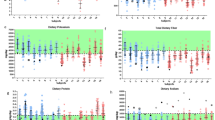
Impact of diet on human nutrition, immune response, gut microbiome, and cognition in an isolated and confined mission environment
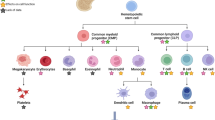
Next generation of astronauts or ESA astronaut 2.0 concept and spotlight on immunity
Introduction.
Spaceflight is a dangerous and demanding endeavor with unique hazards and technical challenges. Ensuring the overall safety of the crew—their physical and mental health and well-being—are vital for mission success. These are large challenges that are further amplified as exploration campaigns extend to greater distances into our solar system and for longer durations. The major health hazards of spaceflight include higher levels of damaging radiation, altered gravity fields, long periods of isolation and confinement, a closed and potentially hostile living environment, and the stress associated with being a long distance from mother Earth. Each of these threats is associated with its own set of physiological and performance risks to the crew (Fig. 1a ) that must be adequately characterized and sufficiently mitigated. Crews do not experience these stressors independently, so it is important to also consider their combined impact on human physiology and performance. This “space exposome” is a unifying framework that reflects the interaction of all the environmental impacts on the human body (Fig. 1b ) and, when combined with individual genetics, will shape the outcomes of space travel on the human system 1 , 2 .
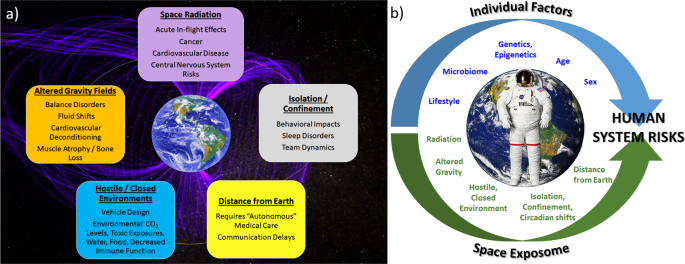
a The key threats to human health and performance associated with spaceflight are radiation, altered gravity fields, hostile and closed environments, distance from Earth, and isolation and confinement. From these five hazards stem the health and performance risks studied by NASA’s Human Research Program. b The space exposome considers the summation of an individual’s environmental exposures and their interaction with individual factors such as age, sex, genomics, etc. - these interactions are ultimately responsible for risks to the human system. Images used in this figure are courtesy of NASA.
The NASA Human Research Program (HRP) aims to develop and provide the knowledge base, technologies, and countermeasure strategies that will permit safe and successful human spaceflight. With agency resources and planning directed toward extended missions both within low Earth orbit (LEO) and outside LEO (including cis-lunar space, lunar surface operations, a lunar outpost, and exploration of Mars) 3 , HRP research and development efforts are focused on mitigation of over 30 categories of health risks relevant to these missions. The HRP’s current research strategy, portfolio, and evidence base are described in the HRP Integrated Research Plan (IRP) and are available online in the Human Research Roadmap, a managed tool used to convey these plans ( https://humanresearchroadmap.nasa.gov/ ). To determine research priorities, NASA uses an evidence-based risk approach to assess the likelihood and consequence (LxC), which gauges the level of each risk for a set of standard design reference missions (Fig. 2 ) 4 . Risks are assigned a rating for their potential to impact in-mission crew health and performance and for their potential to impact long-term health outcomes and quality of life. “Red” risks are those that are considered the highest priority due to their greatest likelihood of occurrence and their association with the most significant risks to crew health and performance for a given design reference mission (DRM). Risks rated “yellow” are considered medium level risks and are either accepted due to a very low probability of occurrence, require in-mission monitoring to be accepted, or require refinement of standards or mitigation strategies in order to be accepted. Risks rated “green” are considered sufficiently controlled either due to lower likelihood and consequence or because the current knowledge base provides sufficient mitigation strategies to control the risk to an acceptable level for that DRM. Milestones and planned program deliverables intended to move a risk rating to an acceptable, controlled level are detailed in a format known as the path to risk reduction (PRR) and are developed for each of the identified risks. The most recent IRP and PRR documents are useful resources for investigators during the development of relevant research approaches and proposals intended for submission to NASA HRP research announcements ( https://humanresearchroadmap.nasa.gov/Documents/IRP_Rev-Current.pdf ).
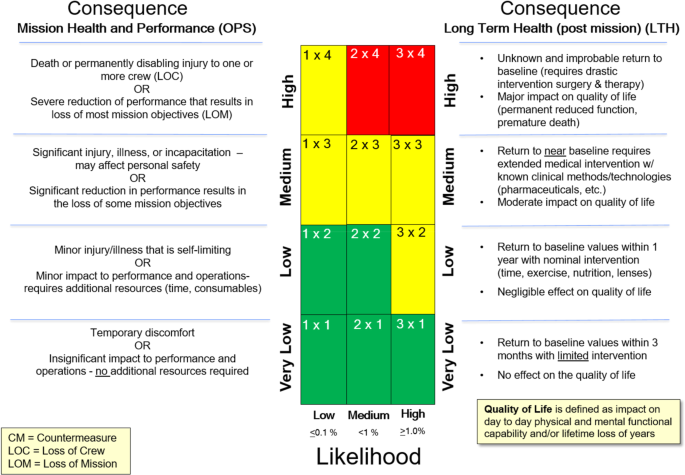
NASA uses an evidence-based approach to assess likelihood and consequence for each documented human system risk. The matrix used for classifying and prioritizing human system risks has two sets of consequences—the left side shows consequences for in-mission risks while the right side is used to evaluate long-term health consequences (Romero and Francisco) 4 .
This work reviews HRP-defined high priority “red” risks for crew health on exploration missions: (1) space radiation health effects that include cancer, cardiovascular disease, and cognitive decrements (2) Spaceflight-Associated Neuro-ocular Syndrome (3) behavioral health and performance decrements, and (4) inadequate food and nutrition. The approaches used to address these risks are described with the aim of informing potential NASA proposers on the challenges and high priority risks to crew health and performance present in the spaceflight environment. This should serve as a primer to help individual proposers develop projects with high potential for generating both new knowledge and technology to assist with mitigating risks to crew health during exploratory missions.
Space radiation health risks
Outside of the Earth’s protective magnetosphere, crews are exposed to pervasive, low dose-rate galactic cosmic rays (GCR) and to intermittent solar particle events (SPEs) 5 . Exposures from GCR are from high charge (Z) and energy (HZE) ions, high-energy protons, and secondary protons, neutrons, and fragments produced by interactions with spacecraft shielding and human tissues. The main components of an SPE are low-to-medium energy protons. In LEO, the exposures are from GCR modulated by the Earth’s magnetic field and from trapped protons in the South Atlantic Anomaly. The absorbed doses for crews on the International Space Station (ISS) on 6- to 12-month missions range from ~30 to 120 mGy. Outside of LEO, without the protection offered by the Earth’s magnetosphere, absorbed radiation doses will be significantly higher. Estimates for a 1 year stay on the lunar surface range from 100 to 120 mGy, and 300 to 450 mGy for an ~3-year Mars mission (transit and surface stay) 6 . The exact dose a crewmember will receive is highly dependent on exact parameters of a given mission, such as detailed vehicle and habitat designs, and mission location and duration 7 . Time in the solar cycle is also a large factor contributing to crew exposure, with highest GCR exposure occurring during periods of minimum solar activity. The lowest GCR exposures occur during periods of maximum solar activity when the heightened magnetic activity of the Sun diverts some cosmic rays; however, during maximum solar activity, the probability of an SPE is higher 8 , 9 . SPEs, which vary in the magnitude and frequency, will obviously also contribute to total mission doses so it is important to note that total mission exposures are only estimates. Further information on the space radiation environment that astronauts will experience is discussed in Simonsen et al. 5 and Durante and Cucinotta 10 .
An important consideration for risk assessment is that the types of radiation encountered in space are very different from the types of radiation exposure we are familiar with here on Earth. HZE ions, although a small fraction of the overall GCR spectrum compared to protons, are more biologically damaging. They differ from terrestrial forms of radiation, such as X-rays and gamma-rays, in both the amount (dose) of exposure as well as in the patterns of DNA double-strand breaks and oxidative damage that they impart as they traverse through tissue and cells (Fig. 3 ) 5 . The highly energetic HZE particles produce complex DNA lesions with clustered double-stranded and single-stranded DNA breaks that are difficult to repair. This damage leads to distinct cellular behavior and intracellular signaling patterns that may be associated with altered disease outcomes compared to those for terrestrial sources of radiation 11 , 12 , 13 . As an example, persistently high levels of oxidative damage are observed in the intestine from mice examined 1 year after exposure to 56 Fe-ion radiation compared to gamma radiation and unirradiated controls 14 , 15 . The higher levels of residual oxidative damage in HZE ion-irradiated tissue is significant because of the association of oxidative stress and damage with the etiology of many human diseases, including cancer, cardiovascular and late neurodegenerative disorders. These types of alterations are believed to contribute to the higher biological effectiveness of HZE particles 10 , 11 .
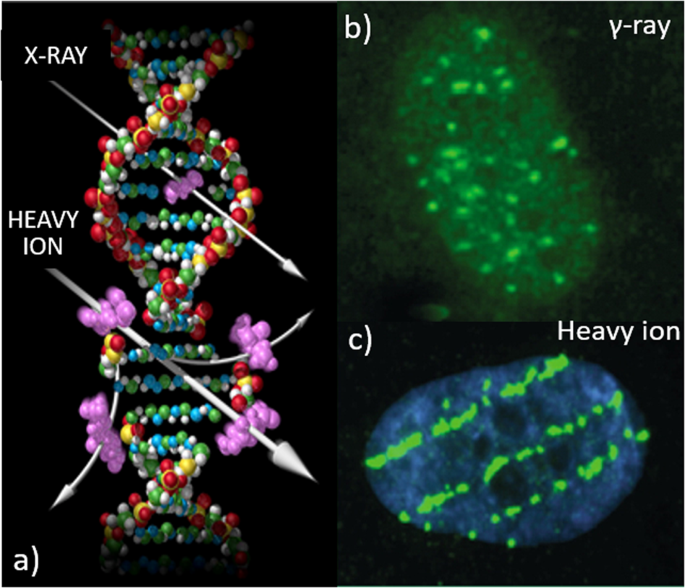
a HZE ions produce dense ionization along the particle track as they traverse a tissue and impart distinct patterns of DNA damage compared to terrestrial radiation such as X-rays. γH2AX foci (green) illuminate distinct patterns of DNA double-strand breaks in nuclei of human fibroblast cells after exposure to b gamma-rays, with diffuse damage, and c HZE ions with single tracks. Image credits: NASA ( a ) and Cucinotta and Durante 97 ( b and c ).
Within the HRP, the Space Radiation Element (SRE) has developed a research strategy involving both vertical translation and horizontal integration, as well as products focused on mitigating space radiation risks across all phases of a mission. Vertical translation involves the integration of benchtop research with preclinical studies and clinical data. Horizontal integration involves a multidisciplinary approach that includes a range of expertize from physicians to clinicians, epidemiologists to computational modelers 16 . The suite of tools includes computational models of the space radiation environment, mission design tools, models for risk projection, and tools and technologies for accurate simulation of the space radiation environment for radiobiology investigations. Ongoing research is focused on radiation quality, age, sex, and healthy worker effects, medical countermeasures to reduce or eliminate space radiation health risks, understanding the complex nature of individual sensitivity, identification and validation of biomarkers (translational, surrogate, predictive, etc.) and integration of personalized risk assessment and mitigation approaches. Owing to the lack of human data for heavy ion exposure on Earth and the complications of obtaining reliable data for space radiation health effects from flight studies, SRE conducts research at the NASA Space Radiation Laboratory (NSRL) at Brookhaven National Laboratory. The NSRL is a ground-based analog for space radiation, where a beamline and associated experimental facilities are dedicated to the radiobiology and physics of a range of ions from proton and helium ions to the typical GCR ions such as carbon, silicon, titanium, oxygen, and iron 5 , 17 , 18 .
Radiation carcinogenesis
Central evidence for association between radiation exposure and the development of cancer and other non-cancer health effects comes from epidemiological studies of humans exposed to radiation 19 , 20 , 21 , 22 . Scaling factors are used by NASA and other space agencies in the analysis of cancer (and other risks) to account for differences between terrestrial radiation exposures and cosmic radiation exposures 23 . The risk of radiation carcinogenesis is considered a “red” risk for exploration-class missions due to both the high likelihood of occurrence, as well as the high potential for detrimental impact on both quality of life and disease-free survival post flight. The major cancers of concern are epithelial in origin (particularly cancers of the lung, breast, stomach, colon, and bladder), as well as leukemias ( https://humanresearchroadmap.nasa.gov/Evidence/reports/Cancer.pdf ). Owing to the lack of human epidemiology directly relevant to the types of radiation found in space, current research utilizes a translational approach that incorporates rodent and advanced human cell-based model systems exposed to space radiation simulants along with comparison of molecular pathways across these systems to the human.
A key question that impacts risk assessment and mitigation is how HZE tumors compare to either radiogenic tumors induced by ground-based radiation or spontaneous tumors. As a unifying concept, NASA studies have sought to examine how space radiation exposure modifies the key genetic and epigenetic modifications noted as the hallmarks of cancer (Fig. 4 ) 24 , 25 , 26 , 27 . This approach provides data for development of translational scaling factors (relative biological effectiveness values, quality factors, dose-rate effectiveness factor) to relate the biological effects of space radiation to effects from similar exposures to ground-based gamma- and X-rays and extrapolation of results to large human epidemiology cohorts. It also supports acquisition of mechanistic information required for successful identification and implementation of medical countermeasure strategies to lower this risk to an acceptable posture for space exploration, and it is relevant for the future development of biologically based dose-response models and integrated systems biology approaches 25 . Cancer is a long-term health risk and although it is rated as “red”, most research in this area is currently delayed, as HRP research priorities focus on in-mission risks.
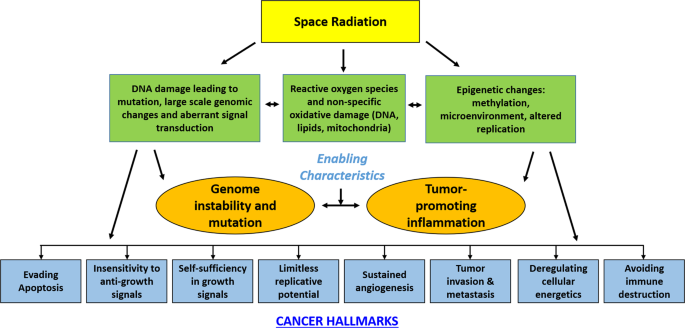
Shown are the enabling characteristics and possible mechanisms of radiation damage that lead to these changes observed in all human tumors. (Adapted from Hanahanand Weinberg) 24 .
Risk of cardiovascular disease and other degenerative tissue effects from radiation exposure and secondary spaceflight stressors
A large number of degenerative tissue (non-cancer) adverse health outcomes are associated with terrestrial radiation exposure, including cardiovascular and cerebrovascular diseases, cataracts, digestive and endocrine disorders, immune system decrements, and respiratory dysfunction ( https://humanresearchroadmap.nasa.gov/Evidence/other/Degen.pdf ). For cardiovascular disease (CVD), a majority of the evidence comes from radiotherapy cohorts receiving high-dose mediastinal exposures that are associated with an increased risk for heart attack and stroke 28 . Recent evidence shows risk at lower doses (<0.5 Gy), with an estimated latency of 10 years or more 29 , 30 , 31 . For a Mars mission, preliminary estimates suggest that circulatory disease risk may increase the risk of exposure induced death by ~40% compared to cancer alone 32 . NASA is also concerned about in-flight risks to the cardiovascular system ( https://humanresearchroadmap.nasa.gov/Evidence/other/Arrhythmia.pdf ), when considering the combined effects of radiation exposure and other spaceflight hazards (Fig. 5 ) 33 . The Space Radiation Element is focused on accumulating data specific to the space radiation environment to characterize and quantify the magnitude of the degenerative disease risks. The current efforts are on establishing dose thresholds, understanding the impact of dose-rate and radiation quality effects, uncovering mechanisms and pathways of radiation-associated cardiovascular and cerebrovascular diseases, and subsequent risk modeling for astronauts. Uncovering the mechanistic underpinnings governing disease processes supports the development of specific diagnostic and therapeutic approaches, is a necessary step in the translation of insights from animal models to humans, and is the basis of personalized medicine approaches.

In blue are the known risk factors for CVD and in black are the other spaceflight stressors that may also contribute to disease development. Image used in this figure is courtesy of NASA.
This information will provide a means to reduce the uncertainty in current permissible exposure limits (PELs), quantify the impact to disease-free survival years, and determine if additional protection or mitigation strategies are required. The research portfolio includes evaluation of current clinical standard-of-care biomarkers for their relevance as surrogate endpoints for radiation-induced disease outcomes. Studies are also addressing the possible role of chronic inflammation and increased oxidative stress in the etiology of radiation-induced CVD, as well as identification of key events in disease pathways, like endothelial dysfunction, that will guide the most effective medical countermeasures. Products include validated space radiation PELs, models to quantify the risk of CVD for the astronaut cohort, and countermeasures and evidence to inform development of appropriate recommendations to clinical guidelines for diagnosis and mitigation of this risk.
Elucidating the role that radiation plays in degenerative disease risks is problematic because multiple factors, including lifestyle and genetic influences, are believed to play a major role in the etiology of these diseases. This confounds epidemiological analyses, making it difficult to detect significant differences from background disease without a large study population 34 . This issue is especially significant in astronaut cohorts because those studies have small sample sizes 35 . There is also a general lack of experimental data that specifically addresses the role of radiation at low, space-relevant doses 36 . Selection of experimental models needs to be carefully considered and planned to ensure that the cardiovascular disease mechanisms and study endpoints are clinically relevant and translatable to humans 37 , 38 . Combined approaches using data from wildtype and genetically modified animal models with accelerated disease development will likely be necessary to elucidate mechanisms and generate the body of knowledge required for development of accurate permissible exposure limits, risk assessment models, and to develop effective mitigation approaches.
Risk of acute (in-flight) and late CNS effects from space radiation exposure
The possibility of acute (in-flight) and late risks to the central nervous system (CNS) from GCR and SPEs are concerns for human exploration of space ( https://humanresearchroadmap.nasa.gov/Evidence/reports/CNS.pdf ). Acute CNS risks may include altered neurocognitive function, impaired motor function, and neurobehavioral changes, all of which may affect human health and performance during a mission. Late CNS risks may include neurological disorders such as Alzheimer’s disease, dementia, or accelerated aging. Detrimental CNS changes from radiation exposure are observed in humans treated with high doses of gamma-rays or proton beams and are supported by a large body of experimental evidence showing neurocognitive and behavioral effects in animal models exposed to lower doses of HZE ions. Rodent studies conducted with HZE ions at low, mission-relevant doses and time frames show a variety of structural and functional alterations to neurons and neural circuits with associated performance deficits 39 , 40 , 41 , 42 , 43 , 44 . Fig. 6 shows an example of changes in dendritic spine density following HZE ion radiation. However, the significance and relationship of these results to adverse outcomes in astronauts is unclear, as similar decrements are not seen with comparable doses of terrestrial radiation. Therefore, scaling to human epidemiology data, as is done for cancer and cardiovascular disease, is not possible. It is also important to note that to date, no radiation-associated clinically significant operational or long-term deficits have been identified in astronauts receiving similar doses via long-duration ISS missions. It is clear that further development of standardized translational models, research paradigms, and appropriate scaling approaches are required to determine significance in humans 45 , 46 . In addition, elucidation of how space radiation interacts with other mission hazards to impact neurocognitive and behavioral health and performance is critical to defining appropriate PELs and countermeasure strategies. The current research approach is a combined effort of SRE, the human factors and behavioral performance element, and the human health countermeasures element in support of an integrated CBS (CNS/behavioral medicine/sensorimotor) plan ( https://humanresearchroadmap.nasa.gov/Risks/risk.aspx?i=99 ). Further information on this risk area is presented below in the Behavioral Health and Performance section and can also be found at the Human Research Roadmap.
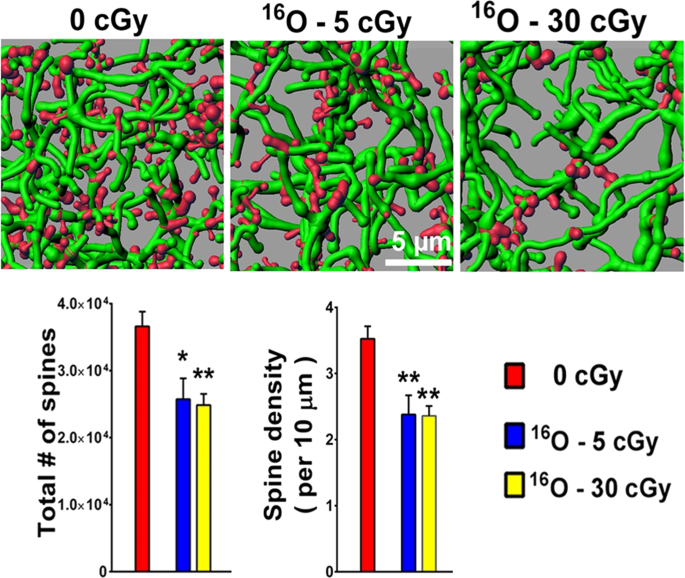
Representative digital images of 3D reconstructed dendritic segments (green) containing spines (red) in unirradiated (0 cGy) and irradiated (5 and 30 cGy) mice brains. Multiple comparisons show that total spine numbers (left bar chart) and spine density (right bar chart) are significantly reduced after exposure to 5 or 30 cGy of 16 O particles. Data are expressed as mean ± SEM. * P < 0.05, ** P < 0.01 versus control; ANOVA. Adapted from Parihar et al. 39 . Permission to reproduce open-source figure per the Creative Commons Attribution 4.0 International License. https://creativecommons.org/licenses/by/4.0 .
To summarize, the health risks posed by the omnipresent exposure to space radiation are significant and include the “red” risks of cancer, cardiovascular diseases, and cognitive and behavioral decrements. While research on the late health risk of cancer is currently delayed, research on the in-flight effects of radiation on the cardiovascular system and CNS within the context of the space exposome are considered the highest priority and are the focus of investigations. Major knowledge gaps include the effects of radiation quality, dose-rate, and translation from animal models to human systems and evaluation of the requirement for medical countermeasure approaches to reduce the risk.
Spaceflight-Associated Neuro-ocular Syndrome
The Risk of Spaceflight-Associated Neuro-ocular Syndrome (SANS), originally termed the Risk of Vision Impairment Intracranial Pressure (VIIP), was first discovered about 15 years ago. VIIP was the original name used because the syndrome most noticeably affects a crewmember’s eyes and vision, and its signs can appear like those of the terrestrial condition idiopathic intracranial hypertension (IIH; which is due to increased intracranial pressure). Over time, it was realized that the VIIP name required an update. Most notably, SANS is not associated with the classic symptoms of increased intracranial pressure in IIH (e.g., severe headaches, transient vision obscurations, double vision, pulsatile tinnitus), and it has never induced vision changes that meet the definition of vision impairment, as defined by the National Eye Institute. In 2017, VIIP was renamed to SANS, a term that welcomes additional pathogenesis theories and serves as a reminder that this syndrome could affect the CNS well beyond the retina and optic nerve.
SANS presents with an array of signs, as documented in the HRP Evidence Report ( https://humanresearchroadmap.nasa.gov/evidence/reports/SANS.pdf ). Primarily, these include edema (swelling) of the optic disc and retinal nerve fiber layer (RNFL), chorioretinal folds (wrinkles in the retina), globe flattening, and refractive error shifts 47 . Flight duration is thought to play a role in the pathogenesis of SANS, as nearly all cases have been diagnosed during or immediately after long-duration spaceflight (i.e., missions of 30 days duration or longer), although signs have been discovered as early as mission day 10 48 . Because of SANS, ocular data are nominally collected during ISS missions. For most ISS crewmembers, this testing includes optical coherence tomography (OCT), retinal imaging, visual acuity, a vision symptom questionnaire, Amsler grid, and ocular ultrasound (Fig. 7 ).
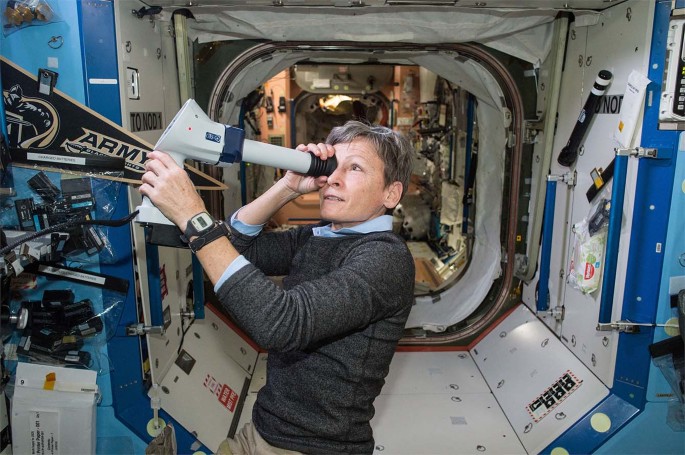
Image courtesy of NASA.
From a short-term perspective (e.g., a 6-month ISS deployment), SANS presents four main risks to crewmembers and their mission: optic disc edema (ODE), chorioretinal folds, shifts in refractive error, and globe flattening 49 . Approximately 69% of the US crewmembers on the ISS experience a > 20 µm increase in peripapillary retinal thickness in at least one eye, indicating the presence of ODE. With significant levels of ODE, a crewmember can experience an enlargement of his/her blind spots and a corresponding loss in visual function. To date, blind spots are uncommon and have not had an impact on mission performance.
If chorioretinal folds are severe enough and located near the fovea (the retina associated with central vision), a crewmember may experience visual distortions or reduced visual acuity that cannot be corrected with glasses or contact lenses, as noted in the SANS Evidence Report. Despite a prevalence of 15–20% in long-duration crewmembers, chorioretinal folds have not yet impacted astronauts’ visual performance during or after a mission. An on-orbit shift in refractive error is due to a shortening of the eye’s axial length (distance between the cornea and the fovea), and it occurs in about 16% of crewmembers during long-duration spaceflight. This risk is mitigated by providing deploying crewmembers with several pairs of “Space Anticipation Glasses” (or contact lenses) of varying power. On-orbit, the crewmember can then select the appropriate lenses to restore best-corrected visual acuity. Approximately 29% of long-duration crewmembers experience a posterior eyeball flattening, which is typically centered around the insertion of the optic nerve into the globe. Globe flattening can induce chorioretinal folds and shifts in refractive error, posing the respective risks described above.
From a longer-term perspective, SANS presents two main risks to crewmembers: ODE and chorioretinal folds. It is unknown if a multi-year spaceflight (e.g., a Mars mission) will be associated with a higher prevalence, duration, and/or severity of ODE compared to what has been experienced onboard the ISS. Since the retina and optic nerve are part of the CNS, if ODE is severe enough, the crewmember risks a permanent loss of optic nerve and RNFL tissue and thus, a permanent loss of visual function. It should be stressed that no SANS-related permanent loss of visual function has yet been discovered in any astronauts.
For choroidal folds, improvement generally occurs post-flight in affected crewmembers; however, significant folds can persist for 10 or more years after long-duration missions. Using MultiColor Imaging and autofluorescence capabilities of the latest OCT device, it was discovered recently that one crewmember’s longstanding (>5 years) post-flight choroidal folds have induced disruption to its overlying retinal pigment epithelium (RPE) 50 . The RPE is a monolayer of pigmented cells located between the vascular-rich choroid and the photoreceptor outer segments. This layer forms the posterior blood-brain barrier for the retina and is essential for maintaining the health of the posterior retina via the transport of nutrients and fluids, among other key functions. If the RPE is damaged, it could potentially lead to a degeneration of the local retina and progress to vision impairment.
Recent long-duration head-down tilt studies have shown potential for recreating SANS signs in terrestrial cohorts 51 . However, SANS is considered a pathology unique to spaceflight. In microgravity, fluid within the body is free to redistribute uniformly. This means that much of the fluid that normally pools in a person’s feet and legs due to gravity can transfer upward towards the head and cause a general congestion of the cerebral venous system. The central pathogenesis theories of SANS are based on these facts, but the actual cause(s) and pathophysiology of SANS are yet unknown 49 . The most publicized theory for SANS has been that cerebral spinal fluid outflow might be impeded, causing an overall increase in intracranial pressure (ICP) 47 , 52 . Other potential mechanisms (see Fig. 8 ) include cerebral venous congestion or altered folate-dependent 1-carbon metabolism via a cascade of mechanisms that may ultimately increase ICP or affect the response of the eye to fluid shifts 53 , 54 . Potential confounding variables for SANS pathogenesis include resistive exercise, high-sodium dietary intake, and high carbon dioxide levels.
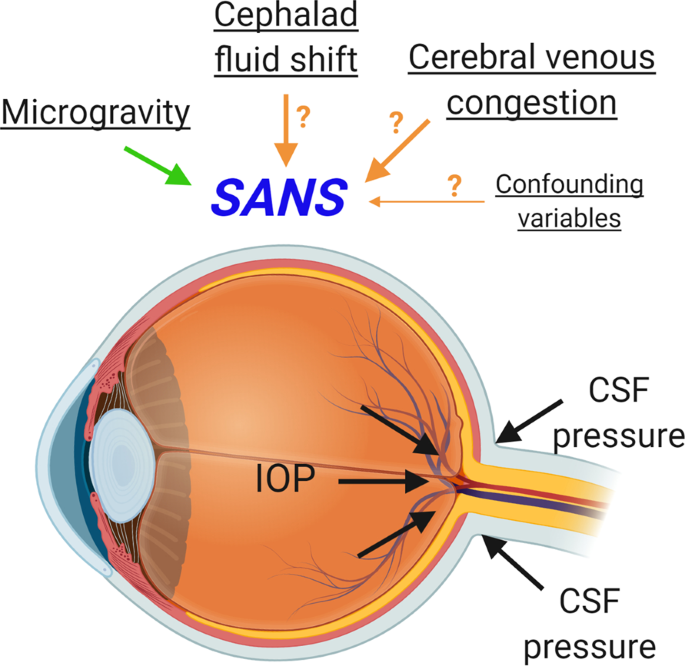
Image created with BioRender.com.
Discovering patterns and trends in the SANS population has been difficult due to the relatively low number of crewmembers who have completed long-duration spaceflight. This is especially true for female astronauts. However, there is now enough evidence to state—emphatically—that SANS is not a male-only syndrome. OCT has been utilized onboard the ISS since late 2013, and it has revolutionized NASA’s ability to objectively detect and monitor SANS and build a high-resolution database of retinal and optic nerve head images. Through this technology, it has been recently discovered that that a majority of long-duration astronauts (including females) present with some level of ODE and engorgement of the choroidal vasculature 48 , 55 . The trends and patterns of these ocular anatomical changes may hold the key to deciphering the pathophysiology of SANS 48 , 55 .
Beginning in 2009 in response to SANS, all NASA crewmembers receive pre- and post-flight 3 Tesla magnetic resonance imaging of the brain and orbits. Based on these images, there is growing evidence that brain structural changes also occur during long-duration spaceflight. Most notably, a 10.7–14.6% ventricular enlargement (i.e., approximately a 2–3 ml increase) has been detected in astronauts and cosmonauts by multiple investigators 56 , 57 , 58 , 59 . On-orbit and post-flight cognitive testing have not revealed any systemic cognitive decrements associated with these anatomical changes. Moreover, additional research is required to determine if spaceflight-associated brain structural changes are related to ocular structural changes (i.e., SANS) or if the two are initiated by a common cause. Thus, until a relationship is established, SANS will be defined by ocular signs.
Future SANS medical operations, research, and surveillance will focus on: 1) determining the pathogenesis of the syndrome, 2) developing small-footprint diagnostic devices for expeditionary spaceflight, 3) establishing effective countermeasures, 4) monitoring for any long-term health consequences, and 5) discovering what factors make certain individuals more susceptible to developing the syndrome.
In summary, SANS is a top risk and priority to NASA and HRP. The primary SANS-related risk is ODE, due to the possibility of permanent vision impairment; however, choroidal folds also present a short- and long-term risk to astronaut vision. Shifts in refractive error are relatively common in long-duration missions, but crewmembers do not experience a loss of visual acuity if adequate correction is available. SANS affects female astronauts, not just males, although it is not yet known if SANS prevalence is equal between the sexes. There are no terrestrial pathologies identical to SANS, including IIH. Long-duration spaceflight is also associated with brain anatomical changes; however, it is not yet known whether these changes are related to SANS. Finally, the pathogenesis of SANS remains elusive; however, the main theories are related to increased intracranial pressure, ocular venous congestion, and individual anatomical/genetic variability.
Behavioral health and performance
The Risk of Adverse Cognitive and Behavioral Conditions and Psychiatric Disorders (BMed) focuses on characterizing and mitigating potential decrements in performance and psychological health resulting from multiple spaceflight hazards, including isolation and distance from earth. Spaceflight radiation is also recognized as contributing factor, particularly relative to a deep space planetary mission. The potential of additive or synergistic effects on the CNS resulting from simultaneous exposures to radiation, isolation and confinement, and prolonged weightlessness, is also of emerging concern ( https://humanresearchroadmap.nasa.gov/Risks/risk.aspx?i=99 ).
The official risk statement in the BMed Evidence Report notes, “ given the extended duration of future missions and the isolated, confined and extreme environments, there is a possibility that (a) adverse cognitive or behavioral conditions will occur affecting crew health and performance; and (b) mental disorders could develop should adverse behavioral conditions be undetected and unmitigated ” ( https://humanresearchroadmap.nasa.gov/Evidence/reports/BMED.pdf ). Primary outcomes for this risk include decrements in cognitive function, operational performance, and psychological and behavioral states, with the development of psychiatric disorders representing the least likely but one of the most consequential outcomes crew could experience in extended spaceflight. BMed is considered a “red” risk for planetary missions, given the long-duration of isolation, extended confinement, and exposure to additional stressors, including increased radiation exposure. The Human Factors and Behavioral Performance Element within HRP utilizes a research strategy that incorporates flight studies on astronauts, research in astronaut-like individuals and teams in ground analogs, and works with the Space Radiation Element to use animal models supporting research on combined spaceflight stressors.
While astronauts successfully accomplish their mission objectives and report very positive experiences living and working in space, some anecdotal accounts from current and past astronauts suggest that psychological adaptation in the long-duration spaceflight environment can be challenging. However, clinically significant operational decrements have not been documented to date, as noted in the BMed Evidence Report. Discrete events that have been documented include accounts of adverse responses to workload by Shuttle payload specialists, and descriptions of ‘hostile’ and ‘irritable’ crew in the 84-day Skylab 4 mission, as well as symptoms of depression reported on Mir by 2 of the 7 NASA astronauts.
Currently, potential stressors affiliated with missions to the ISS include extended periods of high workload and/or schedule shifting, physiological adaptation including fluid shifts caused by weightlessness and possibly, exposure to other environmental factors such as elevated carbon dioxide (see the BMed Evidence Report). While still physically isolated from home, the presence of the ISS in LEO facilitates a robust ground behavioral health and performance support team who offer services such as bi-weekly private psychological conferences and regular delivery of novel goods and surprises from home in crew care packages. Coupled with the relatively ample volume in the ISS, near-constant real-time communication with Earth, new crewmembers rotating periodically throughout missions, and relatively low levels of radiation exposure, —it is expected that behavioral challenges experienced today do not represent those that future crews will face during exploration missions.
Nevertheless, the few completed behavioral studies on the ISS suggest that subjective perceptions of stress increase over time for some crewmembers, as shown by an in-flight study collecting subjective ratings of well-being and objective measures of fatigue 60 . Notably, it was found that astronaut ratings of sleep quality and sleep duration (also measured through visual analog scales) were found to be inversely related to ratings of stress. Another in-flight investigation seeking to characterize behavioral responses to spaceflight is the “Journals” study by Stuster 61 . This investigation provided a systematic approach to examining a rich set of qualitative data by evaluating astronaut journal entries for temporal patterns of across different behavioral states over the course of a mission (Fig. 9 ). Based on findings, some categories suggest temporal patterns while other categories of outcomes do not suggest a pattern relative to time, which may be due to no temporal relationship between outcomes and time, and/or various contextual factors within missions that negate the presence of such a relationship (e.g., visiting crew). An overall assessment by Stuster of negative comments relative to positive comments over time suggests evidence of a third quarter phenomenon in Adjustment alone, a category which reflects individual morale 61 .
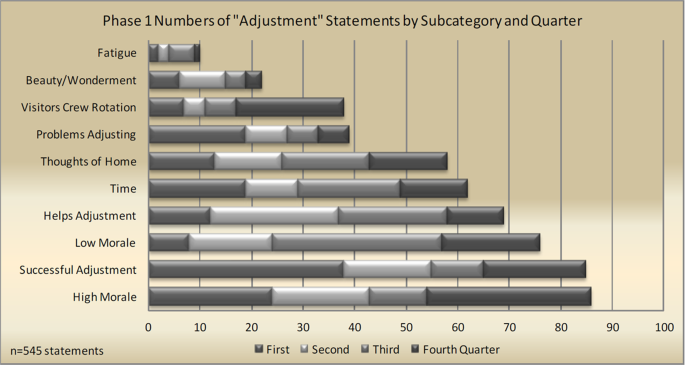
Example bar graph showing distribution of journal entries related to general adjustment to the spaceflight enivronment during each quarter of an ISS mission 61 .
Other in-flight investigations support and expand upon contributors to increased stress on-orbit, including studies documenting reductions in sleep duration 62 , 63 and evaluation of crew responses to habitability and human factors during spaceflight 64 . While no studies have assessed potentially relevant mechanisms for behavioral or other reported symptoms, a recently completed investigation suggests neurostructural changes may be occurring in the spaceflight environment 56 . Magnetic resonance imaging scans were conducted on astronauts pre- and post-flight on both long-duration missions to the ISS or short-duration Shuttle missions. Assessments from a subgroup of participants ( n = 12) showed a slight upward shift of the brain after all long-duration flights but not after short-duration flights ( n = 6), and they also showed narrowing of cerebral spinal fluid spaces at the vertex after all long-duration flights ( n = 6) and in 1 of 6 crew after short-duration flights. A retrospective analysis of free water volume in the frontal, temporal, and occipital lobes before versus after spaceflight suggests alterations in free water distribution 65 . Whether there is a functionally relevant outcome as a result of such changes remains to be determined. Hence, while certain aspects of the spaceflight environment have been shown to increase some behavioral responses (e.g., reduced sleep owing to workload), the direct role of spaceflight-specific factors (such as fluid shifts and weightlessness) on behavioral outcomes or functional performance has not yet been established.
Future long-duration missions will pose threats to behavioral health and performance, such as extreme confinement in a small volume and communication delays, that are distinct from what is currently experienced on missions to the ISS. Analog research is concurrently underway to help further characterize the likelihood and consequence of an adverse behavioral outcome, and the effectiveness of potential countermeasures. Ground analogs, such as the Human Exploration Research Analog (HERA) at NASA Johnson Space Center, provide a test bed where controlled studies of small teams for periods up to 45 days, can be implemented (Fig. 10 ). HERA can be used to provide scenarios and environments analogous to space (e.g., isolation and confinement, communication delays, space food, and daily tasks and schedules) to investigate their effects on behavioral health, human factors, exploration medical capabilities, and communication and autonomy. Research in locations such as Antarctica also offer a unique opportunity to conduct research in less controlled but higher fidelity conditions. In general, these studies show an increased risk in deleterious effects such as decreased mood and increased stress, and in some instances, psychiatric outcomes (see the BMed Evidence Report).
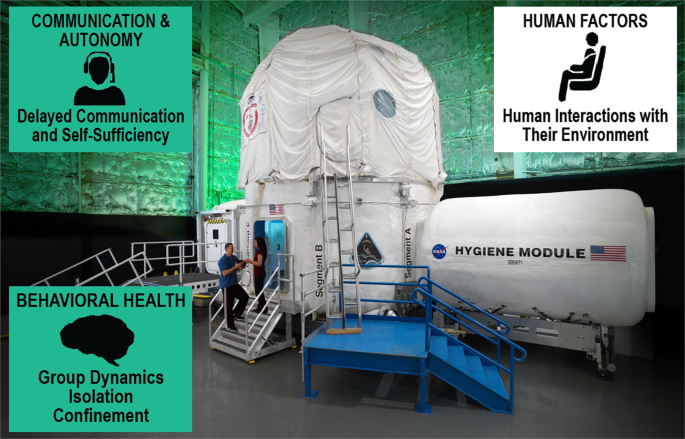
HERA is used to simulate environments and mission scenarios analogous to spaceflight to investigate a variety of behavioral and human factors issues. Images courtesy of NASA.
In 2014, Basner and colleagues 62 completed an assessment of crew health and performance in a 520-day mission at an isolation chamber in Moscow at the Institute for Biomedical Problems (IBMP). During this simulated mission to Mars, the crew of six completed behavioral questionnaires and additional testing weekly. One of six (20%) crew reported depressive symptoms based on the Beck Depression Inventory in 93% of mission weeks, which reached mild-to-moderate levels in >10% of mission weeks. Additional indications of changes in mood were observed via the Profile of Mood States. Additionally, two crewmembers who had the highest ratings of stress and physical exhaustion accounted for 85% of the perceived conflicts, and other crew demonstrated dysregulation in their circadian entrainment and sleep difficulties. Two of the six crewmembers reported no adverse behavioral symptoms during the missions 62 . Building on this work, the NASA HRP and the IBMP have ongoing studies in the SIRIUS project, a series of long-duration ground-analog missions for understanding the effects of isolation and confinement on human health and performance ( http://www.nasa.gov/analogs/nek/about ).
Finally, more recent research in the HERA analog at Johnson Space Center is underway to assess not only individual, psychiatric outcomes but also changes in team dynamics and team performance over time (Fig. 10 ). A recent publication reported that conceptual team performance (e.g., creativity) seems to decrease over time, while performance requiring cognitive function and coordinated action improved 66 . While results from additional team studies in HERA are currently under review, the Teams Risk Evidence Report ( https://humanresearchroadmap.nasa.gov/Evidence/reports/Team.pdf ) provides a thorough overview of the evidence surrounding team level outcomes.
In summary, evidence from spaceflight and spaceflight analogs suggests that the BMed Risk poses a high likelihood and high consequence risk for exploration. Given the possible synergistic effects of prolonged isolation and confinement, radiation exposure, and prolonged weightlessness, mitigating such enhanced risks faced by future crews are of highest priority to the NASA HRP.
Inadequate food and nutrition
Historically, nutrition has driven the success—and often the failure—of terrestrial exploration missions. For space explorers, nutrition provides indispensable sustenance, provides potential countermeasures to some of the negative effects of space travel on human physiology, and also presents a multifaceted risk to the health and safety of astronauts ( https://humanresearchroadmap.nasa.gov/Evidence/other/Nutrition-20150105.pdf ).
At a minimum, the need to prevent nutrient deficiencies is absolute. This was proven on voyages during the Age of Sail, where scurvy—caused by vitamin C deficiency— killed more sailors than all other causes of death. On a closed (or even semi-closed) food system, the risk of nutrient deficiency is increased. On ISS missions, arriving vehicles typically bring some fresh fruits and/or vegetables to the crew. While limited in volume and shelf-life, these likely provide a valuable source of nutrients and phytochemicals every month or two. One underlying concern is that availability of these foods may be mitigating nutrition issues of the nominal food system, and without this external source of nutrients on exploration-class missions, those issues will be more likely to surface.
As a cross-cutting science, nutrition interfaces with many, if not all, physiological systems, along with many of the elements associated with space exploration, including the spacecraft environment (Fig. 11 ). Thus, beyond the basics of preventing deficiency of specific nutrients, at best, nutrition can serve as a countermeasure to mitigate risks to other systems. Conversely, at worst, diet and nutrition can exacerbate risks to other physiological systems and crew health. For example, many of the diseases of concern as related to space exploration are nutritionally modifiable on Earth, including cancer, cardiovascular disease, osteoporosis, sarcopenia, and cataracts.
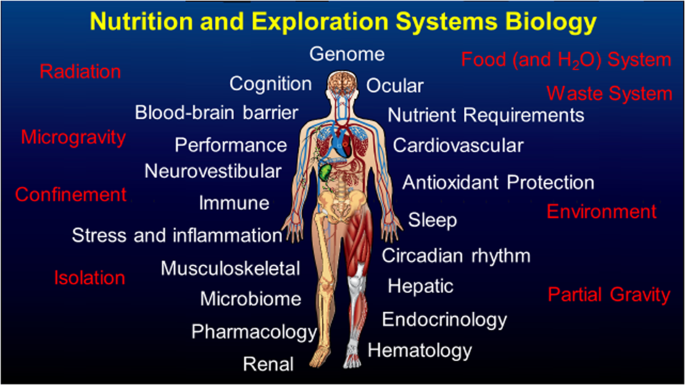
Many of the physiological systems and performance characteristics that are touched by nutrition are shown in white text, while the unique elements of spacecraft and space exploration are shown in red text.
The NASA Nutritional Biochemistry Laboratory approaches astronaut health with both operational and research efforts. These efforts aim to keep current crews healthy while working to understand and define optimal nutrition for future crews, to maximize performance and overall health while minimizing damaging effects of spaceflight exposure.
A Clinical Nutrition Assessment is conducted for ISS astronauts dating back to ISS Expedition 1 67 , 68 , which includes pre- and post-flight biochemical analyses conducted on blood and urine samples, along with in-flight monitoring of dietary intake and body mass. The biochemical assessments include a wide swath of nutritional indicators such as vitamins, minerals, proteins, hematology, bone markers, antioxidant markers, general chemistry, and renal stone risk. These data are reported to the flight surgeon soon after collection for use in the clinical care of the astronaut. Initial findings from the Clinical Nutritional Assessment protocol identified evidence of vitamin D deficiency, altered folate status, loss of body mass, increased kidney stone risk, and more 69 , 70 . These initial findings led to several research efforts (described below), including the Nutritional Status Assessment flight project, and research in the Antarctic on vitamin D supplementation 71 , 72 .
In addition to in-flight dietary intake monitoring, research to understand the impact and involvement of nutrition with other spaceflight risks such as bone loss and visual impairments, and interaction with exercise and spacecraft environment, are performed by the Nutrition Team using both flight and ground-analog research efforts. Tracking body mass is a very basic but nonetheless indispensable element of crew health 73 . Loss of body mass during spaceflight and in ground analogs of spaceflight is associated with exacerbated bone and muscle loss, cardiovascular degradation, increased oxidative stress, and more 70 , 73 , 74 . Historically, it was often assumed that some degree of body mass loss was to be expected, and that this was a typical part of adaptation to microgravity. Fluid loss is often assumed to be a key factor, but research has documented this to be a relatively small contributor, of approximately 1% of weight loss being fluid 74 , 75 . While on average, crewmembers on ISS missions have lost body mass over the course of flight, not all do 74 . Importantly, those that did not lose body mass managed to maintain bone mineral density (discussed below) 76 .
Bone loss has long been a concern for space travelers 77 , 78 , 79 , 80 , 81 . It has been shown that an increase in bone resorption was the likely culprit and that bone formation was largely unchanged in microgravity or ground analogs 77 , 78 , 79 . The search for a means to counteract this bone loss, and this hyper-resorptive state specifically, has been extensive. The potential for nutrition to mitigate this bone loss was identified early but studies of increasing intakes of calcium, or fluoride, or phosphate, were unsuccessful 74 , 77 , 79 , 82 , 83 , 84 .
Exercise provides a multisystem countermeasure, and heavy resistive exercise specifically provides for loading of bone to help mitigate weightlessness-induced bone loss.
In evaluating the data from astronauts using the first “interim” resistive exercise device (iRED) on ISS compared to a later, “advanced” resistive exercise device (ARED) (Fig. 12 ), it was quickly realized that exercise was not the only difference in these two groups of astronauts. ARED crews had better dietary intakes (as evidenced by maintenance of body mass) and better vitamin D status as a result of increased dose of supplementation and awareness of the importance of these supplements starting in 2006 76 . Bone mineral density was protected in these astronauts 76 , proving that diet and exercise are a powerful countermeasure combination. Follow-on evaluations showed similar results and further that the effects of microgravity exposure on bone health in men and women were similar 85 despite differences in pre-flight bone mass.
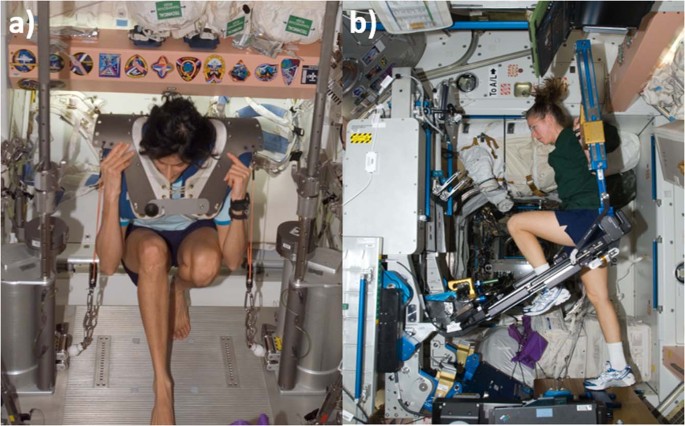
Sunita Williams exercising on the iRED ( a ), and on a later mission, Sandy Magnus exercises on the much improved ARED device ( b ). Images courtesy of NASA.
From a purely nutrition perspective, ISS and associated ground analog research has identified several specific dietary effects on bone health. Fish intake, likely secondary to omega-3 fatty acid intake, is beneficial for bone health 86 . Conversely, high intakes of dietary protein 87 , 88 , iron 89 and sodium 90 are detrimental to bone. The mechanism of the effect of protein and sodium on bone are likely similar, with both contributing to the acidogenic potential of the diet, leading to bone dissolution 91 , 92 . This effect was recently documented in a diet and bone health study on ISS, where the acidogenic potential of the diet correlated with post-flight bone losses 93 . The data from terrestrial research, along with the more limited spaceflight research, clearly identifies nutrition as important in maintenance of bone health and in the mitigation of bone loss. While initial evaluations of dietary quality and health are underway at NASA, much work remains to document the full potential of nutrition to mitigate bone loss and other disease processes in space travelers.
Another health risk with nutrition underpinnings is SANS, which was described earlier. When this issue first arose, an examination of data from the aforementioned ISS Nutrition project was conducted. This analysis revealed that affected crewmembers had significantly higher circulating concentrations of homocysteine and other one-carbon pathway metabolites when compared to non-cases and that these differences existed before flight 53 . Many potential confounding factors were ruled out, including: sex, kidney function, vitamin status, and coffee consumption, among others. After identifying differences in one-carbon biochemistry, the next logical step was to examine the genetics—single-nucleotide polymorphisms (SNPs)—involved in this pathway as possible causes of the biochemical differences, but perhaps also their association with the astronaut ocular pathologies. An initial study examined a small set of SNPs—five to be exact—and when the data were statistically modeled, it was found that B-vitamin status and genetics were significant predictors of many of the observed ophthalmic outcomes in astronauts 94 . Interestingly, the same SNPs identified in astronauts to be associated with ophthalmic changes after flight were associated with greater changes in total retina thickness after a strict head-down tilt with 0.5% CO 2 bed rest study 54 . A follow-on study is underway to evaluate a much broader look at one-carbon pathway and associated SNPs, potentially to help better characterize this relationship.
A hypothesis was developed to plausibly link these genetics and biochemical differences with these ophthalmic outcomes, as there is no existing literature regarding such a relationship. This multi-hit hypothesis posits that one-carbon pathway genetics is an indispensable factor, and that the combination with one or more other factors (e.g., fluid shifts, carbon dioxide, radiation, endocrine effects) lead to these pathologies. This has been detailed in a hypothesis paper 95 and in a recent review 96 . In brief, the hypothesis is that genetics and B-vitamin status contribute to endothelial dysfunction, as folate (and other B-vitamins) play critical roles in nitric oxide synthesis and endothelial function. A disruption in nitric oxide synthesis can also lead to an activation of matrix metalloproteinase activation, increasing the turnover and breakdown of structural elements of the sclera, altering retinal elasticity and increasing susceptibility to fluid shifts to induce ophthalmic pathologies like optic disc edema and choroidal folds 54 . This is likely exacerbated cerebrally due to limitations of transport of B-vitamins across the blood-brain barrier. In or around the orbit, endothelial dysfunction, oxidative stress, and potentially individual anatomical differences contribute to leaky blood vessels, and subsequent edema. This can impinge on cerebrospinal fluid drainage from the head, increasing those fluid pressures, which can impinge upon the optic nerve and eye itself, yielding the aforementioned ophthalmic pathologies. These are hypotheses proposed as starting points for further research. Given the irrefutable biochemical and genetic findings to date, this research should be a high priority to either prove or dismiss these as contributing factors in SANS to mitigate that “red” risk.
Another intriguing element from this research is that there is a clinical population that has many of the same characteristics of affected astronauts (or characteristics that they are purported to have), and that is women with polycystic ovary syndrome (PCOS) 95 , 96 . Women with PCOS have higher circulating homocysteine concentrations (as do their siblings and fathers), and also have cardiovascular pathology, including endothelial dysfunction. Studies are underway between NASA and physicians at the Mayo Clinic in Minnesota to evaluate this further. If validated, women with PCOS might represent an analog population for astronaut ocular issues, and research to counteract this could benefit both populations 87 . This research may lead to the identification of one-carbon pathway genetic influences on cardiovascular function in astronauts (and women with PCOS). This information will not be used in any sort of selection process, for several reasons, but as a means to identify countermeasures. Given the effects are intertwined with vitamin status, and likely represent higher individual vitamin requirements, targeted B-vitamin supplementation is the most obvious, and lowest risk, countermeasure that needs to be tested. There is tremendous potential for nutrition research to solve one of the key risks to human health on space exploration missions.
To summarize, nutrition is a cross-cutting field that has influence on virtually every system in the body. While we need to understand nutrition to avoid frank deficiencies, we need to understand how optimizing nutrition might also help mitigate other spaceflight-induced human health risks. Examples of this are myriad, ranging from effects of dietary intake on cognition, performance, and morale, inadequate intake on cardiovascular performance, excess nutrient intakes, leading to excess storage and increased oxidative stress, nutrient insufficiencies, leading to bone loss, insufficient fruit and vegetable intake on bone health, radiation protection, and cardiovascular health, to name a just few. Throughout history, nutrition has served, or failed, many a journey to explore. We need to dare to use and expand our twenty-first century knowledge of nutrition, uniting medical and scientific teams, to enable future exploration beyond LEO, while simultaneously benefitting humanity.
The NASA Human Research Program is focused on developing the tools and technologies needed to control the high priority “red” risks to an acceptable level—a great challenge as the risks do not exist in the vacuum of space as standalone entities. They are inherently interconnected and represent the intersection points where the five hazards of spaceflight overlap, and nature meets nurture. This is the space exposome: the total sum of spaceflight and lifetime exposures and how they relate to individual genetics and determine the whole-body outcome. The space exposome will be an important unifying concept as the hazards and risks of spaceflight are evaluated in a systems biology framework to fully uncover the emergent effects of the extraterrestrial experience on the human body. This framework will provide a path forward for mitigating detrimental health and performance outcomes that may stand in the way of successful, long-duration space travel, especially as NASA plans for a return to the Moon, to stay, and beyond to Mars.
Wild, C. P. The exposome: from concept to utility. Int. J. Epidemiol. 41 , 24–32 (2012).
Article PubMed Google Scholar
Crucian, B. E. et al. Immune system dysregulation during spaceflight: potential countermeasures for deep space exploration missions. Front. Immunol. 9 , 1–21 (2018).
Article CAS Google Scholar
Cassell, A. M. Forward to the Moon: NASA’s Strategic Plan for Human Exploration (NASA Ames Research Center ARC-E-DAA-TN73512, 2019).
Romero, E. & Francisco, D. The NASA human system risk mitigation process for space exploration. Acta Astronaut. 175 , 606–615 (2020).
Article Google Scholar
Simonsen, L. C., Slaba, T. C., Guida, P. & Rusek, A. NASA’s first ground-based Galactic Cosmic Ray Simulator: enabling a new era in space radiobiology research. PLOS Biol. 18 , e3000669 (2020).
Article CAS PubMed Central PubMed Google Scholar
Norbury, J. W. et al. Galactic cosmic ray simulation at the NASA Space Radiation Laboratory. Life Sci. Space Res. (Amst.) 8 , 38–51 (2016).
NCRP. Report No. 183—Radiation Exposure in Space and the Potential for Central Nervous System Effects: Phase II . (National Council on Radiation Protection, 2019).
Slaba, T., Mertens, C. J. & Blattnig, S. R. Radiation Shielding Optimization on Mars . (NASA/TP–2013-217983, 2013).
Simonsen, L. C. & Nealy, J. E. Radiation Protection for Human Missions to the Moon and Mars . (NASA-TP-3079, 1991).
Durante, M. & Cucinotta, F. A. Heavy ion carcinogenesis and human space exploration. Nat. Rev. Cancer 8 , 465–472 (2008).
Article CAS PubMed Google Scholar
Li, M. et al. Health risks of space exploration: targeted and nontargeted oxidative injury by high-charge and high-energy particles. Antioxid. Redox Signal. 20 , 1501–1523 (2014).
Sridharan, D. M., Chappell, L. J., Whalen, M. K., Cucinotta, F. A. & Pluth, J. M. Defining the biological effectiveness of components of High-LET track structure. Radiat. Res. 184 , 105–119 (2015).
Rose, Li,Y. et al. Mutational signatures in tumours induced by high and low energy radiation in Trp53 deficient mice. Nat. Commun. 11 , 394 (2020).
Datta, K., Suman, S., Kallakury, B. V. S. & Fornace, A. J. Exposure to heavy ion radiation induces persistent oxidative stress in mouse intestine. PLoS ONE 7 , e42224 (2012).
Kumar, S., Suman, S., Fornace, A. J. & Datta, K. Space radiation triggers persistent stress response, increases senescent signaling, and decreases cell migration in mouse intestine. Proc. Natl Acad. Sci. USA 115 , E9832–E9841 (2018).
Article CAS PubMed PubMed Central Google Scholar
National Academies of Sciences, Engineering, and Medicine of Sciences. A Midterm Assessment of Implementation of the Decadal Survey on Life and Physical Sciences Research at NASA . (The National Academies Press, 2018).
La Tessa, C., Sivertz, M., Chiang, I.-H., Lowenstein, D. & Rusek, A. Overview of the NASA space radiation laboratory. Life Sci. Space Res. (Amst.) 11 , 18–23 (2016).
Schimmerling, W. Genesis of the NASA space radiation laboratory. Life Sci. Space Res. (Amst.) 9 , 2–11 (2016).
Ozasa, K., Cullings, H. M., Ohishi, W., Hida, A. & Grant, E. J. Epidemiological studies of atomic bomb radiation at the radiation effects research foundation. Int. J. Radiat. Biol. 95 , 879–891 (2019).
Boice, J. D. et al. The past informs the future: an overview of the million worker study and the mallinckrodt chemical works cohort. Health Phys. 114 , 381–385 (2018).
Richardson, D. B. et al. Site-specific solid cancer mortality after exposure to ionizing radiation. Epidemiology 29 , 31–40 (2018).
Article PubMed Central PubMed Google Scholar
Kamiya, K. et al. Long-term effects of radiation exposure on health. Lancet 386 , 469–478 (2015).
Cucinotta, F. A., Kim, M.-H. Y. & Chappell, L. J. Space Radiation Cancer Risk Projections and Uncertainties–2012 . Vol. 186 (2013).
Hanahan, D. & Weinberg, R. A. Hallmarks of cancer: the next generation. Cell 144 , 646–674 (2011).
Barcellos-Hoff, M. H. et al. Concepts and challenges in cancer risk prediction for the space radiation environment. Life Sci. Space Res. (Amst.) 6 , 92–103 (2015).
Barcellos-Hoff, M. H. & Mao, J.-H. HZE radiation non-targeted effects on the microenvironment that mediate mammary carcinogenesis. Front. Oncol. 6 , 57 (2016).
Sridharan, D. M. et al. Understanding cancer development processes after HZE-particle exposure: roles of ROS, DNA damage repair and inflammation. Radiat. Res. 183 , 1–26 (2015).
Sylvester, C. B., Abe, J.-I., Patel, Z. S. & Grande-Allen, K. J. Radiation-induced cardiovascular disease: mechanisms and importance of linear energy transfer. Front. Cardiovasc. Med. 5 , 5 (2018).
Article PubMed Central CAS PubMed Google Scholar
Darby, S. C. et al. Risk of ischemic heart disease in women after radiotherapy for breast cancer. N. Engl. J. Med. 368 , 987–998 (2013).
Little, M. P. et al. Systematic review and meta-analysis of circulatory disease from exposure to low-level ionizing radiation and estimates of potential population mortality risks. Environ. Health Perspect. 120 , 1503–1511 (2012).
ICRP. ICRP statement on tissue reactions and early and late effects of radiation in normal tissues and organs-threshold doses for tissue reactions in a radiation protection context. ICRP Publication 118. Ann. ICRP 41 , 1–322 (2012).
Google Scholar
Cucinotta, F. A., Kim, M.-H. Y., Chappell, L. J. & Huff, J. L. How safe is safe enough? Radiation risk for a human mission to Mars. PLoS ONE 8 , e74988 (2013).
Hughson, R. L., Helm, A. & Durante, M. Heart in space: effect of the extraterrestrial environment on the cardiovascular system. Nat. Rev. Cardiol. 15 , 167–180 (2018).
Kreuzer, M. et al. Low-dose ionising radiation and cardiovascular diseases-Strategies for molecular epidemiological studies in Europe. Mutat. Res. Rev. Mutat. Res. 764 , 90–100 (2015).
Elgart, S. R. et al. Radiation exposure and mortality from cardiovascular disease and cancer in early NASA astronauts. Sci. Rep. 8 , 8480 (2018).
Boerma, M. An introduction to space radiation and its effects on the cardiovascular system. THREE , 1–12 (2016).
Camacho, P., Fan, H., Liu, Z. & He, J.-Q. Small mammalian animal models of heart disease. Am. J. Cardiovasc. Dis. 6 , 70–80 (2016).
CAS PubMed Central PubMed Google Scholar
Ko, K. A. et al. Developing a reliable mouse model for cancer therapy-induced cardiovascular toxicity in cancer patients and survivors. Front. Cardiovasc. Med. 5 , 1–13 (2018).
Parihar, V. K. et al. Cosmic radiation exposure and persistent cognitive dysfunction. Sci. Rep. 6 , 34774 (2016).
Parihar, V. K. et al. Persistent nature of alterations in cognition and neuronal circuit excitability after exposure to simulated cosmic radiation in mice. Exp. Neurol. 305 , 44–55 (2018).
Hinkle, J. J., Olschowka, J. A., Love, T. M., Williams, J. P. & O’Banion, M. K. Cranial irradiation mediated spine loss is sex-specific and complement receptor-3 dependent in male mice. Sci. Rep. 9 , 18899 (2019).
Liu, B. et al. Space-like 56Fe irradiation manifests mild, early sex-specific behavioral and neuropathological changes in wildtype and Alzheimer’s-like transgenic mice. Sci. Rep. 9 , 12118 (2019).
Raber, J. et al. Combined Effects of Three High-Energy Charged Particle Beams Important for Space Flight on Brain, Behavioral and Cognitive Endpoints in B6D2F1 Female and Male Mice. Front. Physiol. 10 , 1–15 (2019).
Rosi, S. The final frontier: transient microglia reduction after cosmic radiation exposure mitigates cognitive impairments and modulates phagocytic activity. Brain Circ. 4 , 109–113 (2018).
Kiffer, F., Boerma, M. & Allen, A. Behavioral effects of space radiation: a comprehensive review of animal studies. Life Sci. Space Res. (Amst.) 21 , 1–21 (2019).
Whoolery, C. W. et al. Multi-domain cognitive assessment of male mice shows space radiation is not harmful to high-level cognition and actually improves pattern separation. Sci. Rep. 10 , 2737 (2020).
Mader, T. H. et al. Optic disc edema, globe flattening, choroidal folds, and hyperopic shifts observed in astronauts after long-duration space flight. Ophthalmology 118 , 2058–2069 (2011).
Macias, B. et al. Anterior and posterior ocular structures change during long-duration spaceflight and one year after landing. Invest. Ophthalmol. Vis. Sci. 59 , 722 (2018).
Lee, A. G. et al. Spaceflight associated neuro-ocular syndrome (SANS) and the neuro-ophthalmologic effects of microgravity: a review and an update. NPJ Microgravity 6 , 1–10 (2020).
Brunstetter, T. J. & Tarver, W. J. Spaceflight Associated Neuro-ocular Syndrome (SANS): Current Clinical Insight & Questions of Interest (Translational Research Institute for Space Health - The Red Risk School, 2018).
Lee, J. K. et al. Head down tilt bed rest plus elevated CO 2 as a spaceflight analog: effects on cognitive and sensorimotor performance. Front. Hum. Neurosci. 13 , 1–11 (2019).
Lee, A. G., Mader, T. H., Gibson, C. R. & Tarver, W. Space flight-associated neuro-ocular syndrome. JAMA Ophthalmol. 135 , 992–994 (2017).
Zwart, S. R. et al. Vision changes after spaceflight are related to alterations in folate- and vitamin B-12-dependent one-carbon metabolism. J. Nutr. 142 , 427–431 (2012).
Zwart, S. R. et al. Association of genetics and B vitamin status with the magnitude of optic disc edema during 30-day strict head-down tilt bed rest. JAMA Ophthalmol. 137 , 1195–1200 (2019).
Patel, N., Pass, A., Mason, S., Gibson, C. R. & Otto, C. Optical coherence tomography analysis of the optic nerve head and surrounding structures in long-duration international space station astronauts. JAMA Ophthalmol. 136 , 193–200 (2018).
Roberts, D. R. et al. Effects of spaceflight on astronaut brain structure as indicated on MRI. N. Engl. J. Med. 377 , 1746–1753 (2017).
Van Ombergen, A. et al. Brain ventricular volume changes induced by long-duration spaceflight. Proc. Natl Acad. Sci. USA 116 , 10531–10536 (2019).
Alperin, N., Bagci, A. M. & Lee, S. H. Spaceflight-induced changes in white matter hyperintensity burden in astronauts. Neurology 89 , 2187–2191 (2017).
Kramer, L. A. et al. Intracranial effects of microgravity: a prospective longitudinal MRI Study. Radiology 295 , 640–648 (2020).
Dinges, D. F. et al. PVT on ISS: reaction self-test (RST) from 6-month missions. (Human Research Program Investigators’ Workshop, 2017).
Stuster, J. Behavioral Issues Associated with Isolation and Confinement: Review and Analysis of Astronaut Journals (NASA Human Research Program NASA/TM-2010-216130, 2016).
Basner, M. et al. Psychological and behavioral changes during confinement in a 520-day simulated interplanetary mission to mars. PLoS ONE 9 , e93298 (2014).
Barger, L. K. et al. Prevalence of sleep deficiency and use of hypnotic drugs in astronauts before, during, and after spaceflight: an observational study. Lancet Neurol. 13 , 904–912 (2014).
Greene, M. et al. ISS Habitability Data Collection and Preliminary Findings (Houston Human Factors and Ergonomic Society , 2018).
Lee, J. K. et al. Spaceflight-associated brain white matter microstructural changes and intracranial fluid redistribution. JAMA Neurol. 76 , 412–419 (2019).
Larson, L. et al. Team performance in space crews: Houston, we have a teamwork problem. Acta Astronaut. 161 , 108–114 (2019).
NASA Johnson Space Center. Nutritional Status Assessment for Extended-duration Space Flight . (NASA JSC Document #JSC-28566, Revision 1, 1999).
Smith, S. M. et al. Nutritional status assessment in semiclosed environments: ground-based and space flight studies in humans. J. Nutr. 131 , 2053–2061 (2001).
Smith, S. M., Zwart, S. R., Block, G., Rice, B. L. & Davis-Street, J. E. The nutritional status of astronauts is altered after long-term space flight aboard the International Space Station. J. Nutr. 135 , 437–443 (2005).
Smith, S. M., Zwart, S. R., Kloeris, V. & Heer, M. Nutritional Biochemistry of Space Flight . (Nova Science Publishers, 2009).
Smith, S. M., Gardner, K. K., Locke, J. & Zwart, S. R. Vitamin D supplementation during Antarctic winter. Am. J. Clin. Nutr. 89 , 1092–1098 (2009).
Zwart, S. R. et al. Response to vitamin D supplementation during Antarctic winter is related to BMI, and supplementation can mitigate Epstein-Barr Virus Reactivation. J. Nutr. 141 , 692–697 (2011).
Zwart, S. R. et al. Body mass changes during long-duration spaceflight. Aviat. Space Environ. Med. 85 , 897–904 (2014).
Smith, S. M., Zwart, S. R. & Heer, M. Human Adaptation to Spaceflight: the Role of Nutrition . (NASA Johnson Space Center #NP-2014-10-018-JSC, 2014).
Leach, C. S. et al. Regulation of body fluid compartments during short-term spaceflight. J. Appl. Physiol. 81 , 105–116 (1996).
Smith, S. M. et al. Benefits for bone from resistance exercise and nutrition in long-duration spaceflight: evidence from biochemistry and densitometry. J. Bone Miner. Res. 27 , 1896–1906 (2012).
Smith, S. M. et al. Fifty years of human space travel: implications for bone and calcium research. Annu. Rev. Nutr. 34 , 377–400 (2014).
Sibonga, J. D. et al. Adaptation of the skeletal system during long-duration spaceflight. Clin. Rev. Bone Miner. Metab. 5 , 249–261 (2008).
Smith, S. M., Heer, M. & Zwart, S. R. in Nutrition and bone health, 2nd edn . (eds. Holick, M. & Nieves, J.) 687–705 (Springer, 2015).
Sibonga, J. D., Spector, E. R., Johnston, S. L. & Tarver, W. J. Evaluating bone loss in ISS astronauts. Aerosp. Med. Hum. Perform. 86 (suppl. 1), 38–44 (2015).
LeBlanc, A. D., Spector, E. R., Evans, H. J. & Sibonga, J. D. Skeletal responses to space flight and the bed rest analog: a review. J. Musculoskelet. Neuronal Interact. 7 , 33–47 (2007).
CAS PubMed Google Scholar
Schneider, V. S. et al. The Prevention of Bone Mineral Changes Induced by Bed Rest: Modification by Static Compression Simulating Weight Bearing, Combined Supplementation of Oral Calcium and Phosphate, Calcitonin Injections, Oscillating Compression, the Oral Diphosphonate Disodium Etidronate, and Lower Body Negative Pressure (Final Report) . (NASA CR-141453, 1974).
Maheshwari, U. R. et al. Comparison of fluoride balances during ambulation and bed rest. Proc. West. Pharmacol. Soc. 24 , 151–153 (1981).
Baecker, N., Frings-Meuthen, P., Smith, S. M. & Heer, M. Short-term high dietary calcium intake during bedrest has no effect on markers of bone turnover in healthy men. Nutrition 26 , 522–527 (2010).
Smith, S. M. et al. Men and women in space: bone loss and kidney stone risk after long-duration spaceflight. J. Bone Miner. Res. 29 , 1639–1645 (2014).
Zwart, S. R., Pierson, D., Mehta, S., Gonda, S. & Smith, S. M. Capacity of omega-3 fatty acids or eicosapentaenoic acid to counteract weightlessness-induced bone loss by inhibiting NF-kappaB activation: from cells to bed rest to astronauts. J. Bone Miner. Res. 25 , 1049–1057 (2010).
Heer, M. et al. Effects of high-protein intake on bone turnover in long-term bed rest in women. Appl. Physiol. Nutr. Metab. 42 , 537–546 (2017).
Zwart, S. R. et al. Amino acid supplementation alters bone metabolism during simulated weightlessness. J. Appl. Physiol. 99 , 134–140 (2005).
Zwart, S. R., Morgan, J. L. & Smith, S. M. Iron status and its relations with oxidative damage and bone loss during long-duration space flight on the International Space Station. Am . J. Clin. Nutr. 98 , 217–223 (2013).
Frings-Meuthen, P. et al. High sodium chloride intake exacerbates immobilization-induced bone resorption and protein losses. J. Appl. Physiol. 111 , 537–542 (2011).
Frings-Meuthen, P., Baecker, N. & Heer, M. Low-grade metabolic acidosis may be the cause of sodium chloride-induced exaggerated bone resorption. J. Bone Miner. Res. 23 , 517–524 (2008).
Heer, M. et al. Increasing sodium intake from a previous low or high intake affects water, electrolyte and acid-base differently. Br. J. Nutr. 101 , 1286–1294 (2009).
Zwart, S. R. et al. Dietary acid load and bone turnover during long-duration spaceflight and bed rest. Am. J. Clin. Nutr. 107 , 834–844 (2018).
Zwart, S. R. et al. Genotype, B-vitamin status, and androgens affect spaceflight-induced ophthalmic changes. FASEB J. 30 , 141–148 (2016).
Zwart, S. R. et al. Astronaut ophthalmic syndrome. FASEB J. 31 , 3746–3756 (2017).
Smith, S. M. & Zwart, S. R. Spaceflight-related ocular changes: the potential role of genetics, and the potential of B vitamins as a countermeasure. Curr. Opin. Clin. Nutr. Metab. Care 21 , 481–488 (2018).
Cucinotta, F. A. & Durante, M. Cancer risk from exposure to galactic cosmic rays: implications for space exploration by human beings. Lancet Oncol. 7 , 431–435 (2006).
Download references
Acknowledgements
This review was supported in part by a grant to Dr. Patel from the Translational Research Institute for Space Health (TRISH) from the Baylor College of Medicine (The Red Risk School). It was also supported by funding through NASA Human Health and Performance Contract #NNJ15HK11B (Z.S.P., S.R.Z., J.L.H.) and NASA directly (T.J.B., W.J.T., A.M.W., S.M.S., J.L.H.).
Author information
Authors and affiliations.
KBR, Houston, TX, USA
Zarana S. Patel
NASA Lyndon B. Johnson Space Center, Houston, TX, USA
Zarana S. Patel, William J. Tarver, Alexandra M. Whitmire, Sara R. Zwart & Scott M. Smith
U.S. Navy, NASA Lyndon B. Johnson Space Center, Houston, TX, USA
Tyson J. Brunstetter
University of Texas Medical Branch at Galveston, Galveston, TX, USA
Sara R. Zwart
NASA Langley Research Center, Hampton, VA, USA
Janice L. Huff
You can also search for this author in PubMed Google Scholar
Contributions
Drs. Z.S.P. and J.L.H. compiled and edited the overall manuscript and drafted the radiation risk overviews. Drs. T.J.B. and W.J.T. drafted the SANS risk overview, Dr. A.M.W. drafted the behavioral health risks overview, and Drs. S.R.Z. and S.M.S. drafted the nutrition risk overview. Data are available upon request.
Corresponding author
Correspondence to Zarana S. Patel .
Ethics declarations
Competing interests.
All of the authors declare that they have no “competing interests” related to funding, person, or financial interest. Although the authors work directly (T.J.B., W.J.T., A.M.W., S.M.S., J.L.H.) as employees or indirectly as contractors (Z.S.P., S.R.Z.) for NASA, the views and opinions expressed here are those of the authors and do not necessarily reflect the views of NASA or the United States government.
Additional information
Publisher’s note Springer Nature remains neutral with regard to jurisdictional claims in published maps and institutional affiliations.
Rights and permissions
Open Access This article is licensed under a Creative Commons Attribution 4.0 International License, which permits use, sharing, adaptation, distribution and reproduction in any medium or format, as long as you give appropriate credit to the original author(s) and the source, provide a link to the Creative Commons license, and indicate if changes were made. The images or other third party material in this article are included in the article’s Creative Commons license, unless indicated otherwise in a credit line to the material. If material is not included in the article’s Creative Commons license and your intended use is not permitted by statutory regulation or exceeds the permitted use, you will need to obtain permission directly from the copyright holder. To view a copy of this license, visit http://creativecommons.org/licenses/by/4.0/ .
Reprints and permissions
About this article
Cite this article.
Patel, Z.S., Brunstetter, T.J., Tarver, W.J. et al. Red risks for a journey to the red planet: The highest priority human health risks for a mission to Mars. npj Microgravity 6 , 33 (2020). https://doi.org/10.1038/s41526-020-00124-6
Download citation
Received : 09 July 2020
Accepted : 30 September 2020
Published : 05 November 2020
DOI : https://doi.org/10.1038/s41526-020-00124-6
Share this article
Anyone you share the following link with will be able to read this content:
Sorry, a shareable link is not currently available for this article.
Provided by the Springer Nature SharedIt content-sharing initiative
This article is cited by
Physiological evidence of stress reduction during a summer antarctic expedition with a significant influence of previous experience and vigor.
- Lucie Ráčková
- Tomáš Pompa
- Julie Bienertová-Vašků
Scientific Reports (2024)
Dynamic changes in perivascular space morphology predict signs of spaceflight-associated neuro-ocular syndrome in bed rest
- Sutton B. Richmond
- Rachael D. Seidler
- Juan Piantino
npj Microgravity (2024)
Muscle stiffness indicating mission crew health in space
- Britt Schoenrock
- Paul E. Muckelt
- Dieter Blottner
A potential compensatory mechanism for spaceflight associated neuro-ocular changes from microgravity: current understanding and future directions
- Benjamin Soares
- Andrew G. Lee
SANS-CNN: An automated machine learning technique for spaceflight associated neuro-ocular syndrome with astronaut imaging data
- Sharif Amit Kamran
- Khondker Fariha Hossain
- Alireza Tavakkoli
Quick links
- Explore articles by subject
- Guide to authors
- Editorial policies
Sign up for the Nature Briefing: Cancer newsletter — what matters in cancer research, free to your inbox weekly.
Fact check: Claim about Alyssa Carson preparing to go to Mars is missing context

The claim: Alyssa Carson is preparing to become the first human on Mars
One widely shared social media post claims 20-year-old space enthusiast Alyssa Carson is preparing to become the first human on Mars.
Carson became the first person to complete the Kennedy Space Center Visitor Complex’s Passport to Explore Space program, and she has wanted to become an astronaut ever since she was 3 years old.
"She can't get Married, She can't have kids" reads a July 6 Facebook post by the page Space Time. "She is Preparing to Become the First Human on Mars and She will never Return to Earth."
USA TODAY reached out to the Facebook page for comment.
While Carson has expressed her hope of becoming one of the first humans on Mars, the claim is misleading and exaggerates her progress. The post also fails to mention important details about her return plans.
Fact check: Yes, Jack Black's mother worked on system that helped save Apollo 13 astronauts
This is not the first time Carson has been the target of misinformation. In 2018, Snopes debunked claims that she was training with NASA to become an astronaut.
Carson is training, has not been selected for a mission
Carson has spent most of her life preparing to go to Mars by attending space camps and advanced preparation programs, building a presence on social media and meeting with former female astronauts.
"She has a great resume to present when whoever decides to start picking people to go to Mars," Carson's father, Bert, told USA TODAY, pointing to his daughter's Linkedin page . He said she "is not just looking at NASA."
However, she has not been selected for a mission. A NASA spokesperson told USA TODAY the space agency is not affiliated with Carson, and crew assignments for Mars missions have not yet been made.
“NASA has lots of ways we engage with students to promote NASA's core missions and space exploration in general, and we love to see students get interested and excited," NASA public affairs officer Kathryn Hambleton said via email. "However, we do not have any formal relationship with Ms. Carson.”
Any such mission would be a long way off for NASA regardless. The agency doesn't plan to send a crew to Mars until the 2030s .
And Carson is short of what's required to be considered.
NASA's requirements to apply to be an astronaut include a master's degree in engineering, biological science, physical science, computer science or mathematics and a minimum of two years of professional experience.
Carson is still studying for her bachelor's degree in astrobiology at the Florida Institute of Technology, according to the Aircraft Owners and Pilots Association .
Fact check: Decades-old essay about Declaration of Independence signatories is partly false
There are no age restrictions for the NASA program, however, selected candidates have ranged from ages 26 to 46, with the average age being 34, according to NASA.
Return to earth depends on mission
Carson has previously stated she would return home if she travels to Mars, but she would also consider other options depending on the mission.
She told Teen Vogue in 2018 that she always thought she "would become an astronaut, go to Mars, come back, and then be a teacher or the president."
Hambleton said while NASA plans to establish "a long-term presence on and around the moon" to get ready to send astronauts to explore Mars, it "will always bring our crew members home."
Fact check: 'Trust the science' critique includes 3 real ads – and one from a video game
But Bert said if a one-way trip was the only option, his daughter would still travel to Mars.
"If NASA sends people they will have a return trip for them. Others may not," he said.
For example, Mars One , a privately funded project that aims to establish a human presence on Mars, said a one-way trip to the red planet "is currently the only way we can get people on Mars within the next 20 years."
Carson was listed as an ambassador for the Mars One project, before it was declared bankrupt in 2019.
Our rating: Missing context
The claim that Carson is preparing to become the first human on Mars is MISSING CONTEXT, based on our research, because without additional information it could be misleading. Carson has prepared by attending space camps and preparation programs, however, she's not part of an official mission, and she does not currently meet the requirements to be an astronaut. Carson has stated that she plans to return to earth after traveling to Mars, but she would still travel to the planet if a one-way trip was the only option. The post fails to mention these details and misleadingly suggests she has already been selected to go to space.
Our fact-check sources:
- Agence France-Presse, June 15, US teen space enthusiast has not been chosen for one-way mission to Mars
- NASA, accessed July 6, NASA Active Astronauts
- NASA, July 17, 2020, 6 Technologies NASA is Advancing to Send Humans to Mars
- NASA, March 4, 2020, Astronaut Requirements
- Aircraft Owners and Pilots Association, Nov. 2, 2020, 'NASA Blueberry' Meet Alyssa Carson, 19-year-old pilot and aspiring astronaut
- ABC Australia, April 1, Alyssa Carson: 20-year-old sets her sights to be first person on Mars
- Teen Vogue, March 21, 2018, 17-Year-Old Alyssa Carson Wants to Be the First Person on Mars
- Snopes, July 17, 2018, Is NASA Training a 170Year-Old Girl to Be an Astronaut?
- Kathryn Hambleton , July 7, email exchange with USA TODAY
- Bert Carson, July 7 email exchange with USA TODAY
- Alyssa Carson, accessed July 7, Linkedin page
- Insider, July 12, 2020, A 19-year-old aspiring astronaut is the only person who's attended every NASA space camp. She's already positioning herself for a mission to Mars
- Mars One, accessed July 8, Is this ethical?
- Mars One, accessed July 8, About the Ambassadors
- NPR, Feb. 12, 2019, Mars One Fizzles Into Bankruptcy After Promising A New Life In Space
Thank you for supporting our journalism. You can subscribe to our print edition, ad-free app or electronic newspaper replica here .
Our fact-check work is supported in part by a grant from Facebook.
AIR & SPACE MAGAZINE
Sleeping their way to mars.
For astronauts on long space voyages, the safest way to travel may be in induced hibernation.
Arielle Emmett
/https://tf-cmsv2-smithsonianmag-media.s3.amazonaws.com/filer/00/ac/00acaa36-3745-43c0-82c2-b78b4b0002d0/14h_fm2017_opener_torpor-11_live.jpg)
Some day, astronauts packed into rocketing tin cans bound for other planets may be protected from radiation and space sickness by having their metabolisms depressed to a fraction of their typical rate. They’ll hibernate like bears as they hurtle through space for months at a time. Perhaps they’ll sleep in white coffin-like pods, as the cryo-preserved astronauts in futuristic fantasies like 2001: A Space Odyssey , Alien , and Avatar did.
More likely, though, astronauts and space colonists will learn a few tricks from dehydrated snails, which survive for a year or more ingesting nothing; giant pandas subsisting on low-calorie bamboo; leeches that survive a liquid nitrogen bath; children who have been submerged in frozen ponds yet can still be resuscitated; or skiers buried in an avalanche and brought back to life ever so slowly, reborn from a super-cooled, dreamless state.
Scientists call this phenomenon “torpor-induced hibernation.” Once considered outlandish, torpor induction—the old term was “suspended animation”—is under serious study for long-duration spaceflight. This interest is due in part to advances in low-temperature surgery, but also to an increased understanding of cases like one documented in 1995 in the journal Prehospital and Disaster Medicine . A four-year-old boy fell through the ice of a frozen lake in Hanover, Germany. A rescue team pulled him out but could not resuscitate him in the field. His pupils were fixed and dilated, and he remained in cardiac arrest a full 88 minutes. Upon admission to the hospital, his core body temperature was 67.6 degrees Fahrenheit, a sign of severe hypothermia. Twenty minutes later, as doctors worked to warm the boy’s chest cavity, the ventricles of his heart started contracting. Ten minutes after that, his heart resumed normal sinus rhythm. The boy made a full recovery and was discharged two weeks later. His doctors believed the icy lake had rapidly cooled his body to a state of protective metabolic torpor, preserving all vital organs and tissues while reducing the need for blood oxygen—in effect, saving the boy’s life. Cases like this are “exactly why we think that very deep hypothermia can allow our patients to survive,” writes Samuel Tisherman, Professor of Surgery at the University of Maryland School of Medicine, in an email. “The key is cooling the brain either before blood flow stops or as soon as possible after blood flow stops. The colder [it gets], the longer the brain can tolerate not having blood flow.” Therapeutic hypothermia has become a part of surgical practice. Experimental procedures with cooling started as early as the 1960s, mostly in cardiac and neonatal cases. Babies were placed in cooling blankets or packed in ice and even snow banks to slow circulation and reduce oxygen requirements before heart surgery. Today, physicians use moderate hypothermia (roughly 89 degrees) as a staple of care for some newborns in medical distress, such as those born premature or suffering from fetal oxygen deprivation (hypoxia). The babies are treated with cooling caps for 72 hours, which lower their metabolism just enough to reduce tissue oxygen requirements and allow the brain and other vital organs to recover. By the same token, surgeons apply cooling and metabolic suppression to patients who’ve suffered various physical traumas: heart attack, stroke, gunshot wounds, profuse bleeding, or head injuries resulting in brain swelling. In emergency situations, anesthetists can insert a cannula—a slim tube—into the nose that feeds cooling nitrogen gas directly to the base of the brain. In one experimental therapy, surgeons insert a cardiopulmonary bypass cannula through the chest and into the aorta, or through the groin and into the femoral artery. Through these tubes, they infuse cold saline to reduce core body temperature and replace lost blood. Once the trauma surgeon has control of bleeding, a heart-lung machine restarts blood flow and the patient is given a blood transfusion. “If you get cold fast enough before the heart stops, the vital organs, particularly the brain, can tolerate cold without blood flow for a time,” Tisherman explains. He is performing a clinical trial of this cold saline replacement technique in critically injured trauma victims in Baltimore, and he expects the study will last at least until the fall of 2018 and possibly later. The ensuing hypothermia rapidly decreases or stops blood flow for an hour or so, cutting oxygen requirements and giving surgeons time to repair critical wounds and then, ideally, warm the patient back to life.
The Torpor Enigma
Today, some in the aerospace community are looking to medically induced hypothermia and the resulting metabolic stasis as a way to save space and mass, along with freight, fuel, food, and frustration on the months-long flights to Mars or more distant planets. The studies are just beginning. One challenge is medical: What’s the best method for putting healthy astronauts into torpor? Even though therapeutic hypothermia is well understood in operating rooms, keeping people in deep space chilled and sedated for weeks, months, or years on end is an entirely unknown area of inquiry. Some scientists studying hibernation in animals suggest that other means of suppressing metabolism would be better: Specialized diet, low-frequency radiation, even the use of proteins that trigger hibernation in animals like bears and Arctic ground squirrels, which can regulate their metabolic rates safely and, in most cases, reversibly.
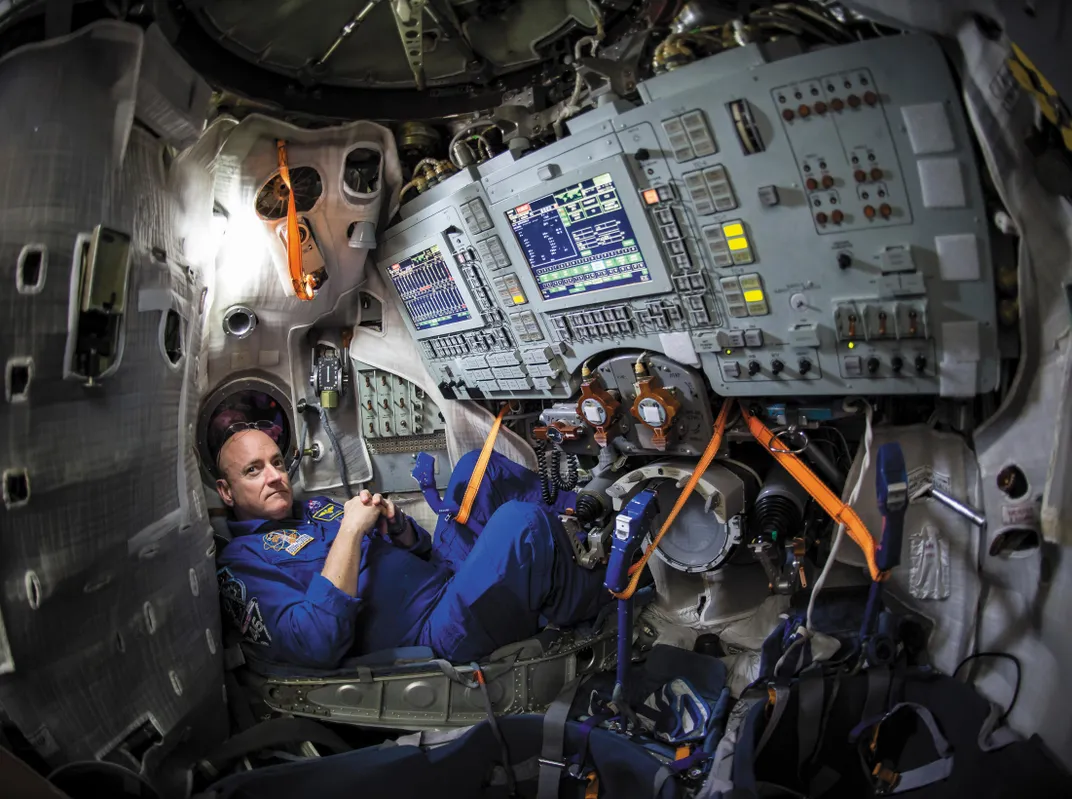
Another obvious hurdle is funding. How much will NASA prioritize research into metabolic stasis, both animal and human, when exploratory budgets are being reduced? Pete Worden, former director at NASA’s Ames Research Center in California and now the executive director of Breakthrough Starshot, says that with NASA’s emphasis on synthetic biology and the ability of organisms to survive and function in exotic environments like Mars, “it’s probably inevitable that the hibernation area is going to get funded.” That optimism is hardly universal. “People are frustrated,” says Yuri Griko, a Moscow-trained NASA radiobiologist and lead senior scientist in Ames’ space biosciences division. “When Sputnik was put up in space in 1957, our generation was so excited, so inspired, and we believed that we’d be on Mars in the millennium. But…we’re still not on Mars. It’s personal for people like me because we expected to be much more progressed than we are right now.” Griko acknowledges that metabolic suppression research is in limbo itself. He began at NASA in 2005 after spending five years at the biotech outfit Clearant, Inc., using ionizing radiation to inactivate pathogens in therapeutic blood products, transplant organs, and commercial biopharmaceuticals. NASA then invited Griko to research ways to protect astronauts from space radiation. It turns out that metabolic suppression is one of the most effective mechanisms nature provides. When animals go into hibernation their bodies survive radiation without significant damage to their cells. Griko believes metabolic suppression mitigates radiation-induced damage by reducing biochemical processes and excessive oxidative stress. Hypoxia—lower oxygen consumption—is one possible explanation for the radio-protective effect: In hypoxia, production of oxygen free radicals and hydroxyl radicals is reduced. Because ionizing radiation releases free radicals causing cell damage, suppressing metabolism and oxygen consumption appears to do the reverse: it reduces normal cell death and prolongs healthy cell life.This protective effect is even more pronounced at lower temperatures. Griko speculates that hibernation may also protect animals from the muscle atrophy and bone loss people typically experience in microgravity. Humans who eat a balanced diet while confined to bed rest for 90 days lose a little more than half of their muscle strength, Griko says. But bears that consume nothing and are confined to their dens for the same length of time or slightly longer lose only 25 percent of muscle strength and exhibit no signs of bone loss. He notes that animals capable of hibernation—tortoises and pocket mice—haven’t been flown in space in decades. NASA did not fund his request for flight experiments involving hibernating animals. His current research is limited to surveys of existing hibernation studies, along with his own laboratory work on stasis in mice, leeches, and snails. Griko proposed a 2015 international conference on torpor that would have brought together the world’s hibernation experts to discuss deep-space applications. NASA declined to fund it, though Griko still hopes to raise the money. “There are significant barriers to torpor research if we’re serious about going farther in space,” says Leroy Chiao, a former NASA astronaut and International Space Station commander who spent 193 days in orbit between October 2004 and April 2005. Animal research is a particularly sticky problem, one that has landed NASA in the crosshairs of animal-rights groups before. “Even research on simple primates starts getting people up in arms,” he says.
The Two-Planet Solution
Jason Derleth, a program executive with NASA Innovative Advanced Concepts in Washington, D.C., sees reason to hope. Under Derleth’s watch, NIAC has awarded two innovation grants since 2013, supporting one company’s detailed plans for torpor-enabled Mars transfer habitats. The project leader, SpaceWorks Enterprises, Inc., of Dunwoody, Georgia, about 20 miles north of Atlanta, is an aerospace design contractor for NASA and the Department of Defense and has done work in the development of tiny CubeSat satellite constellations. But it’s torpor that’s captured the imagination of SpaceWorks president and chief operating officer John Bradford. “I’ve asked myself for 15 years how to engineer materials, structures, and propulsion systems to enable a mission to Mars and its moons,” he says. Bradford is a Ph.D. aerospace engineer who has led several NASA, Defense Advanced Research Projects Agency, and Air Force Research Laboratory projects designing military spaceplanes. He was also a consultant on the 2016 science fiction film Passengers , wherein Jennifer Lawrence and Chris Pratt played interplanetary settlers who wake from hibernation early. “We’re not in the vein of an Apollo mission anymore—no more ‘flags and footprints,’ ” he says. “We need to become a two-planet species.”
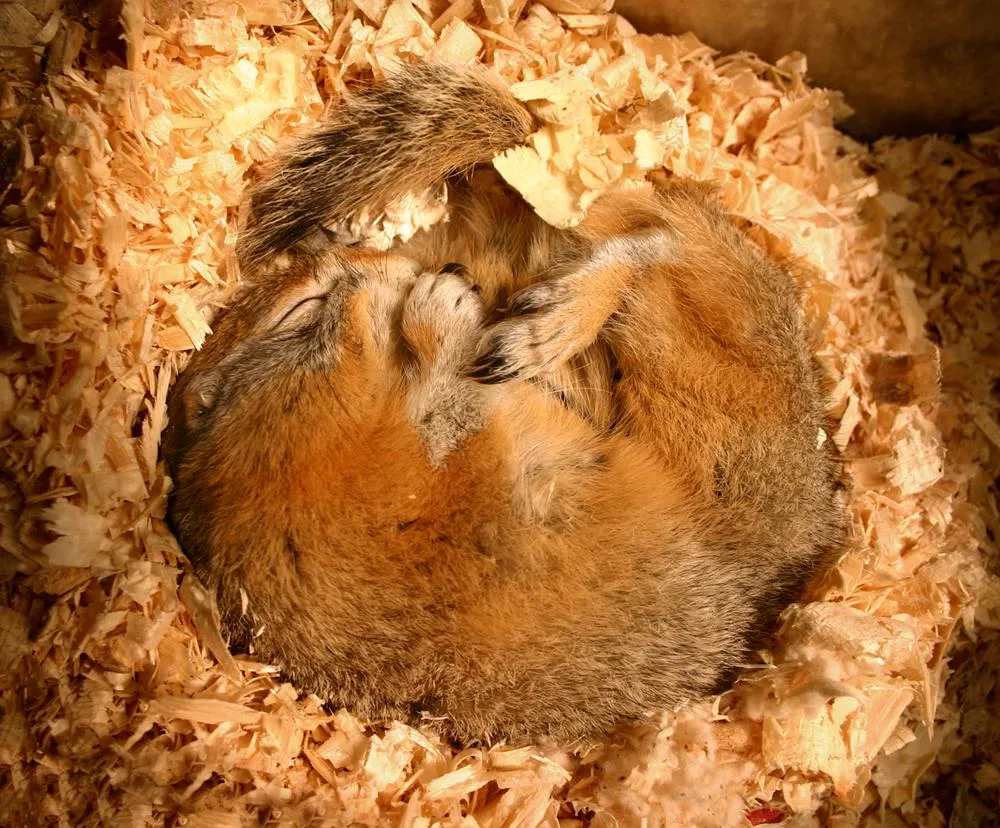
Bradford’s engineering and medical team used the first of those NIAC grants, issued in 2013, to design a compact zero-gravity, rigid-structure habitat based on the International Space Station crew module designs. The habitat featured closed-loop oxygen and water production systems, direct access to the Mars ascent and descent vehicles, and support for a crew of six, all of whom would be kept in torpor for the entire six- to nine-month Mars journey. The proposed medical treatment relies on using techniques similar to the ones surgeons perfected to induce hypothermia. For example, cooling nitrogen gas could be fed to astronauts via nasal cannula, lowering brain and body temperatures to between 89 and 96 degrees—close enough to normal to maintain torpor without overcooling the heart or increasing the risk of other complications. Cooling tends to decrease the body’s ability to clot, Tisherman says. He has also noted that patients who are cooled to mild levels of hypothermia—93 degrees—for 48 hours or more have more infections than uncooled people. In the SpaceWorks habitat, robotic arms in the module would be programmed to carry out routine chores, manipulate astronaut limbs, and check body sensors, urine evacuation lines, and chemical feeds. Robots would administer electrical stimuli to astronauts’ muscles to maintain tone, along with sedation to prevent a natural shivering response. The astronauts would also receive total parenteral nutrition, in which all nutrients—electrolytes, dextrose, lipids, vitamins, etc.—are administered via liquid through a catheter inserted in the chest or the thigh. SpaceWorks outfitted TPN supplies in the experimental module to last 180 days; should the habitat be required for a prolonged Martian stay, the module would have another 500 days’ worth of nutrition. In all, the SpaceWorks Mars Transfer Habitat reduced total habitat mass, including consumables, to 19.9 tons (low-Earth-orbit weight). By comparison, NASA’s TransHab habitat, with consumables specified in the agency’s Mars Design Reference Architecture 5.0, weighs 41.9 tons. That’s a 52 percent decrease in mass. Compared with the NASA model, SpaceWorks was able to shrink total habitat consumables by 70 percent. NIAC officials were intrigued. “SpaceWorks made an interesting proposal,” Derleth says. “People have been studying torpor for medical applications. But no one as far as we could find is actually doing an engineering study of what cryo-sleep or torpor would actually do to the architecture of a mission.” In 2013 NIAC awarded SpaceWorks a Phase 1 grant of $100,000 to develop a rough torpor-enabled architecture for exploration-class missions—those with four to eight crew members heading to Mars or its moons. But the agency balked at the idea of putting all crew members in torpor for the entire journey. What about medical or spacecraft complications? How long could astronauts stay under without psychological or physical damage? What if some complication required their premature awakening? What about the slow waking and warming times to get the astronauts out of hibernation? These questions sent the SpaceWorks team back to work. They designed a crew habitat for torpor that would keep at least a few astronauts awake on a rotating basis for piloting and interventions (as in the 1968 movie 2001 , in which two crew members of the Jupiter-bound spacecraft Discovery remain awake while the others sleep). Then Bradford’s team moved further. Designing three interconnected habitat modules for a 100-passenger “settlement class” Mars mission—colonists, in other words—the team produced a spacecraft and habitat that departed completely from anything in NASA’s plans. The SpaceWorks settlement-class craft includes two compact, rotating habitat modules, each accommodating 48 passengers in torpor. Rotation at varying speeds would produce artificial gravity to mitigate astronauts’ bone loss. But in the bolder “sentry mode” proposal, a separate habitat module would accommodate four care-taking astronauts on duty throughout the mission. One or more could be rotated with others in torpor to keep crews fresh. “You get 80 percent of the benefits by cycling through the hibernating crew and waking some up, rather than turning out the lights on everybody for six months,” Bradford says. Spacecraft accommodating settlers in torpor would be lighter, which would enable much greater velocities, shorter voyages, and, possibly, more efficient radiation shielding because of the radio-protective effect of metabolic stasis. Further, Bradford says, hibernating astronauts wouldn’t experience motion sickness, a common problem on the International Space Station.
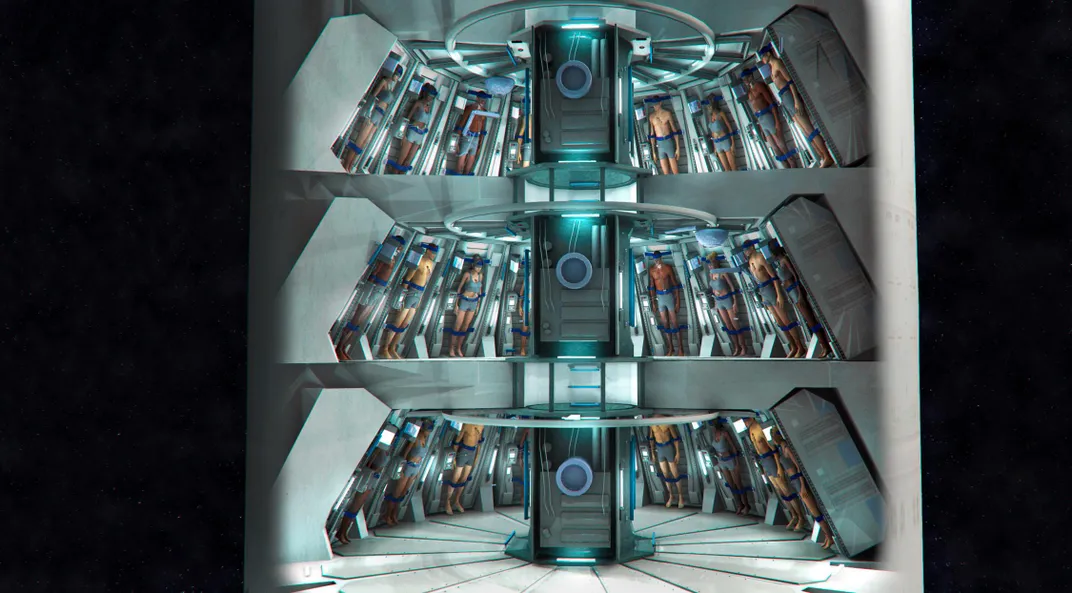
Sleep Like a Bear
But what would torpor in space feel like? Not like being frozen dead in cryogenics, then being revived, according to Doug Talk, an obstetrician and SpaceWorks consultant who has used therapeutic hypothermia to treat oxygen-deprived babies. “[Cryogenics] has had zero success with that,” Talk says. “The human body isn’t meant to be frozen; it’s mostly water, and when water expands [as it does when it freezes], it produces cellular damage.” More likely, astronaut torpor will be like coma, a state hovering between dreamless sleep and semi-conscious awareness. “Coma patients display cycles of brain activity that alternate between seeming wakefulness and non-REM sleep,” Talk explains. Even though coma patients are unable to move, their brains remain active and even responsive to outside stimuli, including verbal commands. Bears experience hibernation in similar ways; their core temperature drops only a few degrees (similar to the mild-hypothermia temperature range in humans), while their metabolism drops 75 percent. Bears in northern climates can remain in torpor for seven to eight months without eating or drinking, and pregnant female bears will give birth to their young and nurse them even while in hibernation. “Someone in torpor will act like the bear does,” Talk theorizes. “They’ll cycle through non-REM sleep and being awake. And like bears when they finally wake up, they’ll be sleep deprived.” In May 2016, NIAC approved a second phase of the SpaceWorks project, this time releasing $250,000 to extend first-phase engineering, operational, and medical research plans. “Phase 1 projects have proven that what they’re talking about is real,” Derleth says. “We’re very happy to see Dr. Bradford’s progress.” In addition to habitat engineering refinements, the SpaceWorks team initially proposed a two- to three-week hibernation test with a small number of healthy pigs. Pigs, like humans, are natural non-hibernators; therefore their physiological responses to torpor induction will offer better clues to what humans may expect than studies of mice or snails, obviously. Derleth says agency regulations prevented NASA from funding the pig study. So SpaceWorks submitted an alternate proposal: to research existing metabolic suppression experiments comprehensively in order to establish a near-term road map for technology development, including more-methodical animal research leading to human trials. This summer, NIAC will conduct a mid-term review of SpaceWorks’ progress and determine whether to award them an additional $250,000. “We continue to believe that live-subject research will be necessary to advance this torpor technology toward longer durations,” SpaceWorks founder and CEO John Olds wrote in a follow-up email. “That step may require private sponsors.” Regardless of who pays for it, testing with animals can be difficult to do because it continues to raise ethical questions. “I think NASA is right: Slow is the way to go,” says Arthur Caplan, director of the division of medical ethics at New York University Langone Medical Center. While there’s enthusiasm for suspended animation for long durations in space, NASA doesn’t need any more troubles from animal rights activists, in his opinion. “Pigs are somewhat physiologically similar to humans, so pigs are a reasonable animal model for testing,” says Caplan. “Though it’s fair to say to critics: The number of pigs involved in this kind of study wouldn’t amount to one’s week’s breakfast for the average American.”
The Human Factor
Sci-fi movies and novels have romanticized torpor, Caplan says, suggesting humans could move in and out of that coma-like state without difficulty. That might not be the case. The humans in which torpor will first be tested will be unusual people—most likely test pilots, Caplan predicts. “These people take risks every day; they understand the physiological risks because they test jets and know many colleagues who have died. I’ve had astronauts tell me they’ll enroll in any experiment just to get into space. Our job is to rein them in.”
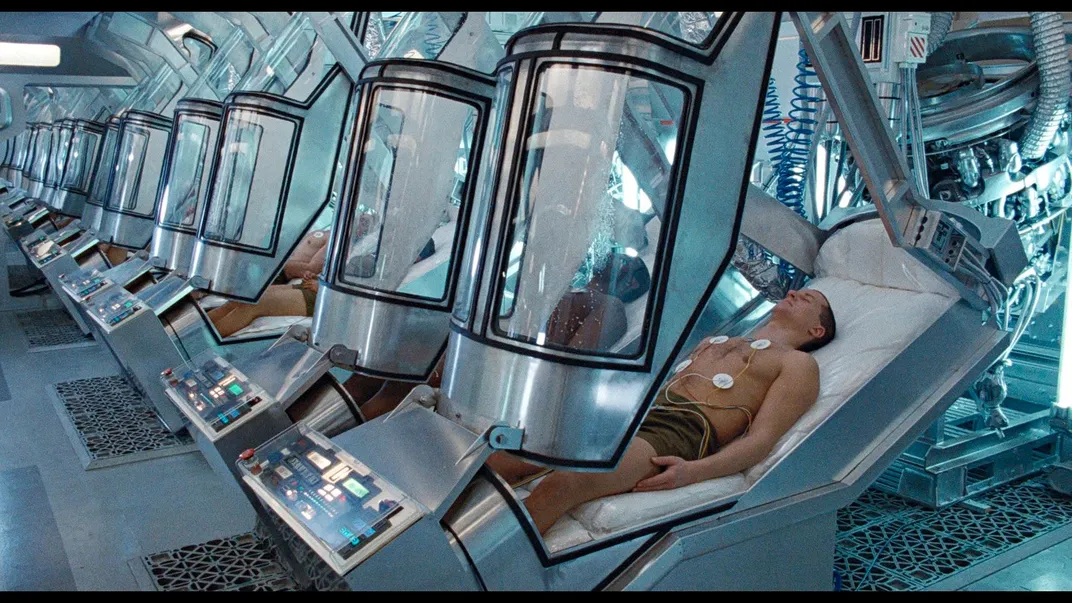
Human trials would be an unprecedented step. No one has ever tried to use hypothermia to suppress the metabolism of a person who wasn’t severely sick or injured, much less super-healthy astronauts. “We’ve had lots of healthy people who have volunteered for long-term torpor experiments,” Talk says. “There’s a pent-up demand for people who want to punch out of life for six months. I’m sure the FDA wouldn’t approve of that.” Meanwhile, Talk has invited two experts on therapeutic hypothermia—Alejandro Rabinstein, the medical director of the neuroscience intensive care unit at the Mayo Clinic, and Kelly Drew, a University of Alaska Fairbanks neuroscientist investigating animal hibernation—to join SpaceWorks’ research team. Drew and other scientists at the University of Alaska’s Institute of Arctic Biology are studying the hibernation patterns of endothermic animals like hedgehogs, Arctic ground squirrels, and bears. Their hope is to find the key to a healthy hibernation state—and the signaling cascade in the brain that induces it—that could be adapted to human astronauts without side effects. The Arctic ground squirrel, for example, cools itself to 32 degrees Fahrenheit in winter. No scientist understands exactly what triggers its hibernation, although a particular brain and muscle receptor—the A1 adenosine receptor—appears to make the squirrel grow cold and sleepy, only to emerge with minimal bone and muscle loss eight months later. “Adenosine is a neuromodulator that plays a role in sleep and in reducing brain excitability,” Drew says. “It’s ubiquitous in animal brains.” She has induced hibernation in Arctic ground squirrels by using a drug to stimulate their A1 adenosine receptors. Drew can also wake squirrels up from hibernation by using another drug to block the same receptor. But the signaling cascade and genetic makeup of humans are far more complex and difficult to decipher. Adding to the complexity of the task is the fact that not all hibernators hibernate the same way. The only primate known to do it, Madagascar’s fat-tailed dwarf lemur, spends seven months a year in torpor, mostly in hot weather; it survives by consuming fat stored in its tail. Low metabolic rates in animals do not require low body temperatures. Meanwhile, Rabinstein, who plans to help SpaceWorks evaluate mild hypothermia to induce torpor, says the techniques that work in an ICU might not be so reliable in space. “The fact that little children have ‘drowned’ and survived in ice ponds and lakes is remarkable and has given us hope,” he says. “But can we transform this [understanding of deep hypothermia] into a more mild degree of hypothermia and allow people to tolerate it for a longer period of time and get away with it, without psychological or physiological stress? We have to see, but we think there is a chance.”
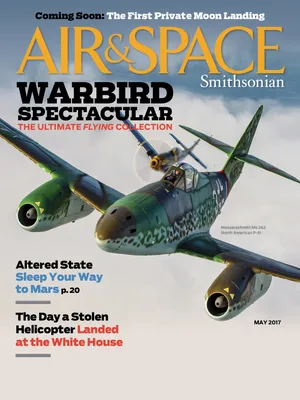
Subscribe to Air & Space Magazine Now
This story is a selection from the April/May issue of Air & Space magazine
Get the latest stories in your inbox every weekday.
Arielle Emmett | READ MORE
Contributing Editor Arielle Emmett has reported from China, Hong Kong, Italy, and Indonesia. She writes about Chinese aviation and aerospace, next-generation sustainable flight and gender equality in the cockpit.

NASA astronauts arrive at space center in T-38 Talon jets ahead of history-making Starliner launch: All the best pictures
Posted: April 26, 2024 | Last updated: April 26, 2024
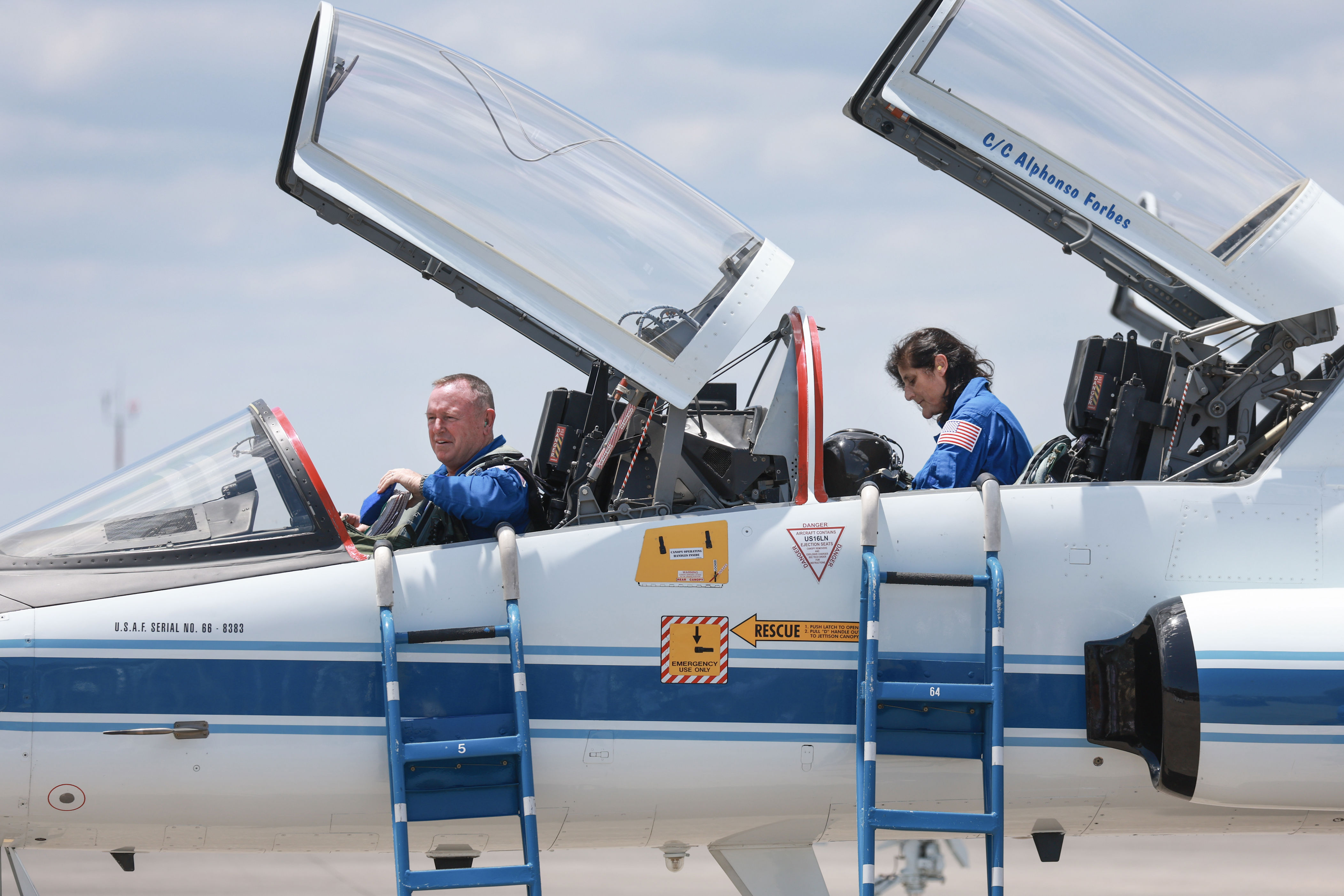
Two veteran NASA astronauts are about to mark an exciting new first in space travel.
In the coming days, the much-delayed Boeing Starliner spacecraft will launch with humans on board for the first time: Commander Butch Wilmore and Pilot Suni Williams. The capsule will travel to the International Space Station atop an Atlas V rocket that's set to blast off from Cape Canaveral Space Force Station's Space Launch Complex 41 on May 6.
Join us as we look at the best photos of the astronauts arriving to prepare for thie history-making launch, and see what the new Starliner capsule looks like...
NASA's Boeing Crew Flight Test Commander Butch Wilmore and Pilot Suni Williams arrived at the Kennedy Space Center in Cape Canaveral, Florida, in a T-38 jet on April 25, 2024. They flew in for a mission aboard the Boeing Starliner that will take them to the International Space Station. That launch is set to depart from the Cape Canaveral Space Force Station on May 6, 2024.
Keep reading for more great pics...
MORE: Follow Wonderwall on MSN for more fun celebrity & entertainment photo galleries and content

Boeing's CST-100 Starliner spacecraft was rolled out of the Commercial Crew and Cargo Processing Facility at the Kennedy Space Center to be transported to pad 41 at Cape Canaveral Space Force Station in Cape Canaveral, Florida, on April 16, 2024.
Starliner is scheduled for its first crewed launch to the International Space Station on a ULA Atlas V rocket with NASA astronauts Suni Williams and Butch Wilmore on May 6, 2024.
MORE: NASA unveils new supersonic aircraft: All the best pictures

NASA's Boeing Crew Flight Test Commander Butch Wilmore and Pilot Suni Williams prepared to address the media after arriving at the Kennedy Space Center in Cape Canaveral, Florida, in a T-38 jet on April 25, 2024.
They flew in for a mission aboard the Boeing Starliner that will take them to the International Space Station.
That launch is set to depart from the Cape Canaveral Space Force Station on May 6, 2024.
MORE: SpaceX Falcon 9 rocket cargo arrives at International Space Station: All the best launch pictures
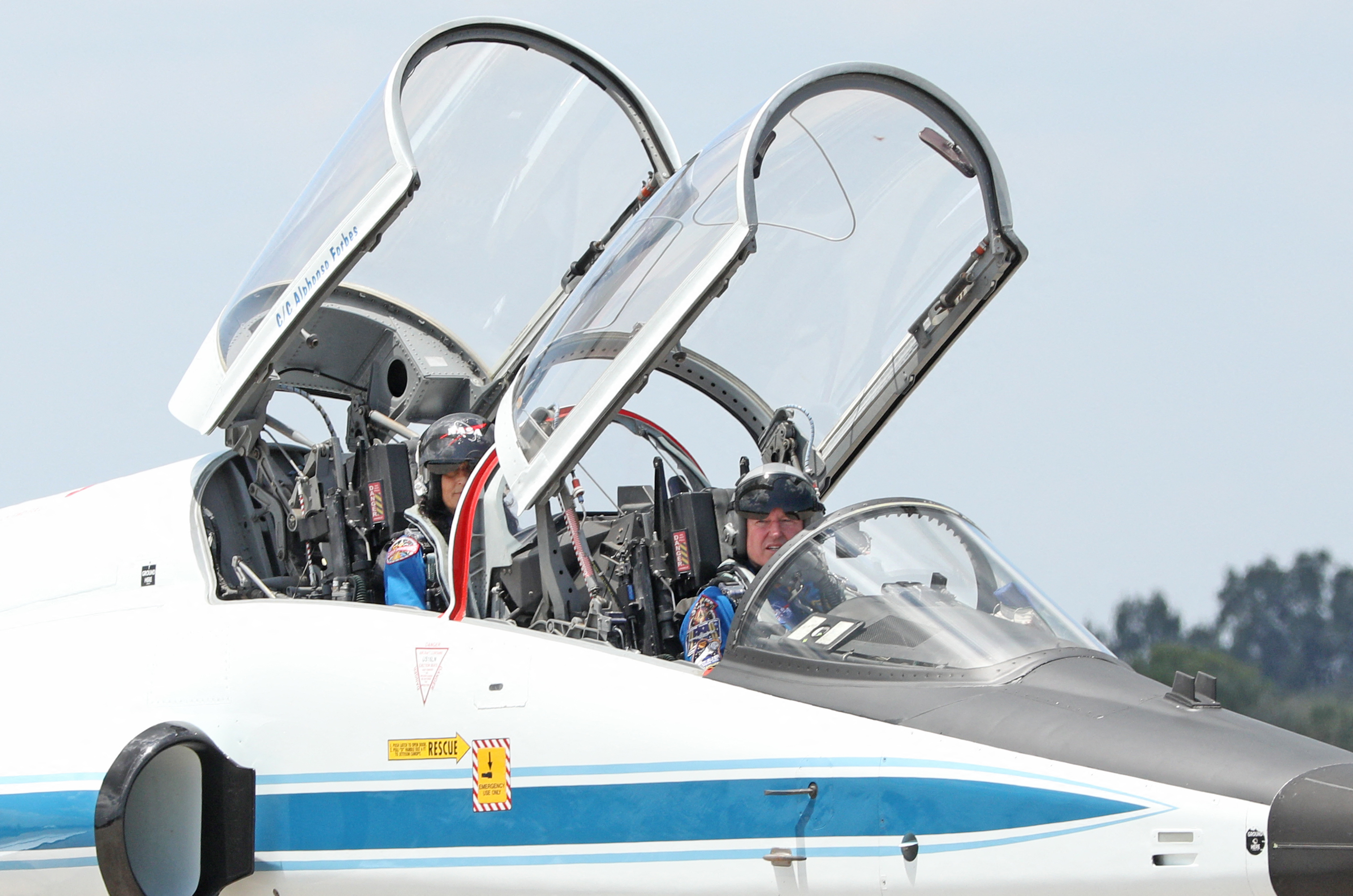
NASA astronauts Suni Williams and Butch Wilmore arrived at the Kennedy Space Center in Cape Canaveral, Florida, on April 25, 2024, aboard a T-38 Talon jet for their next mission: A United Launch Alliance (ULA) Atlas V rocket will ferry them in a Boeing CST-100 Starliner capsule on its historic first crewed flight of the new spacecraft on May 6.
Williams and Wilmore will also be the first humans launched into space aboard an Atlas V rocket.
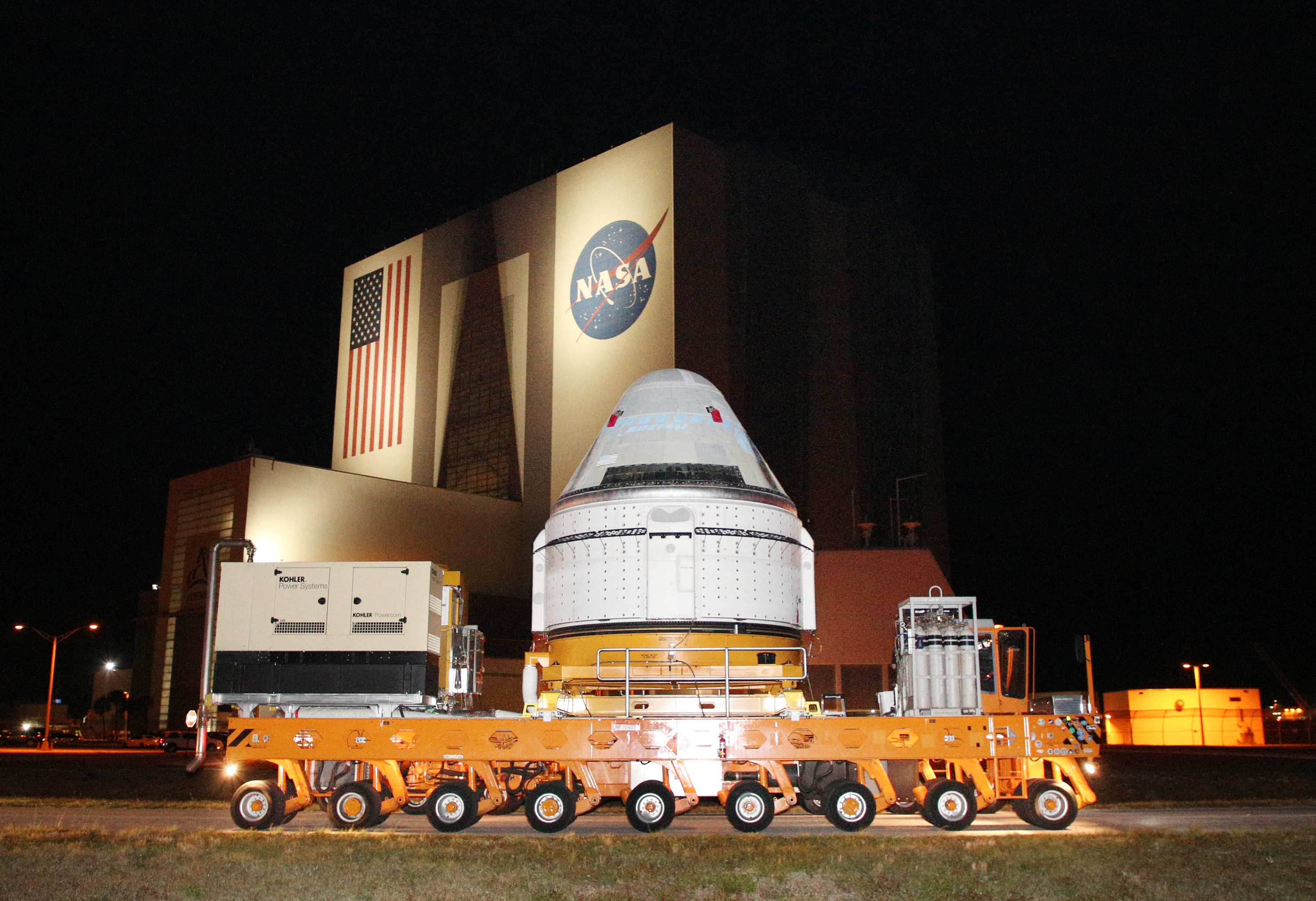
A Boeing CST-100 Starliner spacecraft was rolled out from Boeing's Commercial Cargo and Processing Facility in the pre-dawn hours of April 16, 2024, past the Vehicle Assembly Building at the Kennedy Space Center in Cape Canaveral, Florida.
NASA is targeting a May 2024 launch for the Crew Flight Test-1 (CFT-1) mission to the International Space Station with astronauts Barry Wilmore and Sunita Williams.
A United Launch Alliance (ULA) Atlas 5 rocket will ferry the Boeing capsule on its historic first flight of the new, crewed spacecraft.

NASA's Boeing Crew Flight Test Commander Butch Wilmore and Pilot Suni Williams posed to a photo while greeting the media following their arrival at the Kennedy Space Center in Cape Canaveral, Florida, in a T-38 jet on April 25, 2024.
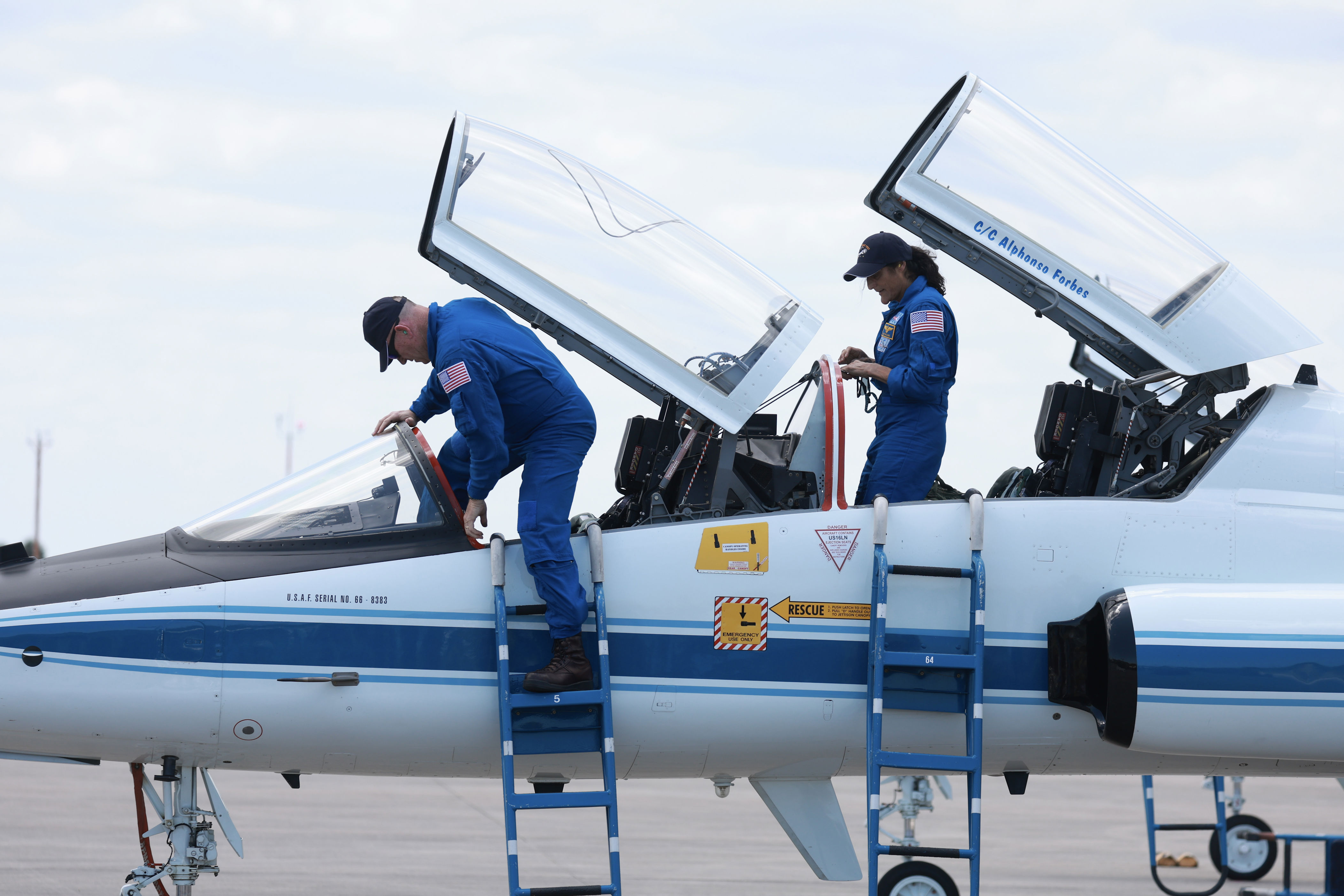
NASA's Boeing Crew Flight Test Commander Butch Wilmore and Pilot Suni Williams arrived at the Kennedy Space Center in Cape Canaveral, Florida, in a T-38 jet on April 25, 2024.

NASA astronauts Suni Williams and Butch Wilmore flew in the lead jet -- a T-38 Talon -- and landed at the Kennedy Space Center in Cape Canaveral, Florida, on April 25, 2024, ahead of their next mission: A United Launch Alliance (ULA) Atlas V rocket will ferry the Boeing CST-100 Starliner capsule on its historic first crewed flight of the new spacecraft on May 6.
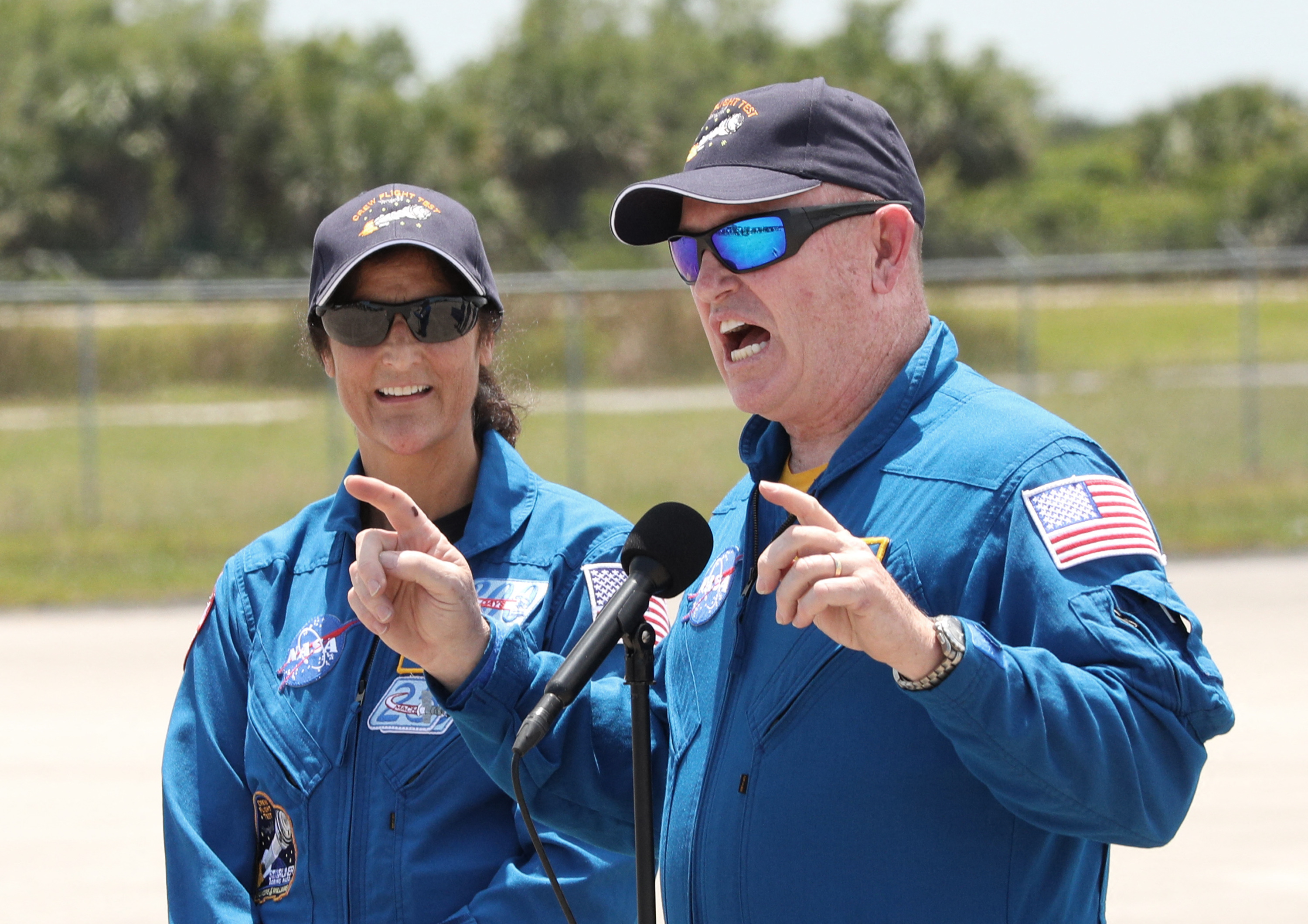
NASA astronauts Butch Wilmore and Suni Williams spoke to the media at the Kennedy Space Center in Cape Canaveral, Florida, on April 25, 2024, after arriving via T-38 jets.
The pair will fly on the Crew Flight Test-1 (CFT-1) mission to the International Space Station, set for May 6, 2024.
A United Launch Alliance (ULA) Atlas V rocket will ferry the Boeing CST-100 Starliner capsule on its historic first crewed flight of the new spacecraft.
Wilmore and Williams will also be the first humans launched into space aboard an Atlas V rocket.
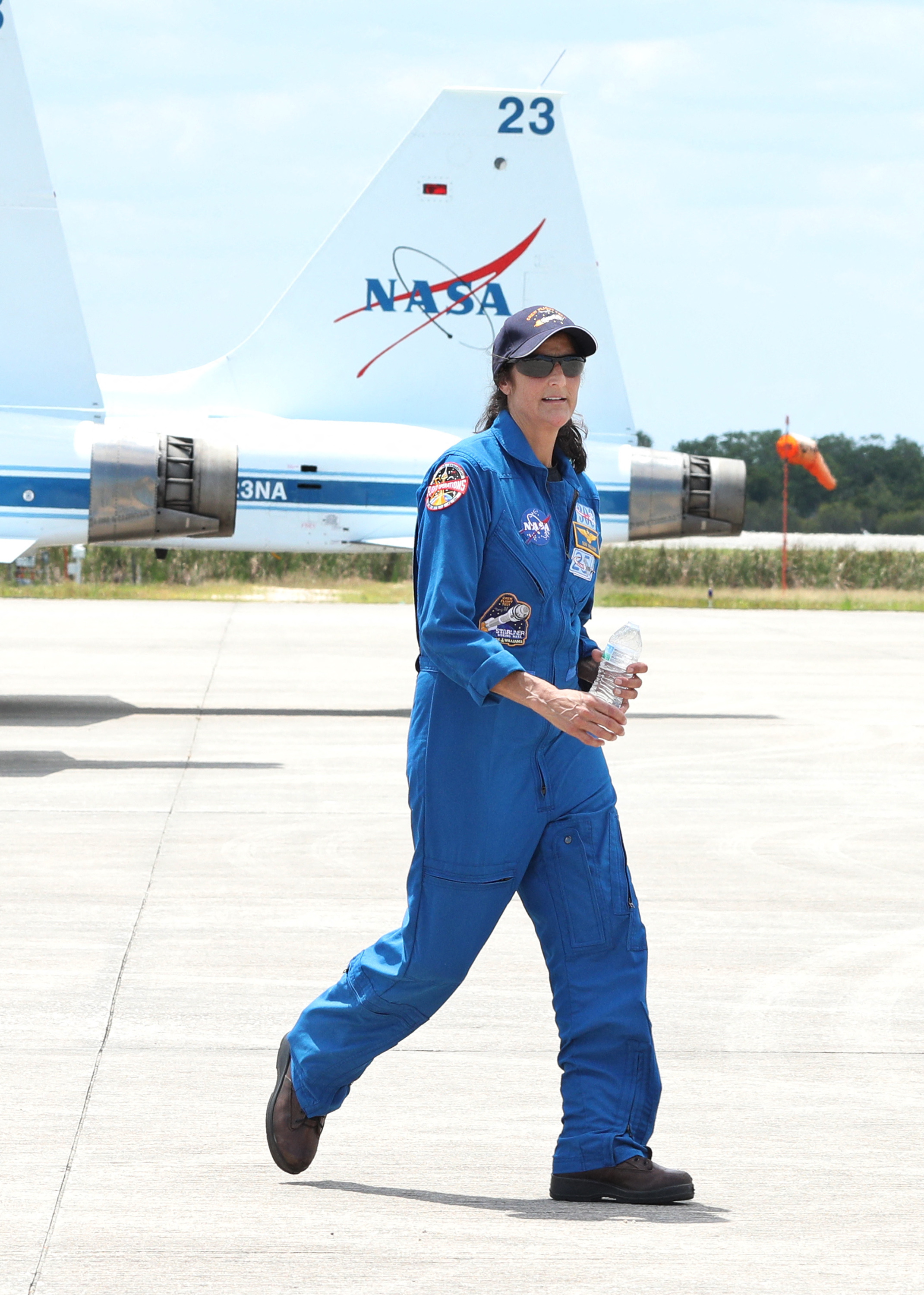
NASA astronaut Suni Williams flew herself in a T-38 Talon jet to the Kennedy Space Center in Cape Canaveral, Florida, on April 25, 2024.
She's there to next fly on the Crew Flight Test-1 (CFT-1) mission to the International Space Station, set for May 6.
Williams will also be one of the first humans launched into space aboard an Atlas V rocket.
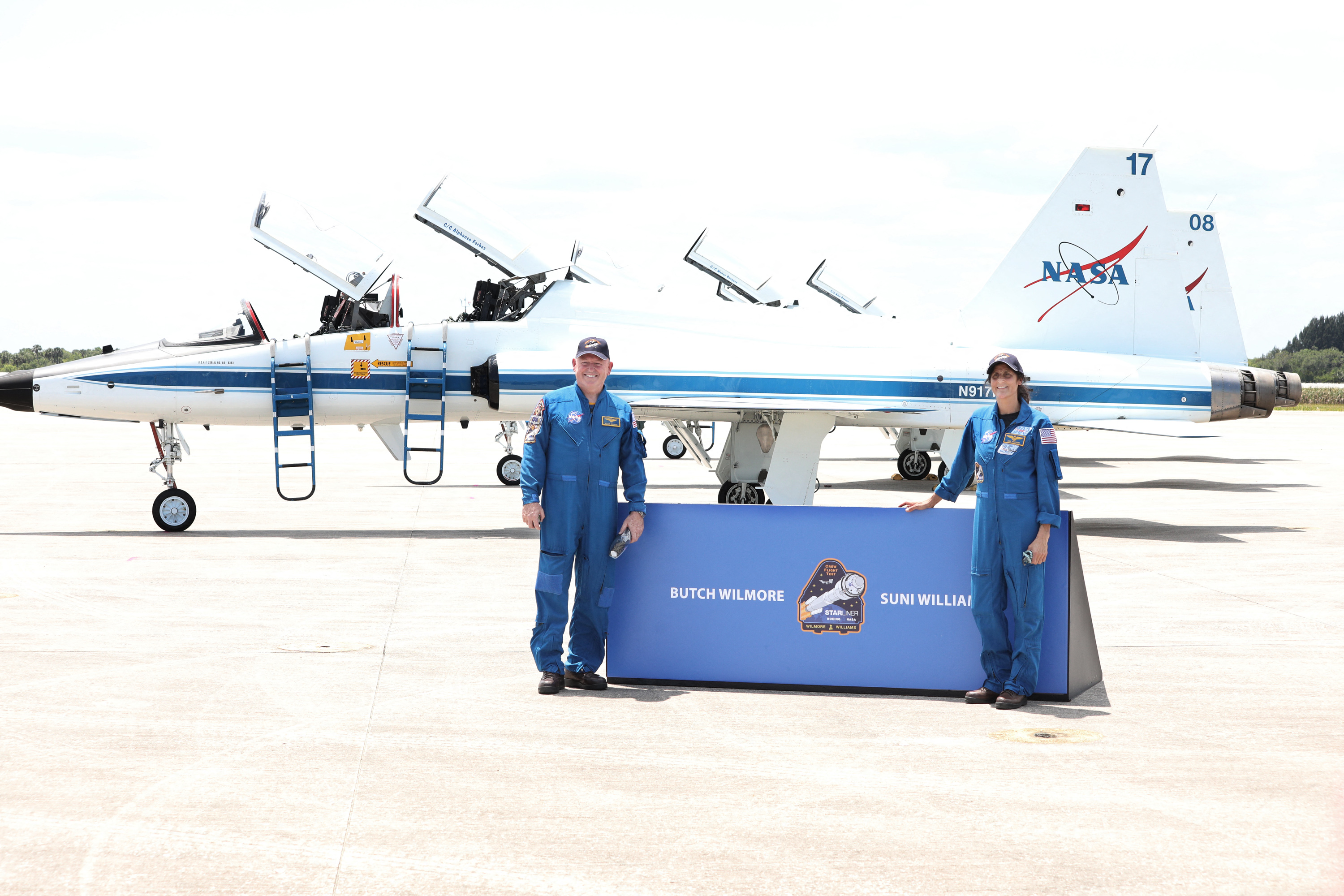
NASA astronaut Suni Williams arrived at the Kennedy Space Center in Cape Canaveral, Florida, on April 25, 2024, in a T-38 Talon jet she piloted.
She's there for a mission aboard a Boeing Starliner that's headed to the International Space Station and set to launch on May 6, 2024.
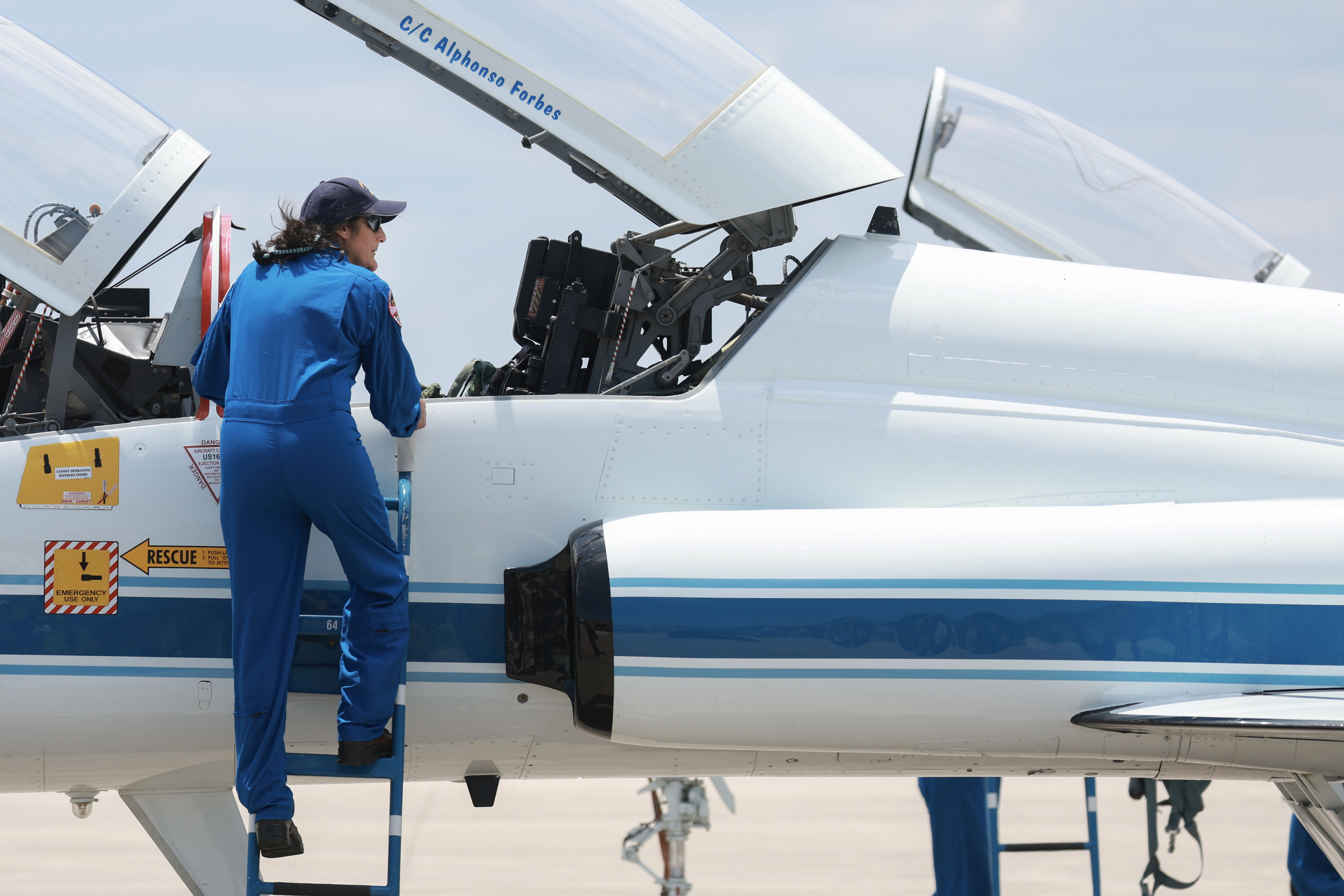
The Boeing CST-100 Starliner capsule launched atop a rocket at dusk from the United Launch Alliance complex 41 at Cape Canaveral Space Force Station in Florida on May 19, 2022. This mission was unmanned.
More for You
US Navy Most Feared Jet Shoots Off From Aircraft Carrier Like a Rocket
Republicans Given Ultimatum About Trump
"He never played again for us" - When Dan Hurley and Tristan Thompson got into a heated exchange
How Do I Know If My Dog Is Happy? 12 Signs of a Happy Dog
Do I have to pay off my spouse's debts when they die? Here's what you're responsible for and what you aren't after a loved one's death
Age at which you're officially old has changed
I want to retire a millionaire, so I showed my portfolio to a financial planner and he said 4 mistakes are holding me back
Skilled US Sniper Takes Out Floating Targets From Fast Moving Helicopter at Sea
The Trump Trial Takes a Turn
This small U.S. town is considered the best place to retire. Here's why.
LeBron James Taking Heat For "It's Just Basketball" Comments After NBA Playoff Loss To Nuggets
Netflix’s new movie trailer slammed as ‘AI propaganda’
The Greatest Heroines of All Time
See the UK destroyer crew that scored the Royal Navy's first missile kill since the Gulf War
Saudi Arabia Spent $500B to Build a Futuristic City in the Desert, Now Reality Is Setting In
Normani Is Dropping the Damn Album
Should you avoid living in a 55-plus community? Here are 5 big problems with adult retirement communities in America
The 43 Best Shows to Stream on Netflix Right Now
Joel Embiid And LeBron James' Flopping Videos Against Knicks And Nuggets Go Viral
Corn Makes This Pasta Sauce So Silky Smooth, Without Any Cream

Science Instruments
Perseverance’s science instruments are state-of-the-art tools designed to acquire information about Martian geology, atmosphere, environmental conditions, and potential biosignatures.
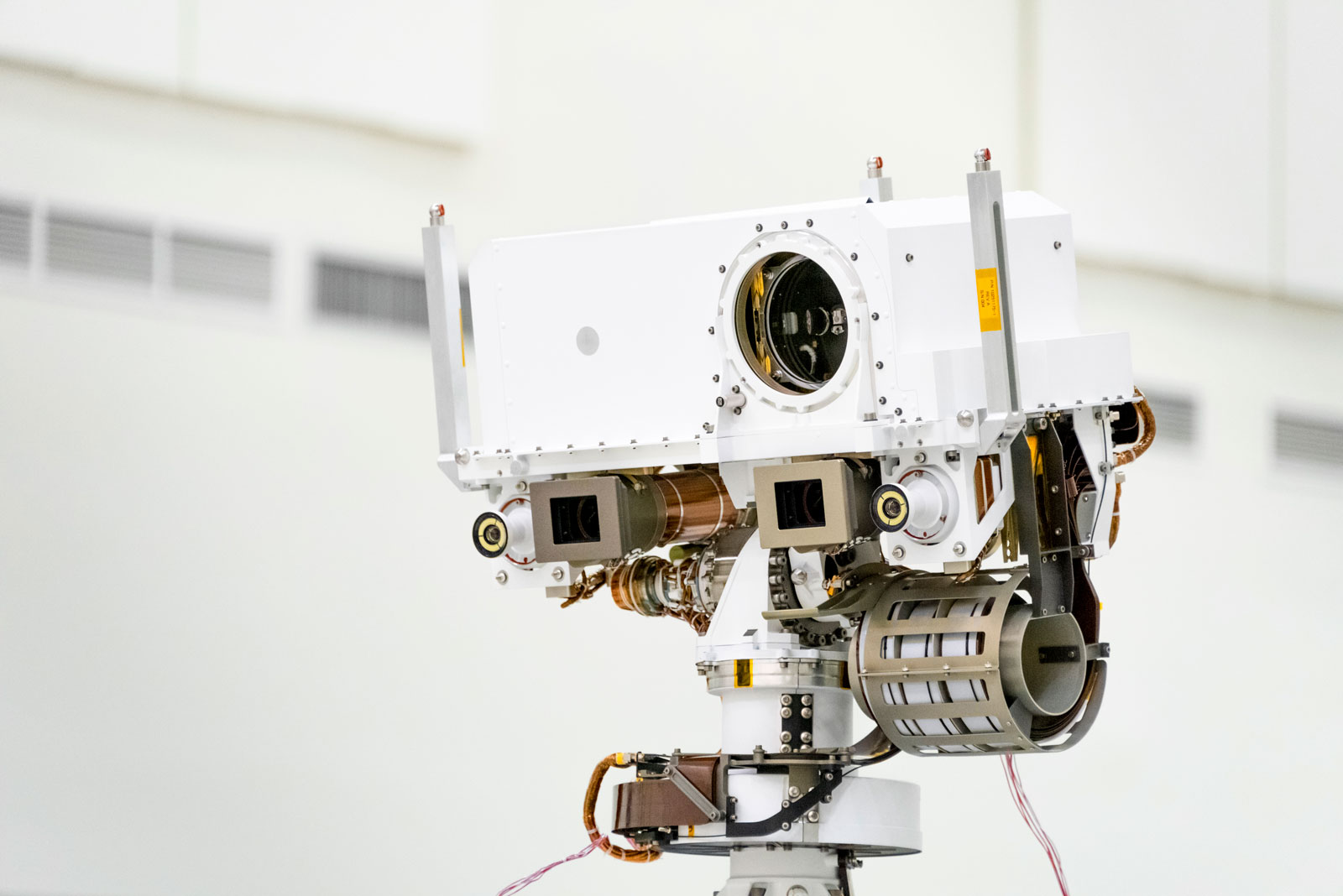
The Mastcam-Z is the name of the mast-mounted camera system that is equipped with a zoom function on the Perseverance rover. Mastcam-Z has cameras that can zoom in, focus, and take 3D pictures and video at high speed to allow detailed examination of distant objects.
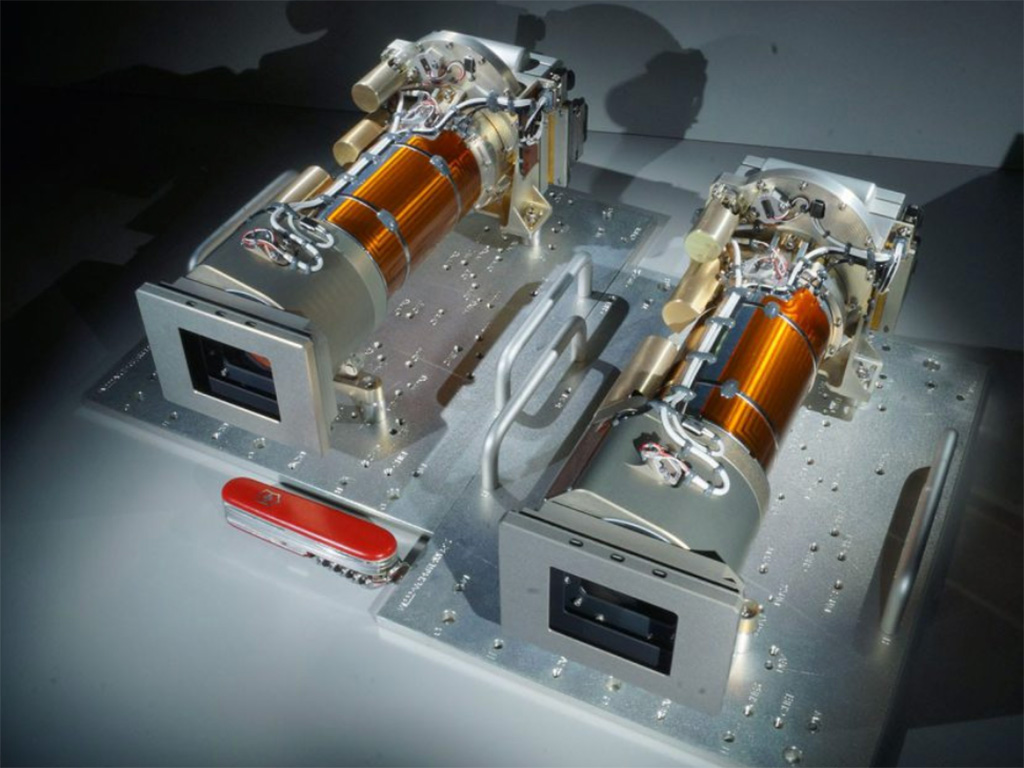
The SuperCam on the Perseverance rover examines rocks and soils with a camera, laser, and spectrometers to seek chemical materials that could be related to past life on Mars. It can identify the chemical and mineral makeup of areas on Mars as small as a pencil point, from a distance of more than 20 feet (7 meters). This instrument also has a significant contribution from the Centre National d'Etudes Spatiales, Institut de Recherche en Astrophysique et Planétologie (CNES/IRAP) France.
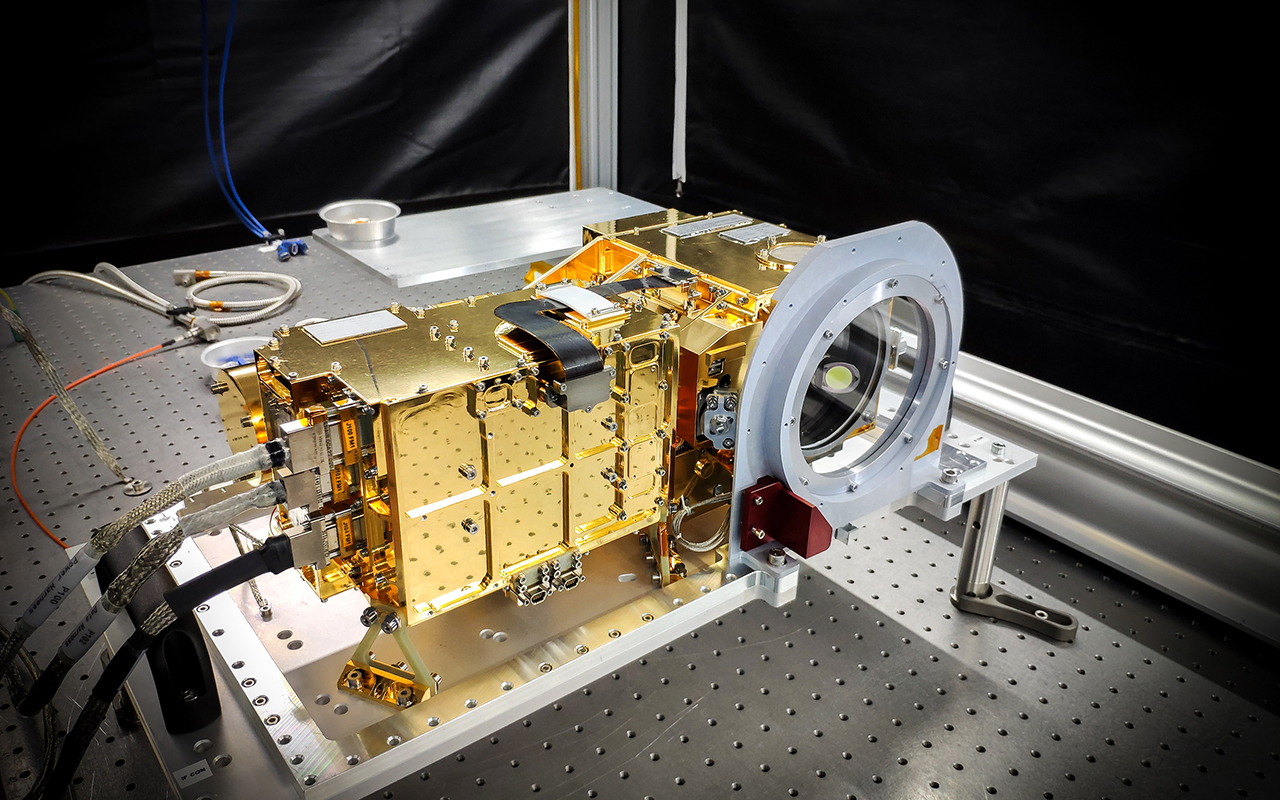
Spectrometer
Scanning Habitable Environments with Raman & Luminescence for Organics & Chemicals
Mounted on the rover's robotic arm, SHERLOC uses cameras, spectrometers, and a laser to search for organics and minerals that have been altered by watery environments and may be signs of past microbial life. In addition to its black-and-white context camera, SHERLOC is assisted by WATSON, a color camera for taking close-up images of rock grains and surface textures.
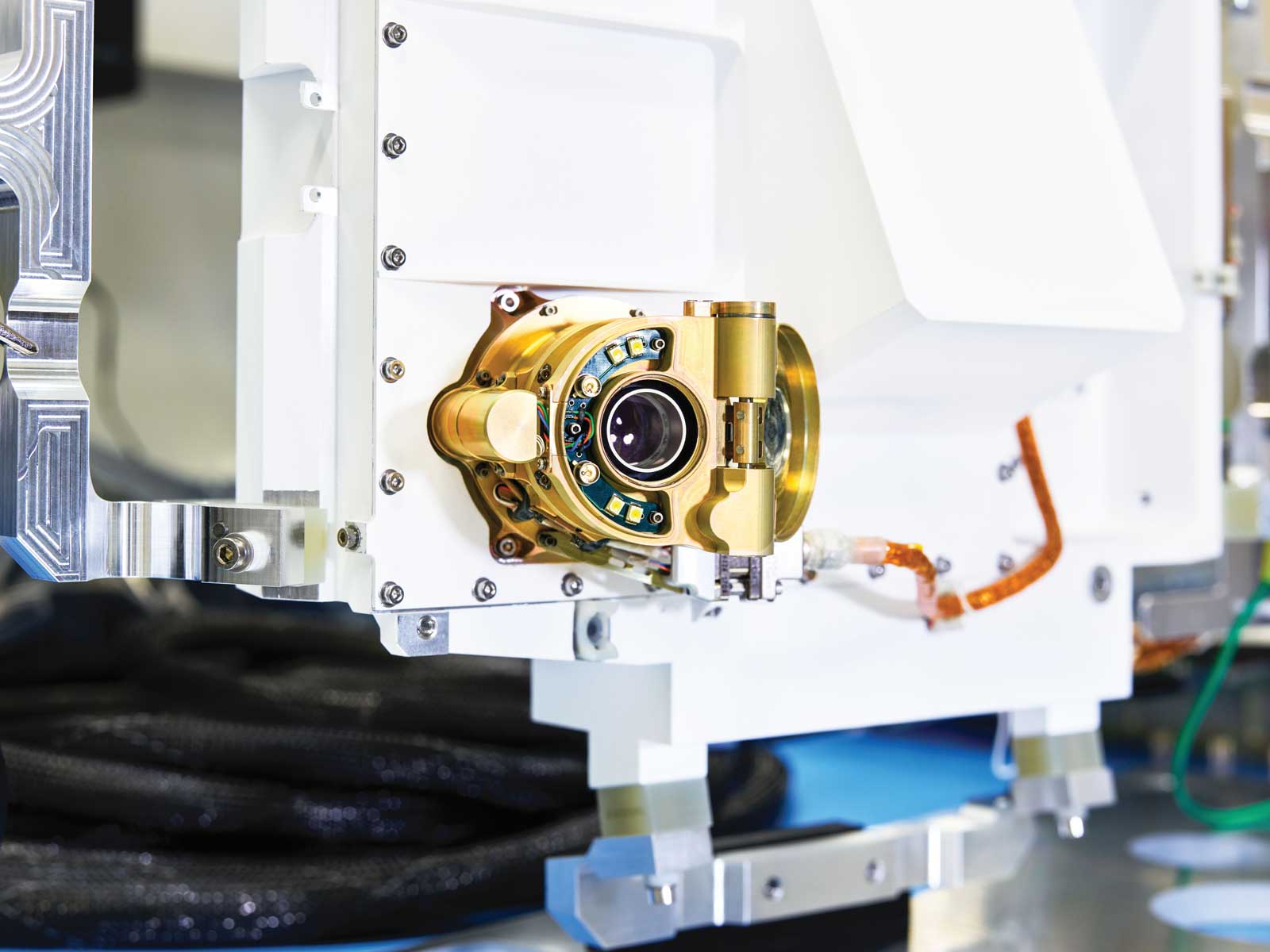
Planetary Instrument for X-ray Lithochemistry (PIXL)
The Planetary Instrument for X-ray Lithochemistry is called PIXL. PIXL has a tool called an X-ray spectrometer. It identifies chemical elements at a tiny scale. PIXL also has a camera that takes super close-up pictures of rock and soil textures. It can see features as small as a grain of salt! Together, this information helps scientists look for signs of past microbial life on Mars.
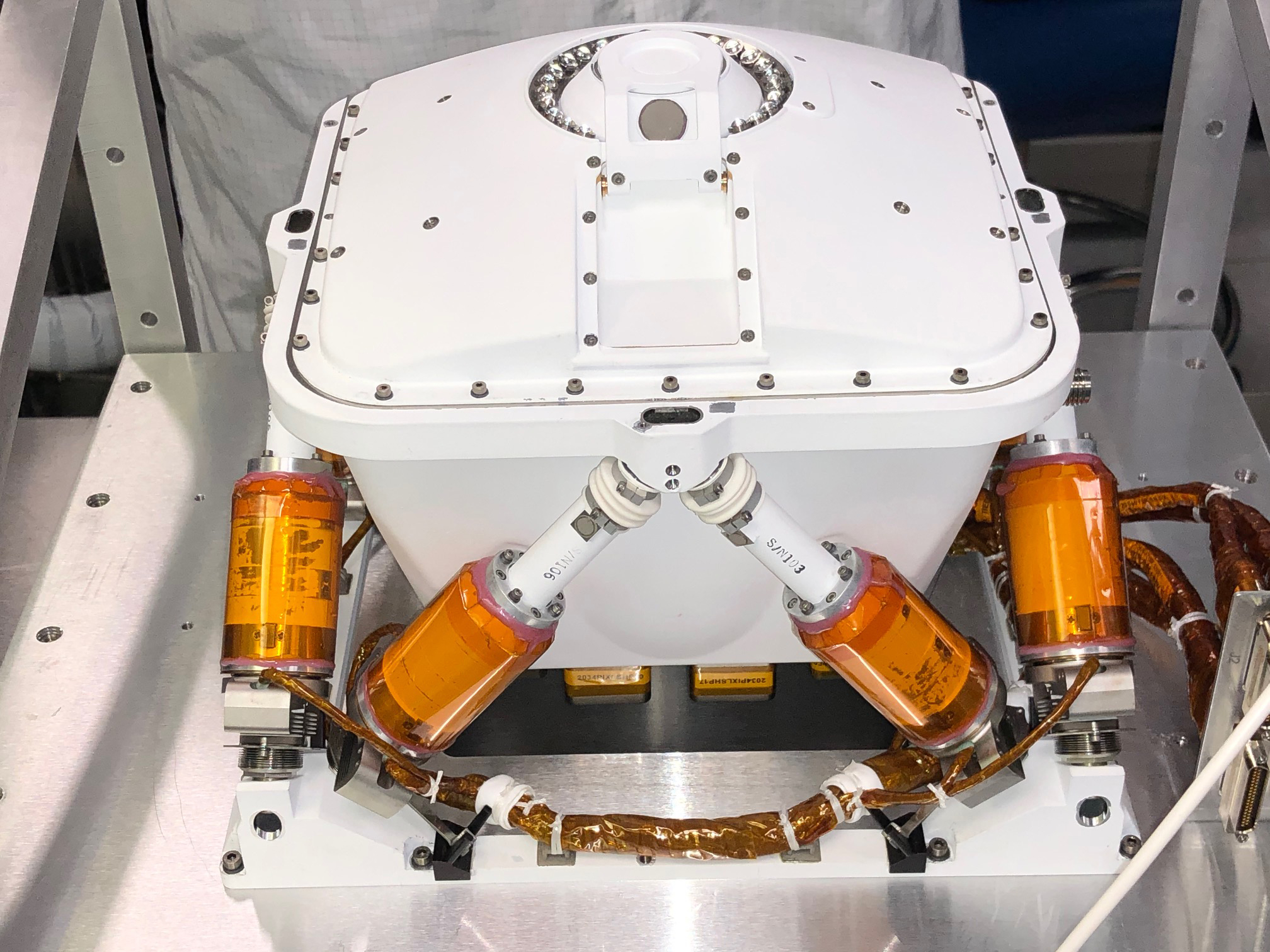
Environmental Sensors
Mars environmental dynamics analyzer (meda).
The Mars Environmental Dynamics Analyzer is known as MEDA. It makes weather measurements including wind speed and direction, temperature and humidity, and also measures the amount and size of dust particles in the Martian atmosphere.
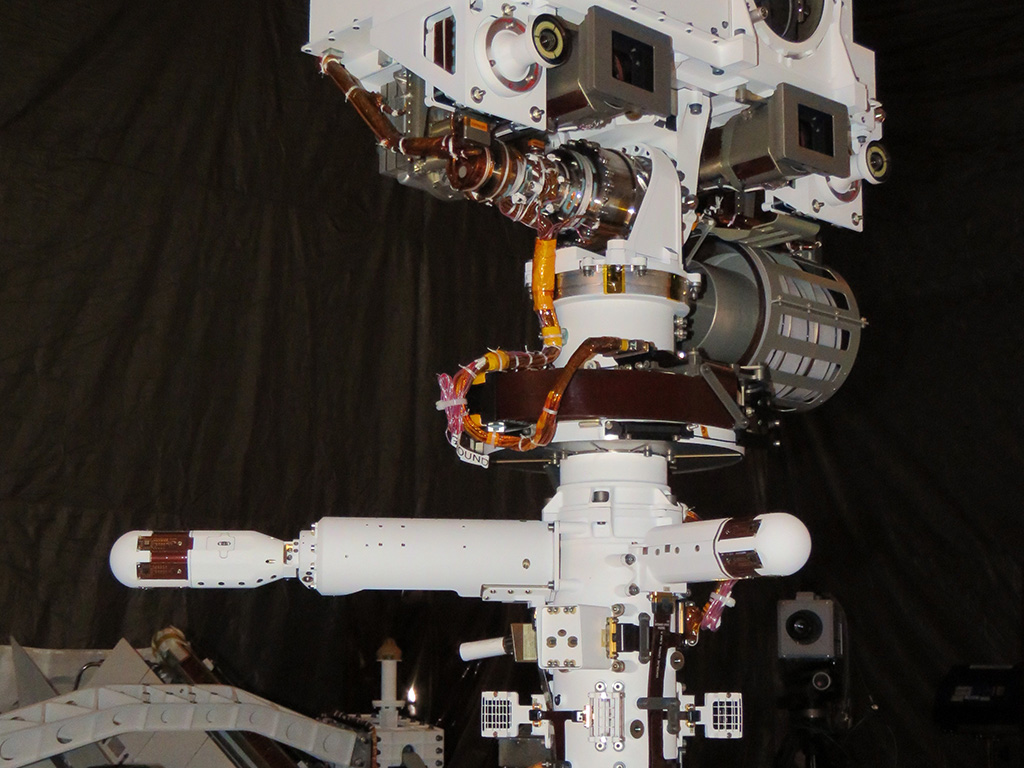
Mars Oxygen ISRU Experiment (MOXIE)
The Mars Oxygen In-Situ Resource Utilization Experiment, or MOXIE, is helping NASA prepare for human exploration of Mars. MOXIE tested a way for future explorers to produce oxygen from the Martian atmosphere for burning fuel and breathing.
Radar Imager for Mars' Subsurface Experiment (RIMFAX)
RIMFAX uses radar waves to probe the ground under the rover.
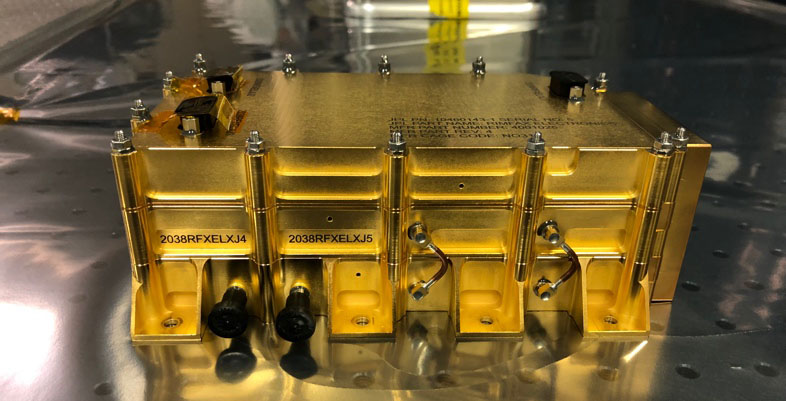
Discover More Topics From NASA
James Webb Space Telescope

Perseverance Rover

Parker Solar Probe


Australia's Katherine Bennell-Pegg graduates from European Space Agency astronaut program
It's been a journey of countless small steps, along with a few giant leaps into the unknown, but Katherine Bennell-Pegg is hoping her future as a space traveller is finally on the launch pad as she graduates as a fully qualified astronaut.
"It's still so surreal that this is happening," said the 39-year-old Adelaide resident, who grew up on Sydney's northern beaches.
"When I dreamed of becoming an astronaut, as a child growing up in Sydney, I never thought it possible to do so representing Australia."
For the past 12 months she's been training to become an astronaut at the European Astronaut Centre in Germany.
The mother-of-two was initially among 22,500 other applicants for the training program with the European Space Agency.
Ms Bennell-Pegg is one of six to graduate.
"It's been such an intense year and … I'm yet to take a breath and step back and realise that, 'Today I become an Australian astronaut and I'm spaceflight ready'," she said.
"It's really 'pinch me' stuff.
"I'm filled with gratitude, because this isn't my accomplishment alone. Throughout my life, throughout this year, I've been very well supported by my family, by my schools, by my colleagues. It's just incredible."
While her graduation from the astronaut training program is not in itself a guarantee of being selected for a future space mission, Ms Bennell-Pegg joins a select group of "space-ready" individuals eligible for consideration.
"There's no flight guaranteed for me. That's not unusual for astronauts when they graduate," she said.
"For my class, I'm graduating with five others. All five of them will go to space by 2030 and I'm so excited to see them go up and I'll be cheering them on.
"And who knows, maybe one day I'll see them up there too, but the decision for if or when I fly is a decision for Australia to take in the future when the time becomes right to take it."
If that happens, Katherine Bennell-Pegg will not be the world's first Australian-born astronaut.
That distinction already belongs to Paul Scully-Power who joined a NASA mission in 1984.
Fellow Aussie Andy Thomas also went to space with NASA in 1996.
Both men were United States citizens when they went to space.
But Ms Bennell-Pegg has pushed into a new frontier by becoming the first person to be trained as part of Australia's own space program.
At the front of the line
That means she is well-placed to potentially become the first person sent into space as part of an Australian mission.
"Well, the future is full of promise, but still unknown," Ms Bennell-Pegg said.
"Australia has a long and proud history in space, but we've only just accelerated our capabilities in recent years.
"Our space agency is quite young, so it's early days.
"And I really stand on the shoulders of giants here as well. Not only the first Australians to go to space in recent decades, but the many others who have worked to build Australia's space sector over the years."
With her training secondment to the European Space Agency at an end, Ms Bennell-Pegg returns to her day job as director of space technology at the Australian Space Agency.
It was an arduous 12 months for the Sydney woman as she tackled the rigorous training required to help her become accustomed to the physical and mental demands of space flight.
That included learning to speak Russian, long hours underwater in scuba equipment practising how to perform spacewalks, and stints in centrifuges and oxygen low-pressure chambers.
Simulated weightlessness flights have been a particular favourite.
"Oh, it's absolutely incredible," Ms Bennell-Pegg.
"When we go on zero-G flights, as they're called, you experience weightlessness for about 22 seconds at a time.
"You lift off the floor and your belly goes into your throat and stays there, but as the gravity kind of drops off, you just get the biggest smile on your face.
"It's the most different feeling. You just have this feeling of absolute freedom."
Regardless of whether she travels into space one day, Ms Bennell-Pegg hopes she can be a trailblazer for future generations of Australian kids ready to set their sights sky-high.
"For those that want to become astronauts, it's absolutely as fun as you can imagine," she said.
- X (formerly Twitter)
Related Stories
Adelaide woman to become first female to train as astronaut under australian flag.
This Australian astronaut has some advice for surviving self isolation
One small step for Sydney: Australia's first man in space joins team NSW in agency pitch
- Astronomy (Space)
- Human Interest
- Space Exploration

- [ April 25, 2024 ] NASA astronauts arrive at Kennedy Space Center ahead of Boeing Starliner Crew Flight Test Atlas 5
- [ April 23, 2024 ] Rocket Lab launches NASA, Korean payloads on Electron flight Electron
- [ April 23, 2024 ] SpaceX completes 300th Falcon booster landing during Starlink mission Falcon 9
- [ April 22, 2024 ] News from the Press Site: NASA explores new path for Mars Sample Return, Dragonfly mission to Titan gets green light News
- [ April 18, 2024 ] SpaceX completes 40th Falcon 9 launch of the year with Starlink mission Falcon 9
NASA astronauts arrive at Kennedy Space Center ahead of Boeing Starliner Crew Flight Test
For the first time since the end of the shuttle program, a trio of T-38 jets cruised down the former Shuttle Landing Facility carrying astronauts who were preparing for launch. As they climbed out of their aircraft, NASA astronauts Butch Wilmore and Suni Williams, each donned back ball caps emblazoned with “Crew Flight Test,” the name of their forthcoming mission.
The pair will serve as the commander and pilot respectively as they fly Boeing’s Starliner spacecraft to the International Space Station no earlier than May 6. As the mission name suggests, this will be the first time the spacecraft ferries astronauts to the orbiting outpost.
“We love Florida. We love Kennedy Space Center because this is where you launch humans into space,” Wilmore said. “And the opportunity finally to fly in here again in our T-38s and we know that in less than two weeks, the next flight we take, we’ll be laying on our backs this time when we launch into the heavens and we leave this planet.”
Wilmore and Williams were joined by some of the T-38 training crew as well as fellow NASA astronauts Mike Fincke, the backup astronaut for the CFT mission, and Jessica Wittner, a member of the class of the 2021 astronaut candidate class.
With them in spirit was the last crew to fly a test mission for NASA: Bob Behnken and Doug Hurley of the SpaceX Demo-2 flight. During their remarks to the press on Thursday, Williams said they offered words of comfort.
“As a matter of fact, I just got a text from Bob last night and he was pretty pumped that we’re coming down here,” Williams said. “The one thing we were chatting about is May 6 is our launch day. There’s a lot of things between now and then. May 6 isn’t magical and he said, ‘If you get a scrub it actually is a little bit nice because it sort of takes the pressure off.’”
Standing in front of their T-38’s Williams reflected on what was going through her mind as they flew over KSC and by the launch pad at Space Launch Complex 41 where they will launch in less than two weeks.
“I was part of the original cadre that got to put the topping piece on the crew access arm for pad 41 that we’re going to fly out of,” Williams said. “And to see not only see that pad transition while they were flying other Atlas 5’s, doing other payloads, to have them turn that into a human-rated pad is just incredible.”
https://twitter.com/AstroIronMike/status/1783557592528072821
Certification nearly complete
The arrival of the CFT astronauts comes on the second day of the flight readiness review at NASA’s Kennedy Space Center. Teams across NASA, Boeing and ULA were poring over data regarding Starliner itself and the availability of the ISS to receive the spacecraft. They ultimately polled “go” to move forward with the mission and target a May 6 launch date.
“The team has practiced [simulations], run models, but there’s nothing like flying in the space environment,” said Jim Free, NASA’s associate administrator. “We’re going to learn from this test flight. I’m looking forward to us increasing our knowledge and understand and proving a new spacecraft.”
Before Starliner can arrive at the orbiting outpost, SpaceX needs to undock the Cargo Dragon spacecraft that has been stationed at the space-facing port of the Harmony module and bring it back to splash down off the coast of Florida. On Thursday, NASA said it was punting the undocking procedure from Friday to Sunday “due to unfavorable weather conditions in the splashdown zones.”
#Starliner #CFT flag raising ceremony this morning. Let’s go baby! 🚀 pic.twitter.com/8Vy5VG95pB — Flux 🇺🇦 (@therealdjflux) April 25, 2024
Following that, the three astronauts and one cosmonaut of the Crew-8 mission will hop back into their Crew Dragon, named Endeavour, and relocate it from the Earth-facing port to the space-facing port to clear the way for Starliner.
“On the station side, we’ve intentionally cleared our flight plan, our vehicle traffic and our schedules, but we’ve got a really large window to accommodate the CFT mission,” said Dana Weigel, NASA ISS Program manager. “So if, for whatever reason, we need more time for the mission in the run-up to launch or onboard, there is no issue at all accommodating a longer mission duration.”
The mission profiled is designed to last a little more than a week. If for some reason they are not able to launch on May 6, they do have backup dates on May 7, 10 and 11.
Steve Stich, the manager of NASA’s Commercial Crew Program, noted that there are a couple key items that need to be completed between now and launch day. He said at Space Launch Complex 41, they will be swapping out a valve that provides replenishment of liquid oxygen for the Atlas 5’s first stage.
Stich noted that when they inspected the valve, ULA found “some particulate matter in the system,” which they wanted to check more closely. Upon further inspection, they decided that it made sense to replace the valve.
“And this is on the ground side. This is not on the flight vehicle side. We see this at lots of different launch pads,” Stich said. “We had similar kinds of problems with shuttle and so, we’ll work through it and clear that.”
He added that “out of an abundance of caution,” they are also going to review the contingency plans on the Starliner parachute system. Specifically, they are looking at the two small parachutes that pull off the forward heat shield to expose the drogue parachutes. The drogues are what initially slow down the vehicle before the main parachutes deploy.
“If one of those those two forward heat shield parachutes doesn’t deploy, we want to go back and check that analysis one more time with the latest trajectory, the latest vehicle, the latest properties and the center of gravity,” Stich said. “So, those are really the two big things that I say we have in work, but other than that, we’ve closed out the certification.”
The international partners of the space station also polled ‘go’ regarding their readiness to accept the Starliner as a visiting spacecraft.
On Friday, teams will go through essentially a dry dress rehearsal of the mission, which will include having the crew don their flight suits and go through the process that they will experience on launch day. Asked about their confidence in their ticket to ride, Wilmore said they are ready.
“One thing I’ve heard from these two guys on the right time and again, we will not fly until we’re ready. And that’s from the top,” Wilmore said, gesturing to members of Boeing leadership. “We’ve had a few delays because we weren’t ready.”
“We wouldn’t be here if we weren’t ready. We are ready, the spacecraft’s ready and the teams are ready.”
The results are in and after an extensive review of the mission and our readiness, we’re GO to proceed with launch preparations, targeting a late May 6 EDT/early May 7 UTC launch! https://t.co/oXeKo4Ef3a — Ed Van Cise (@Carbon_Flight) April 25, 2024
- Butch Wilmore
- Commercial Crew Program
- Suni Williams
Related Articles
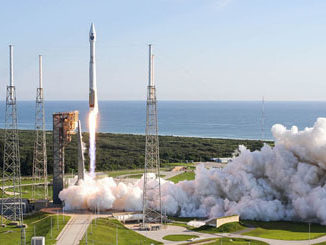
Atlas 5 rocket delivers NASA data router into space for astronauts and satellites
Bulking up NASA’s constellation of tracking stations in the sky that provides critical links between orbiting spacecraft and ground control, a United Launch Alliance Atlas 5 rocket successfully deployed a new communications hub in space today.
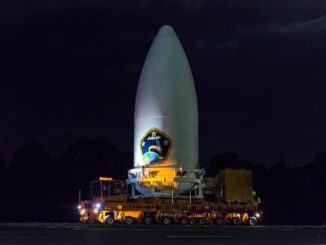
Next Atlas 5 launch delayed by battery failure
The next launch of United Launch Alliance’s Atlas 5 rocket with the U.S. Air Force’s fifth Advanced Extremely High Frequency communications satellite, previously scheduled for Thursday, has been delayed to no earlier than July 12 to replace a failed battery on the vehicle.
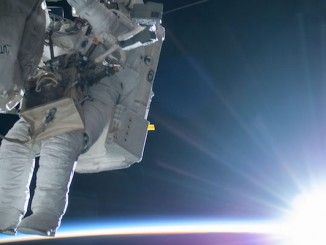
Photos from this weekend’s spacewalk
Check out photos taken by two astronauts who ventured outside the International Space Station on Saturday, running more than 300 feet of wiring that will eventually be connected to new docking ports to receive commercial spaceships built by Boeing and SpaceX.
© 1999-2024 Spaceflight Now Inc
share this!
April 22, 2024
This article has been reviewed according to Science X's editorial process and policies . Editors have highlighted the following attributes while ensuring the content's credibility:
fact-checked
reputable news agency
European Space Agency adds 5 new astronauts in only fourth class since 1978. Over 20,000 applied
by DAVID McHUGH
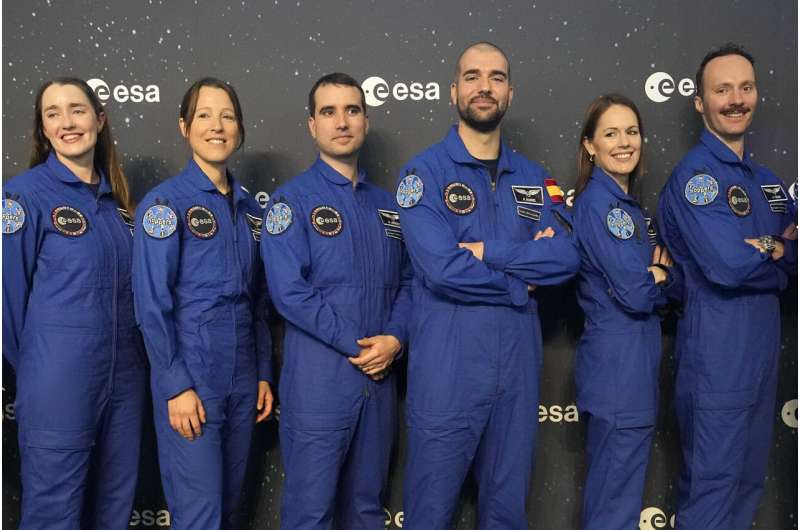
For the past year, five fit, academically superior men and women have been spun in centrifuges, submerged for hours, deprived temporarily of oxygen, taught to camp in the snow, and schooled in physiology, anatomy, astronomy, meteorology, robotics, and Russian.
On Monday, the five Europeans and an Australian graduated from basic training with a new title: astronaut.
At a ceremony in Cologne, Germany, ESA added the five newcomers to its astronaut corps eligible for missions to the International Space Station, bringing the total to 11.
ESA has negotiated with NASA for three places on future Artemis moon missions, although those places will likely go to the more senior astronauts, according to ESA Director General Josef Aschbacher. The agency is also supplying the service module for the Orion crew capsule. ESA relies on NASA and others to get its astronauts to space.
It is only the fourth astronaut class since 1978 for the 22-country agency, chosen from among 22,500 applicants. Another twelve were selected as reservists, but were not sent to basic training. Not surprisingly, the five have resumes studded with advanced scientific and medical degrees, military training , experience flying planes, helicopters, gliders and balloons, and "leisure" activities like rowing, scuba diving, hiking, skydiving, cycling, sailing, and kayaking,
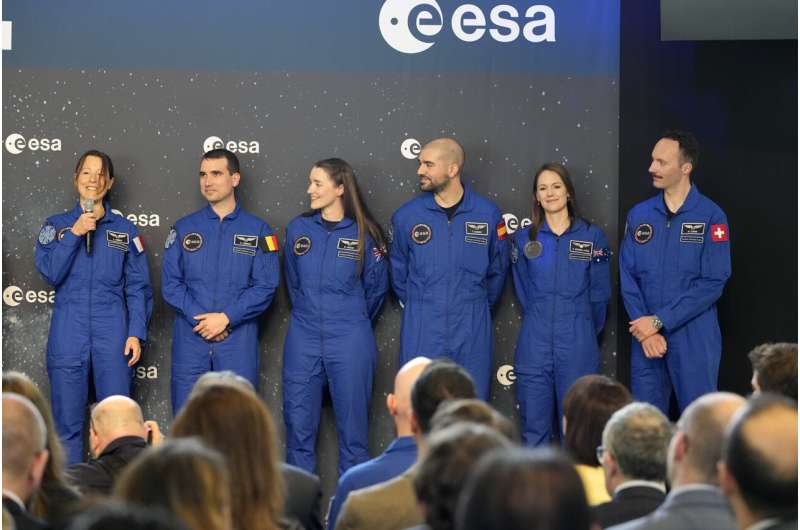
The group formed "a very good team" devoid of personal rivalry, said Aschbacher. "I told them, one of you will fly first and one will fly last, and they accepted that of course, but from the heart, not just lip service ... the team spirit is very pronounced."
Sophie Adenot, a French air force helicopter test pilot, said the group was "a fantastic crew and a fantastic team." The moment that struck her the most was leaving the airlock for underwater space walk simulation when the instructor said, "Welcome to space."
"And for me it was mind-blowing, I had goosebumps. ... In a few years it is going to be me in space, not in the water with safety divers."
When she was a girl dreaming of space travel, "I couldn't count the number of people who told me, this dream will never come true. You have unrealistic dreams, and it will never happen. ... Listen to yourself and don't listen to people who don't believe in you."
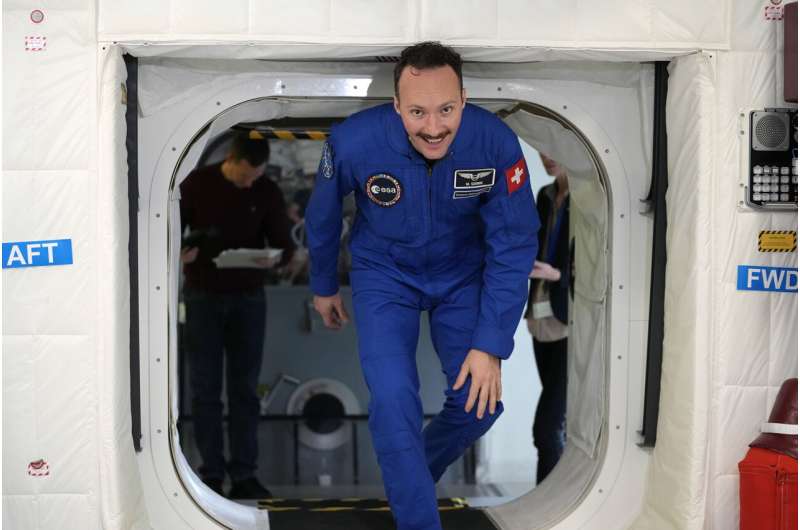
In addition to Adenot, the ESA class consists of:
—Pablo Alvarez Fernandez, a Spanish aeronautical engineer who has worked on the Rosalind Franklin Mars rover intended for a joint mission with Russia that was suspended after the invasion of Ukraine;
—Rosemary Coogan, a British astronomer who has researched radiation emissions from black holes;
—Raphael Liegeois, a Belgian biomedical engineer and neuroscientist who has researched degenerative diseases of the nervous system, and also flies hot-air balloons and gliders;
—Marco Alain Sieber, a Swiss emergency physician who achieved sergeant rank as a paratrooper during his service with the Swiss army.
The group was joined by Katherine Bennell-Pegg from Australia, who underwent training under a cooperation agreement between Australia and ESA. She remains an employee of the Australian Space Agency. It's up to the Australian agency to find a way for her to travel in space.
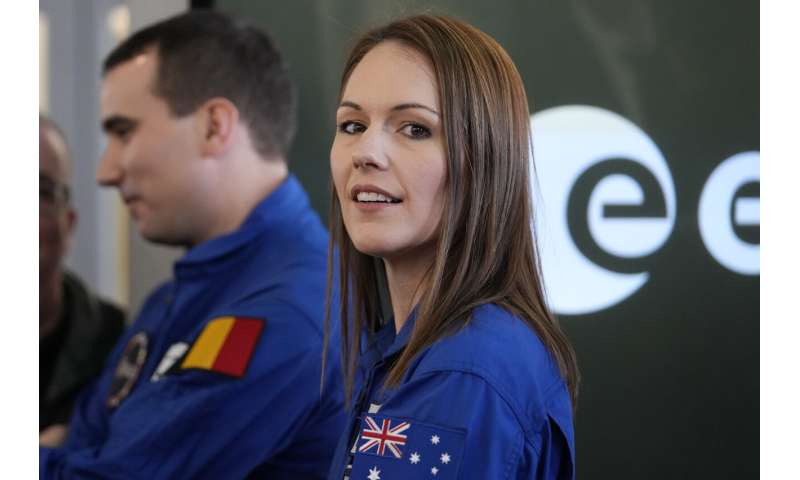
Their yearlong basic training included preparation for the hostile environment encountered in space. They were exposed to multiple times the force of gravity in a centrifuge, and spent hours underwater using scuba gear to float around mockups of space station modules to simulate working in zero gravity.
They learned how to recognize symptoms of hypoxia, or lack of oxygen, by experiencing it themselves in a low-pressure chamber. Survival training included dealing with potential splashdown in the ocean and staying warm in winter while waiting to be recovered in case a landing goes off course. On top of that came academic work on scientific topics and learning about the space station's modules and equipment.
Intensive Russian language is still part of the program, even though ESA has suspended work with Russia except for the space station, where one of the working languages is Russian.
© 2024 The Associated Press. All rights reserved. This material may not be published, broadcast, rewritten or redistributed without permission.
Explore further
Feedback to editors

Optical barcodes expand range of high-resolution sensor
17 hours ago

Ridesourcing platforms thrive on socio-economic inequality, say researchers
18 hours ago

Did Vesuvius bury the home of the first Roman emperor?

Florida dolphin found with highly pathogenic avian flu: Report

A new way to study and help prevent landslides

New algorithm cuts through 'noisy' data to better predict tipping points

Researchers reconstruct landscapes that greeted the first humans in Australia around 65,000 years ago
19 hours ago

High-precision blood glucose level prediction achieved by few-molecule reservoir computing

Enhancing memory technology: Multiferroic nanodots for low-power magnetic storage

Researchers advance detection of gravitational waves to study collisions of neutron stars and black holes
Relevant physicsforums posts, need help simplifying standard error formula for redshift, our beautiful universe - photos and videos.
Apr 25, 2024
Solar Activity and Space Weather Update thread
'devil' comet visible tonight 21.04.24, waves in space, documenting the setup of my new telescope.
Apr 24, 2024
More from Astronomy and Astrophysics
Related Stories

Prep in the pool for Europe's next astronauts
May 4, 2023

Astronauts arrive at International Space Station for swap
Mar 5, 2024

First Arab woman to graduate NASA training shoots for the Moon
Mar 7, 2024

NASA bumps astronaut off space station flight in rare move
Jan 19, 2018

UAE says its first astronaut going into space in September
Feb 25, 2019

ESA fully cuts Mars mission ties with Russia, angering Moscow
Jul 13, 2022
Recommended for you

Japan's moon lander wasn't built to survive a weekslong lunar night. It's still going after 3

NASA's Voyager 1 resumes sending engineering updates to Earth
Apr 22, 2024

Simulated microgravity affects sleep and physiological rhythms, study finds

'Tube map' around planets and moons made possible by knot theory
Apr 17, 2024

NASA's Ingenuity Mars helicopter team says goodbye—for now

NASA confirms mystery object that crashed through roof of Florida home came from space station
Apr 16, 2024
Let us know if there is a problem with our content
Use this form if you have come across a typo, inaccuracy or would like to send an edit request for the content on this page. For general inquiries, please use our contact form . For general feedback, use the public comments section below (please adhere to guidelines ).
Please select the most appropriate category to facilitate processing of your request
Thank you for taking time to provide your feedback to the editors.
Your feedback is important to us. However, we do not guarantee individual replies due to the high volume of messages.
E-mail the story
Your email address is used only to let the recipient know who sent the email. Neither your address nor the recipient's address will be used for any other purpose. The information you enter will appear in your e-mail message and is not retained by Phys.org in any form.
Newsletter sign up
Get weekly and/or daily updates delivered to your inbox. You can unsubscribe at any time and we'll never share your details to third parties.
More information Privacy policy
Donate and enjoy an ad-free experience
We keep our content available to everyone. Consider supporting Science X's mission by getting a premium account.
E-mail newsletter
Does space travel make people age more slowly?
- 2 min. read ▪ Published February 22, 2021
- Share on LinkedIn
- Share on Facebook
- Share on X (Twitter)
Scientists have recently observed for the first time that, on an epigenetic level, astronauts age more slowly during long-term simulated space travel than they would have if their feet had been planted on Planet Earth.
“Many of us assume that being exposed to radiation or other harm in space would be reflected by increased aging. But there’s also been a lot of research that has shown the opposite,” said Jamaji C. Nawanaji-Enwerem, Berkeley Public Health postdoctoral fellow and first author of a study published in Cell Reports in November 2020. The study reviewed data from the six participants of the Mars-500 mission, a simulated space travel and residence experiment launched by the European Space Agency in 2010.
In space, people usually experience environmental stressors like microgravity, cosmic radiation, and social isolation, which can all impact aging. Studies on long-term space travel often measure aging biomarkers such as telomere length and heartbeat rates, not epigenetic aging. To fill in the gap, Nawanaji-Enwerem and his team members took the novel step to look at epigenetic biomarkers such as DNAmPhenoAge, a robust marker of disease risk, and DNAmGrimAGE, a predictor of mortality risk.
The findings show that space mission duration will lead to a slower aging process, which looks like a good thing. “But if the mission goes on for longer, it can actually be a bad thing for you,” said Nawanaji-Enwerem.
“It also informs future research in terms of what biomarkers of aging are important to measure,” said Andres Cardenas, study co-author and assistant professor of Environmental Health Sciences at Berkeley Public Health.
During the Mars-500 experiment, six astronaut crews stayed in an isolated space and lived as if they were on Mars for 520 days. Cosmic radiation and microgravity were not replicated in the experiment, so the slower aging process found by scientists is caused by social isolation and other relative effects.
Although it’s not clear why space travel would lead to slower epigenetic aging, the findings will be valuable for understanding the health implications for future space travel.
“It’s not if, but when, we’re going to transition to space living,” said Cardenas.
More in category “Research Highlights”:
Surgery in a hospital doesn’t necessarily lead to better outcomes than surgery in a surgical center, collaboration is key to pioneering research with youth experiencing homelessness, exposure to wildfire smoke during pregnancy increases risk of preterm birth, rosemarie de la rosa tracks how childhood exposure to environmental pollutants and social stress has lifelong affect.
- Election 2024
- Entertainment
- Newsletters
- Photography
- Personal Finance
- AP Investigations
- AP Buyline Personal Finance
- AP Buyline Shopping
- Press Releases
- Israel-Hamas War
- Russia-Ukraine War
- Global elections
- Asia Pacific
- Latin America
- Middle East
- Election Results
- Delegate Tracker
- AP & Elections
- Auto Racing
- 2024 Paris Olympic Games
- Movie reviews
- Book reviews
- Personal finance
- Financial Markets
- Business Highlights
- Financial wellness
- Artificial Intelligence
- Social Media
China launches 3-member crew to its space station as it seeks to put astronauts on the moon by 2030
A Long March rocket carrying a crew of Chinese astronauts in a Shenzhou-18 spaceship lifts off at the Jiuquan Satellite Launch Center in northwestern China, Thursday, April 25, 2024. (AP Photo/Andy Wong)
Chinese astronauts for the Shenzhou-18 mission, from left, Li Guangsu, Ye Guangfu and Li Cong wave as they attend a send-off ceremony for their manned space mission at the Jiuquan Satellite Launch Center in northwestern China, Thursday, April 25, 2024. (AP Photo/Andy Wong)
Chinese astronaut for the Shenzhou-18 mission Ye Guangfu gestures from a vehicle during a send-off ceremony for their manned space mission at the Jiuquan Satellite Launch Center in northwestern China, Thursday, April 25, 2024. (AP Photo/Andy Wong)
Chinese astronaut for the Shenzhou-18 mission Ye Guangfu waves from a vehicle during a send-off ceremony for their manned space mission at the Jiuquan Satellite Launch Center in northwestern China, Thursday, April 25, 2024. (AP Photo/Andy Wong)
Chinese astronauts for the Shenzhou-18 mission, from left, Li Guangsu, Ye Guangfu and Li Cong walk out from a building during a send-off ceremony for their manned space mission at the Jiuquan Satellite Launch Center in northwestern China, Thursday, April 25, 2024. (AP Photo/Andy Wong)
Chinese astronauts for the Shenzhou-18 mission, from left, Li Guangsu, Li Cong and Ye Guangfu wave to spectators as they attend a send-off ceremony for their manned space mission at the Jiuquan Satellite Launch Center in northwestern China, Thursday, April 25, 2024. (AP Photo/Andy Wong)
- Copy Link copied
JIUQUAN SATELLITE LAUNCH CENTER, China (AP) — China launched a three-member crew to its orbiting space station on Thursday as part of its ambitious program that aims to put astronauts on the moon by 2030 .
The Shenzhou-18 spacecraft lifted off from the Jiuquan Satellite Launch Center on the edge of the Gobi Desert in northwestern China atop a Long March 2-F rocket at 8:59 p.m. (1259 GMT).
The spacecraft’s three-member crew will relieve the Shenzhou-17 team, which has been staffing China’s Tiangong space station since last October.
The China Manned Space Agency, or CMSA, held a send-off ceremony — complete with flag-waving children and patriotic music — for the Shenzhou-18 crew earlier on Thursday, as the three astronauts prepared to enter the spacecraft.
The trio is made of Commander Ye Guangfu, 43, a veteran astronaut who took part in the Shenzhou-13 mission in 2021, and fighter pilots Li Cong, 34, and Li Guangsu, 36, who are spaceflight rookies.
They are expected to reach the space station about six-and-a-half hours after liftoff.
China built its own space station after being excluded from the International Space Station, largely because of U.S. concerns over the Chinese military’s involvement in the program. This year, the Chinese station is slated for two cargo spacecraft missions and two manned spaceflight missions.
The Shenzhou-18 crew will spend about six months on the space station. They will conduct scientific tests, install space debris protection equipment on the station, carry out payload experiments, and popularize science education, among other things, according to Lin Xiqiang, deputy director of the CMSA.
Lin also said China was working toward eventually offering access to its space station to foreign astronauts and space tourists .
“We will accelerate the research and promotion of the participation of foreign astronauts and space tourists on flights on China’s space station,” he said in a press conference Wednesday.
The country is planning a mission to bring back samples from Mars around 2030 and three lunar probe missions over the next four years. It also wants to put astronauts on the moon by 2030.
China conducted its first crewed space mission in 2003, becoming the third country after the former Soviet Union and the U.S. to put a person into space using its own resources.
The U.S. space program is believed to still hold a significant edge over China’s due to its spending, supply chains and capabilities. However, China has broken out in some areas, bringing samples back from the lunar surface for the first time in decades and landing a rover on the less explored far side of the moon.
The U.S. aims to put a crew back on the lunar surface by the end of 2025 as part of a renewed commitment to crewed missions, aided by private sector players such as SpaceX and Blue Origin.
Mistreanu reported from Kaohsiung, Taiwan.

Suggested Searches
- Climate Change
- Expedition 64
- Mars perseverance
- SpaceX Crew-2
- International Space Station
- View All Topics A-Z
Humans in Space
Earth & climate, the solar system, the universe, aeronautics, learning resources, news & events.

NASA-Led Study Provides New Global Accounting of Earth’s Rivers

NASA’s Hubble Pauses Science Due to Gyro Issue

NASA’s Optical Comms Demo Transmits Data Over 140 Million Miles
- Search All NASA Missions
- A to Z List of Missions
- Upcoming Launches and Landings
- Spaceships and Rockets
- Communicating with Missions
- James Webb Space Telescope
- Hubble Space Telescope
- Why Go to Space
- Astronauts Home
- Commercial Space
- Destinations
- Living in Space
- Explore Earth Science
- Earth, Our Planet
- Earth Science in Action
- Earth Multimedia
- Earth Science Researchers
- Pluto & Dwarf Planets
- Asteroids, Comets & Meteors
- The Kuiper Belt
- The Oort Cloud
- Skywatching
- The Search for Life in the Universe
- Black Holes
- The Big Bang
- Dark Energy & Dark Matter
- Earth Science
- Planetary Science
- Astrophysics & Space Science
- The Sun & Heliophysics
- Biological & Physical Sciences
- Lunar Science
- Citizen Science
- Astromaterials
- Aeronautics Research
- Human Space Travel Research
- Science in the Air
- NASA Aircraft
- Flight Innovation
- Supersonic Flight
- Air Traffic Solutions
- Green Aviation Tech
- Drones & You
- Technology Transfer & Spinoffs
- Space Travel Technology
- Technology Living in Space
- Manufacturing and Materials
- Science Instruments
- For Kids and Students
- For Educators
- For Colleges and Universities
- For Professionals
- Science for Everyone
- Requests for Exhibits, Artifacts, or Speakers
- STEM Engagement at NASA
- NASA's Impacts
- Centers and Facilities
- Directorates
- Organizations
- People of NASA
- Internships
- Our History
- Doing Business with NASA
- Get Involved
- Aeronáutica
- Ciencias Terrestres
- Sistema Solar
- All NASA News
- Video Series on NASA+
- Newsletters
- Social Media
- Media Resources
- Upcoming Launches & Landings
- Virtual Events
- Sounds and Ringtones
- Interactives
- STEM Multimedia

Correction and Clarification of C.26 Rapid Mission Design Studies for Mars Sample Return

NASA’s Commercial Partners Deliver Cargo, Crew for Station Science

NASA Shares Lessons of Human Systems Integration with Industry

Work Underway on Large Cargo Landers for NASA’s Artemis Moon Missions

NASA’s ORCA, AirHARP Projects Paved Way for PACE to Reach Space

Amendment 11: Physical Oceanography not solicited in ROSES-2024

Why is Methane Seeping on Mars? NASA Scientists Have New Ideas

Mars Science Laboratory: Curiosity Rover

Hubble Spots a Magnificent Barred Galaxy

NASA’s Chandra Releases Doubleheader of Blockbuster Hits

Explore the Universe with the First E-Book from NASA’s Fermi

NASA Grant Brings Students at Underserved Institutions to the Stars

NASA Photographer Honored for Thrilling Inverted In-Flight Image

NASA’s Ingenuity Mars Helicopter Team Says Goodbye … for Now

NASA Langley Team to Study Weather During Eclipse Using Uncrewed Vehicles

NASA Data Helps Beavers Build Back Streams

NASA’s Near Space Network Enables PACE Climate Mission to ‘Phone Home’

Washington State High Schooler Wins 2024 NASA Student Art Contest

NASA STEM Artemis Moon Trees

Kiyun Kim: From Intern to Accessibility Advocate

Diez maneras en que los estudiantes pueden prepararse para ser astronautas

Astronauta de la NASA Marcos Berríos

Resultados científicos revolucionarios en la estación espacial de 2023
Nasa’s journey to mars.

NASA is developing the capabilities needed to send humans to an asteroid by 2025 and Mars in the 2030s – goals outlined in the bipartisan NASA Authorization Act of 2010 and in the U.S. National Space Policy, also issued in 2010.
Mars is a rich destination for scientific discovery and robotic and human exploration as we expand our presence into the solar system. Its formation and evolution are comparable to Earth, helping us learn more about our own planet’s history and future. Mars had conditions suitable for life in its past. Future exploration could uncover evidence of life, answering one of the fundamental mysteries of the cosmos: Does life exist beyond Earth?
While robotic explorers have studied Mars for more than 40 years, NASA’s path for the human exploration of Mars begins in low-Earth orbit aboard the International Space Station. Astronauts on the orbiting laboratory are helping us prove many of the technologies and communications systems needed for human missions to deep space, including Mars. The space station also advances our understanding of how the body changes in space and how to protect astronaut health.
Our next step is deep space, where NASA will send a robotic mission to capture and redirect an asteroid to orbit the moon. Astronauts aboard the Orion spacecraft will explore the asteroid in the 2020s, returning to Earth with samples. This experience in human spaceflight beyond low-Earth orbit will help NASA test new systems and capabilities, such as Solar Electric Propulsion, which we’ll need to send cargo as part of human missions to Mars. Beginning in FY 2018, NASA’s powerful Space Launch System rocket will enable these “proving ground” missions to test new capabilities. Human missions to Mars will rely on Orion and an evolved version of SLS that will be the most powerful launch vehicle ever flown.
A fleet of robotic spacecraft and rovers already are on and around Mars, dramatically increasing our knowledge about the Red Planet and paving the way for future human explorers. The Mars Science Laboratory Curiosity rover measured radiation on the way to Mars and is sending back radiation data from the surface. This data will help us plan how to protect the astronauts who will explore Mars. Future missions like the Mars 2020 rover, seeking signs of past life, also will demonstrate new technologies that could help astronauts survive on Mars.
Engineers and scientists around the country are working hard to develop the technologies astronauts will use to one day live and work on Mars, and safely return home from the next giant leap for humanity. NASA also is a leader in a Global Exploration Roadmap, working with international partners and the U.S. commercial space industry on a coordinated expansion of human presence into the solar system, with human missions to the surface of Mars as the driving goal. Follow our progress at www.nasa.gov/exploration and www.nasa.gov/mars .
> NASA’s Orion Flight Test and the Journey to Mars
Image Credit: NASA
NASA scientists consider the health risks of space travel

Humans aren't built to live in space, and being there can pose serious health risks . For space administrations like NASA, a major goal is to identify these risks to hopefully help lessen them.
That was a major theme during NASA’s Spaceflight for Everybody Virtual Symposium in November, a virtual symposium dedicated to discussing current knowledge and research efforts around the impact of spaceflight on human health. During a panel discussion titled “Human Health Risks in the Development of Future Programs” on Nov. 9, NASA scientists discussed these risks and how they are using existing knowledge to plan future missions.
Each panelist emphasized that the health risks presented by space travel are complex and multifaceted and that all types of risks should be considered closely when planning future missions.
Related: Space travel can seriously change your brain
Five types of risk
When discussing the risks presented by living in space and space travel, there are five main types, the scientists outlined in the presentation.
Two types of risk, radiation and altered gravity, come simply from being in space, they said. Research has shown that both can have major negative effects on the body, and even the brain . Others, like isolation and confinement as well as being in a hostile closed environment, encompass risks posed by the living situations that are necessary in space, including risks to both mental and physical health.
Then, there are the risks presented simply by being a long way from Earth. The farther humans get from the Earth, the riskier living in space becomes in almost every way.
Get the Space.com Newsletter
Breaking space news, the latest updates on rocket launches, skywatching events and more!
Everything from fresh food to unexpired medication will be extremely difficult to make accessible with longer journeys farther away. On the International Space Station, astronauts aren’t too far from us, and we can routinely send supplies to the crews in orbit. But a mission to the moon or Mars would pose more problems.
Communication delays would increase, and there would likely be communication blackouts, said Sharmi Watkins, assistant director for exploration in NASA’s Human Health and Performance Directorate who served as a panelist for this discussion. She said it would also take longer to get back to Earth if there was a medical emergency.
"We're not going to measure it in hours, but rather in days, in the case of the moon, and potentially weeks or months, when we start to think about Mars," said Watkins.
Steve Platts, the chief scientist in NASA’s human research program, broke down different levels of risk in space and discussed how NASA uses a "phased approach" when it comes to research on human health. In this approach, initial "phases" include research on the health effects of being in space has also been done in simulated conditions on Earth, from isolation experiments in Antarctica to radiation exposure at Brookhaven National Laboratory in Long Island, New York. Likewise, experiments on the space station will help us to prepare for risk on the moon and Mars — these later phases build on knowledge gained from simulations.
"We do work on Earth, we do work on low earth orbit and then we'll be doing lunar missions, all to help us get to Mars," Platts said.
— Deep-space radiation could cause have big impacts on the brain, mouse experiment shows
— Without gravity, the fluid around an astronaut's brain moves in weird ways
— Long space missions can change astronaut brain structure and function
Still, no matter how much we may prepare on Earth, every space mission comes with risk, so NASA has set health standards to minimize this risk for astronauts.
NASA has over 800 health standards that they’ve developed based on current research. These standards describe everything from how much space astronauts should have in a spacecraft to how much muscle and bone loss an astronaut can experience without being seriously harmed. These standards also include levels of physical fitness and health the astronauts need to meet before going into space. All of NASA’s health standards for astronauts are available online .
A mission can impact astronauts’ health, but it also works the other way — health troubles with astronauts could impact a mission if they aren’t able to perform mission tasks adequately, said Mary Van Baalen, acting director of human system risk management at NASA and the panel’s moderator. She emphasized the complex interplay between these two types of impacts, both of which NASA scientists must keep in mind when planning missions.
"Space travel is an inherently risky endeavor," she said. "And the nature of human risk is complex."
You can watch the full recording of the panel discussion and other talks from the symposium here .
Follow us on Twitter @Spacedotcom or Facebook.
Join our Space Forums to keep talking space on the latest missions, night sky and more! And if you have a news tip, correction or comment, let us know at: [email protected].
Join our Space Forums to keep talking space on the latest missions, night sky and more! And if you have a news tip, correction or comment, let us know at: [email protected].

Rebecca Sohn is a freelance science writer. She writes about a variety of science, health and environmental topics, and is particularly interested in how science impacts people's lives. She has been an intern at CalMatters and STAT, as well as a science fellow at Mashable. Rebecca, a native of the Boston area, studied English literature and minored in music at Skidmore College in Upstate New York and later studied science journalism at New York University.
Building rockets and looking for life on Venus: Q&A with Rocket Lab's Peter Beck
SpaceX launches 23 Starlink satellites, aces 300th rocket landing (photos, video)
Boeing's Starliner spacecraft is 'go' for May 6 astronaut launch
Most Popular
- 2 Russian cosmonauts make quick work of space station spacewalk
- 3 Curiosity rover may be 'burping' methane out of Mars' subsurface
- 4 Boeing Starliner 1st astronaut flight: Live updates
- 5 Lego reveals NASA Artemis rocket, Milky Way galaxy sets coming in May

IMAGES
COMMENTS
Astronauts on a roundtrip mission to Mars will not have the resupply missions to deliver fresh food. NASA is researching food systems to ensure quality, variety, and nutritional values for these long missions. Plant growth on the International Space Station is helping to inform in-space crop management as well.
Oct 08, 2015. RELEASE 15-206. NASA is leading our nation and the world on a journey to Mars, and Thursday the agency released a detailed outline of that plan in its report, "NASA's Journey to Mars: Pioneering Next Steps in Space Exploration.". "NASA is closer to sending American astronauts to Mars than at any point in our history ...
Astronauts bound for Mars will travel about 140 million miles into deep space. Advancements in propulsion capabilities are the key to reaching our destination as quickly and safely as possible. It is too soon to say which propulsion system will take astronauts to Mars, but we know it needs to be nuclear-enabled to reduce travel time.
NASA aims to launch astronauts to Mars by the late 2030s or early 2040s. ... the round-trip travel time would still be about 500 days ... Elizabeth holds a Ph.D. and M.Sc. in Space Studies from ...
Apollo 1 Crew Apollo 1 astronauts "Gus" Grissom (left), Edward White, and Roger Chaffee pose in front of the Saturn 1 launch vehicle at the Kennedy Space Center in Florida. On the morning of ...
NASA's Human Path to Mars. NASA is developing the capabilities needed to send humans to an asteroid by 2025 and Mars in the 2030s - goals outlined in the bipartisan NASA Authorization Act of 2010 and in the U.S. National Space Policy, also issued in 2010. Mars is a rich destination for scientific discovery and robotic and human exploration as ...
Meet Ingenuity Key Facts Launch July 30, 2020, Cape Canaveral Air Force Station, Florida Landed Feb. 18, 2021, Jezero Crater, Mars Length of mission Technology demonstration completed; transitioned to new operations demo phase. Mission completed on Jan. 25, 2024. Tech Specs Mass 3.97 pounds (1.8 kilograms) Weight 4 pounds on Earth (1.81 kilograms on Mars); […]
The key to understanding the past, present or future potential for life on Mars can be found in NASA's four broad, overarching goals for Mars Exploration. This animated artist's concept depicts a scene of water breaking through the rim of Mars' Jezero Crater, which NASA's Perseverance rover is now exploring. Water entered the crater ...
SpaceX's first crewed mission to Mars could be just four years away. Company founder and CEO Elon Musk said on Tuesday (Dec. 1) that he's "highly confident" SpaceX will launch people toward the ...
Travel to Mars The minimum distance between the orbits of Mars and Earth from 2014 to 2061, measured in astronomical units. The energy needed for transfer between planetary orbits, or delta-v, is lowest at intervals fixed by the synodic period.For Earth-Mars trips, the period is every 26 months (2 years, 2 months), so missions are typically planned to coincide with one of these launch periods.
First published on Tue 24 Jan 2023 13.05 EST. Nasa has unveiled plans to test nuclear-powered rockets that would fly astronauts to Mars in ultra-fast time. The agency has partnered with the US ...
The radiation showstopper for Mars exploration. An astronaut on a mission to Mars could receive radiation doses up to 700 times higher than on our planet - a major showstopper for the safe exploration of our Solar System. A team of European experts is working with ESA to protect the health of future crews on their way to the Moon and beyond.
For space explorers, nutrition provides indispensable sustenance, provides potential countermeasures to some of the negative effects of space travel on human physiology, and also presents a ...
The space agency has been helping promote the new film " The Martian ," which hits theaters across the United States today (Oct. 2), as a way to publicize its own plans to send astronauts to the ...
Carson has spent most of her life preparing to go to Mars by attending space camps and advanced preparation programs, building a presence on social media and meeting with former female astronauts.
Orion is the first spacecraft built for astronauts destined for deep space since the storied Apollo missions of the 1960s and 70s. It is designed to go farther than humans have ever traveled, well beyond the moon, pushing the boundaries of spaceflight to new heights. Orion will open the space between Earth and Mars for exploration by astronauts.
Arielle Emmett. April 2017. SpaceWorks, a NASA contractor, has proposed Mars transports and studies of "induced torpor" for their passengers. Some day, astronauts packed into rocketing tin ...
Two veteran NASA astronauts are about to mark an exciting new first in space travel. In the coming days, the much-delayed Boeing Starliner spacecraft will launch with humans on board for the first ...
7 by 7 millimeters. (0.275 inch) NASA's Perseverance puts its robotic arm to work around a rocky outcrop called "Skinner Ridge" in a set of images captured in June and July 2022 by the rover's Mastcam-Z camera system. SHERLOC is mounted on the end of the arm. NASA/JPL-Caltech/ASU/MSSS.
Katherine Bennell-Pegg, Australia's first female astronaut-in-training, at the European Space Agency. ( ABC News Breakfast) After 12 months walking underwater in spacesuits, undertaking simulated ...
NASA astronauts Butch Wilmore (left) and Suni Williams (right) pose by their mission patch following their arrival at NASA's Kennedy Space Center in the run-up to the Starliner Crew Flight Test ...
Over 20,000 applied. European Space Agency adds 5 new astronauts in only fourth class since 1978. Over 20,000 applied. From left, Rosemary Cooga of Britain, Sophie Adenot of France, Raphael ...
Sep 22, 2015. Article. NASA is going to Mars, and here on Earth, the agency's Marshall Space Flight Center in Huntsville, Alabama, is the first stop for building the world's most powerful rocket for the ride - the Space Launch System (SLS). Artist concept of the Block I SLS, which will later evolve to a Block 2 configuration that will ...
Onboard Starliner-1 will be NASA astronauts Scott Tingle and Mike Fincke, and Canadian Space Agency astronaut Joshua Kutryk. Boeing is contracted for six crew rotation missions through the end of ...
Therefore, a light shining from the surface of Mars would take the following amount of time to reach Earth (or vice versa): Closest possible approach: 182 seconds, or 3.03 minutes. Closest ...
The study reviewed data from the six participants of the Mars-500 mission, a simulated space travel and residence experiment. ... During the Mars-500 experiment, six astronaut crews stayed in an isolated space and lived as if they were on Mars for 520 days. Cosmic radiation and microgravity were not replicated in the experiment, so the slower ...
JIUQUAN SATELLITE LAUNCH CENTER, China (AP) — China launched a three-member crew to its orbiting space station on Thursday as part of its ambitious program that aims to put astronauts on the moon by 2030.. The Shenzhou-18 spacecraft lifted off from the Jiuquan Satellite Launch Center on the edge of the Gobi Desert in northwestern China atop a Long March 2-F rocket at 8:59 p.m. (1259 GMT).
NASA. Dec 01, 2014. Image Article. NASA is developing the capabilities needed to send humans to an asteroid by 2025 and Mars in the 2030s - goals outlined in the bipartisan NASA Authorization Act of 2010 and in the U.S. National Space Policy, also issued in 2010. NASA is developing the capabilities needed to send humans to an asteroid by 2025 ...
April 26, 2024. Decades after being poised to become America's first Black astronaut, Ed Dwight will finally gaze upon Earth from space aboard Blue Origin's NS-25 mission at the age of 90.
NASA astronauts Tom Marshburn (at left) and Kayla Barron are seen outside of the Quest airlock at the International Space Station during a spacewalk on Thursday, Dec. 2, 2021. Experts are ...